

TRAVEL to VIETNAM – Tips and Information Guide (2024 Edition)
Everything you need to know about travel to Vietnam in our comprehensive 2024 Vietnam travel guide.
We get it. You’re wondering what the absolute best destination to travel in Southeast Asia is.
You’ve spent hours researching.
Talked to friends.
Scoured the internet for blogs.
Watched YouTube videos.
And you’ve finally realised something.
Without a doubt, Vietnam is the place for you.
And trust us, as a couple that have travelled the world for over a decade, we think you’ve made the right decision.
There’s a reason Vietnam is our all-time favourite country…
From the tropical coral reefs of Nha Trang to the northern mountains of Sa Pa, travel to Vietnam is one of the most adventurous yet culturally empowering experiences you can have.
One moment you will find yourself haggling for banh mi deep within Saigon and later that day you could be watching a breathtaking sunset from the Mekong Delta.
Vietnam is more than a country. It’s an experience.
You’ll find yourself immersed among street food vendors cooking up exotic cuisines such as pho along streets with stores selling suits and ties.
Or you’ll be cruising the waters of Halong Bay while monkeys jump from island to island.
Or you might find yourself trekking to the highest peak in Vietnam, Fansipan soaring to over 3,100 metres!
Not into adventure activities? Homestays are the perfect way to spend your day as the monsoon rains fall across the endless snaking rivers of the Mekong.
Vietnamese hospitality is unrivalled and is something that you should experience once in your life, so what are you waiting for? Say good morning Vietnam! And go get lost!
So we’ve convinced you to travel to Vietnam? Awesome!
Now check out the basic information about the country in our Vietnam travel guide.
25 BEST Things to Do in Hue, Vietnam (2024 Edition)
The perfect vietnam itinerary for 1, 2, or 3 weeks, canyoning in dalat – what it is really like, travelling in vietnam: at a glance.
Here are the basics about travel to Vietnam.
OTHER MAIN CITIES:
Ho Chi Minh City (Saigon), Da Nang, Hue
Vietnamese Dong (see current exchange rate ). 1USD approximately = 23,000 dong. 1 beer = 30,000 dong ($1.30USD)
ENTRY / VISA:
Travellers from most countries in the world are required to have visas. In most cases these can be obtained upon arrival for either 3 or 6 months. For information about your specific visa requirements click here.
Vietnam is fairly safe for travellers. Petty theft tends to be the biggest concern and always be on the lookout for taxi scams. Also of concern are minor auto/motorbike accidents. This is one place it’s great to have travel insurance when visiting.
ELECTRICITY:
220 Volt at 50Hz. Power plugs – Type A: 2 vertical pins, Type C: 2 round pins, Type F (also known as Schuko plug): 2 round pins (Be sure to get your universal travel adapter before you leave)
TRANSPORTATION:
Intercity travel is possible by plane, train and bus. Within cities, towns and villages you can expect to get around on bicycle rickshaws, motorbike taxes, taxis and bus.
Don’t Forget to Pack the Most Important Thing: Travel Insurance !
TOP 5 TRAVEL EXPERIENCES IN VIETNAM
With so much to see and do in Vietnam, it really is hard to pick the top experiences.
However, we think that to truly appreciate Vietnam you need to plan to do these 5 activities during your visit.
Take the Overnight Train from Hanoi to Sapa
Said to be one of the most eye-opening train rides in the world, as you pass through lush forests, rice paddy fields on your way to the Vietnamese – Chinese border.
Book your train ticket here .
Hike Through the Rice Terraces of Sapa
Explore the area with the local hill tribes. Stay with them during your trek. And enjoy the beautiful terraced countryside for which Sapa is known.
Here’s our full post about trekking in Sapa .
Cruise the Mekong Delta
Probably one of the ‘must do’s of Vietnam.’ The Mekong Delta is full of hidden gems including floating markets, friendly locals and late afternoon storms.
Book a multiday tour of the Mekong Delta
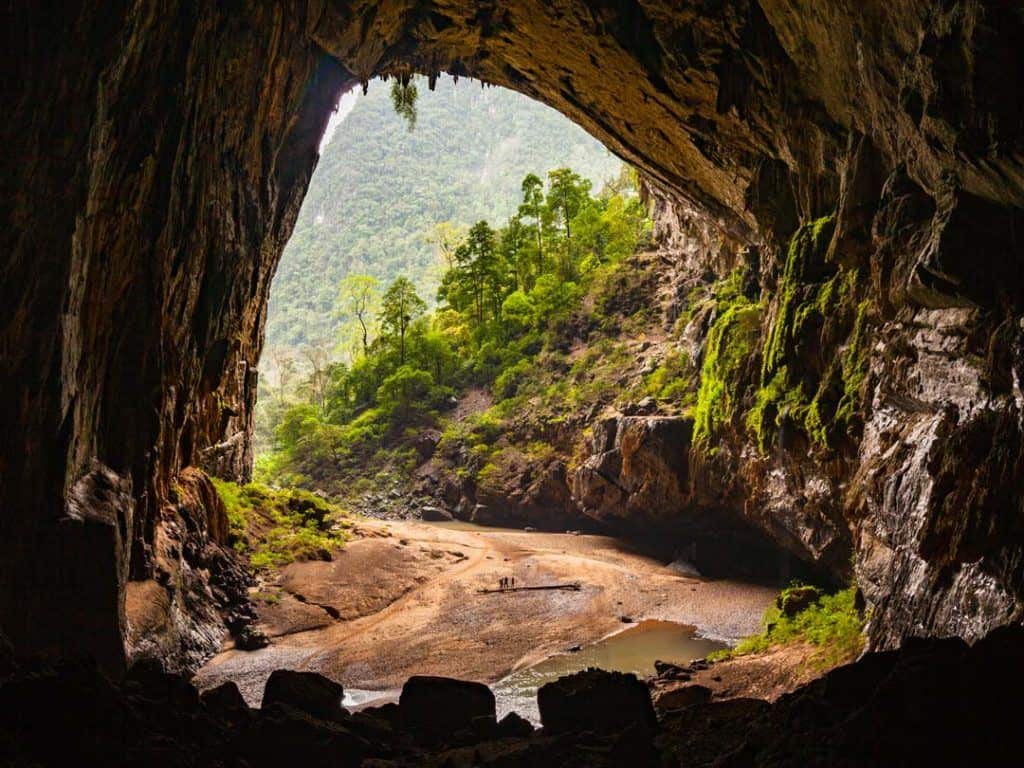
Go Caving in Phong Nha
Caves there can fit a 747 plane in it. They are massive and spectacular. This is an adventure you will never forget.
Book your Phong Nha cave tour
Ride a Motorcycle
Yes, that’s right! Hiring a motorcycle or scooter is a must. But maybe do it out on the country roads. Opt for the famous ride to the mountain village of Dalat, or pretty much anywhere throughout the country.
Read about how to ride through the famous Hai Van Pass
Other Things to do in Vietnam
Learn to cook Vietnamese food . Eating delicious Vietnamese food is one thing. Eating it after you’ve learned to prepare it is another!
Scuba dive in Nha Trang. You may not think of Vietnam as a big scuba location, but there is some great diving to be had in Nha Trang.
Go canyoning in Dalat. Rappel, slide, jump and climb your way through canyons in this gorgeous place!
Explore the Marble Mountains in Da Nang. These beautiful mountains have been mined for marble for years and have incredible views and temples to visit along the way.
Sandboard down the sand dunes in Mui Ne. It’s like snowboarding, but down massive sand dunes! Enjoy this rush!
Visit the Giants Causeway in Ghan Da Dia. Half the world away from the Giant’s Causeway in Northern Ireland, be amazed at this unique geologic structure .
Visit the Cu Chi Tunnels outside of Ho Chi Minh City. No trip to HCMC is complete without touring these historic tunnels that were used during the war.
Conquer the Hoi An Pass on a motorbike . This is known as one of the most beautiful sections of highway in the world. Enjoy!
Explore the world’s biggest cave . We have a special connection with Hang Son Doong as it is where we were engaged. Make your own special moment too!
Climb the highest mountain in Indochina in Sapa. Fansipan is over 3,000m above sea level and offers incredible views along the way to the top!
BE SURE TO CHECK OUT THESE OTHER AMAZING THINGS TO DO IN VIETNAM
READ MORE...
A First-Timer’s Guide to Trekking in Sapa
The 11 Best Things to Do in Da Nang, Vietnam (2024 Guide)
33 BEST Things to Do in Vietnam (Epic 2024 Guide)
10 BEST Things to Do in Ninh Binh, Vietnam (2024 Guide)
Scuba Diving In Nha Trang – Is It Worth It?
BEST PLACES TO VISIT IN VIETNAM
There are plenty of amazing places to visit in Vietnam. Depending on your interests, trip duration and time of year you will find plenty of things to do during any length of stay.
When slurping a bowl of pho in a local market or exploring an ancient temple, it’s easy to feel like you’ve stepped into a time machine in Ho Chi Minh City.
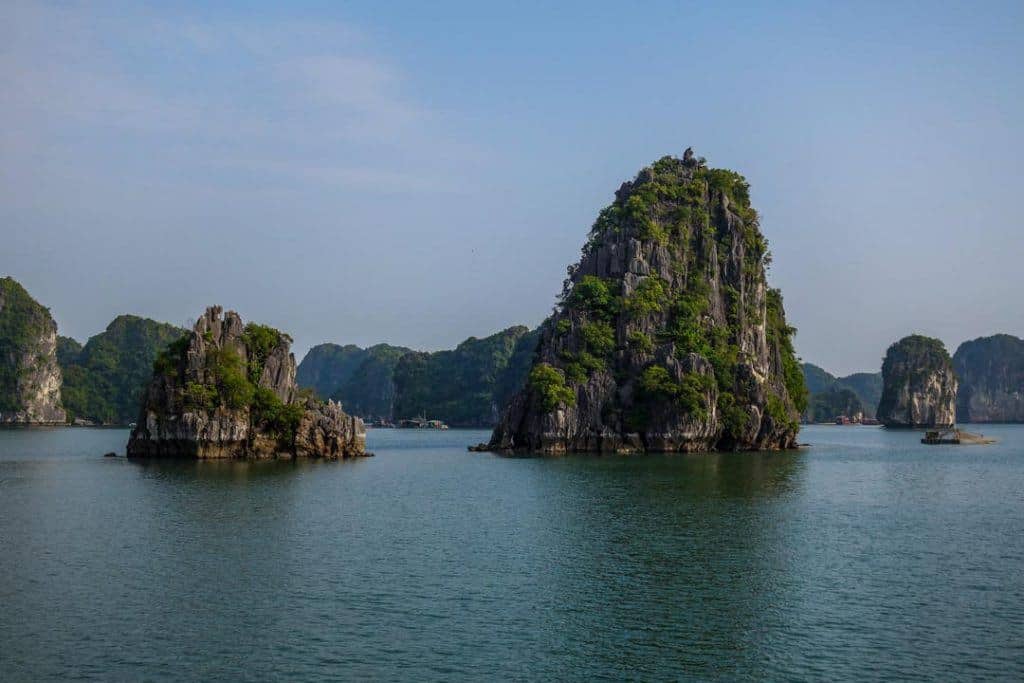
A collection of over 3,000 limestone islands providing endless kayaking opportunities. Take the time to relax aboard a boat or venture to Cat Ba National Park for mystical waterfalls!
Book your tour of Halong Bay
The capital of Vietnam is also one of the most ancient capitals in the world. The history of Hanoi is rich, devastating and full of legends. This mystical city is also known for its cuisine, silk, buzzing nightlife as well as cultural diversity.
Plan your 3-day Hanoi itinerary
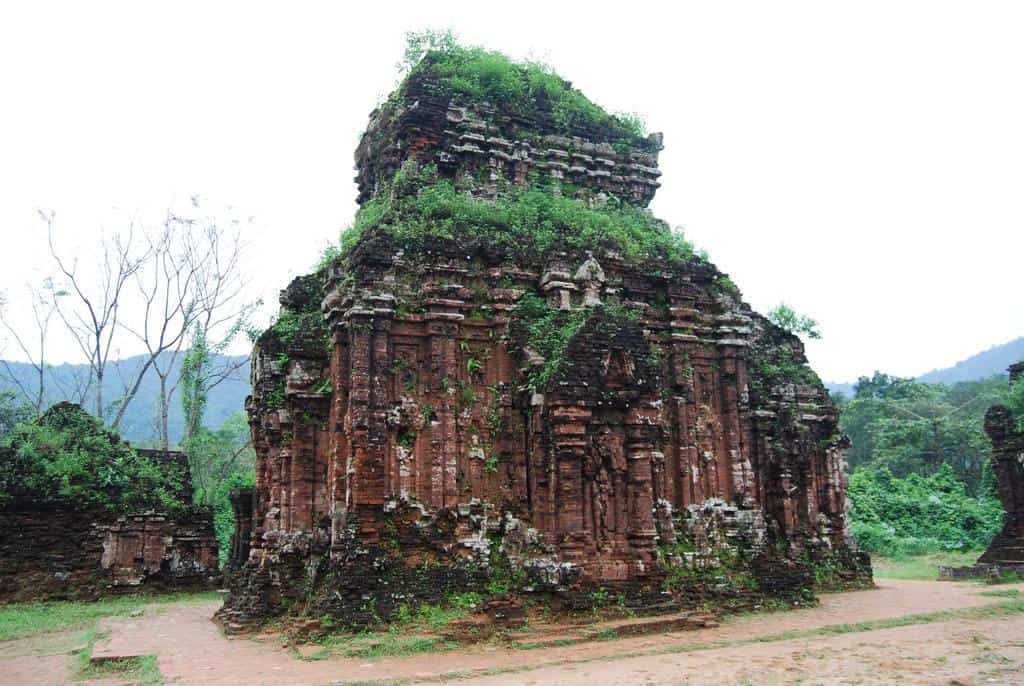
My Son Temple
Ancient temples dating back 1,000 years give a culture understanding into Vietnam’s past all while showing the scars of the war.
Book an early morning tour of My Son
For more information on specific things to do in the top places to visit in Vietnam, reference our following city travel guides:
Ho Chi Minh City:
* Ho Chi Minh City Itinerary * Day Trips from Ho Chi Minh City
* Hanoi Itinerary * Day Trips From Hanoi
Dalat Hoi An
Da Nang Hue Ninh Binh
BE SURE TO CHECK OUT THESE OTHER AWESOME PLACES TO VISIT IN VIETNAM.
BEST VIETNAM TRAVEL ITINERARY
We’ve put together a few Vietnam itineraries that are sure to leave you wanting for nothing at the end of your visit.
There are so many amazing things to do in Vietnam that planning an itinerary for your travel can be a little overwhelming.
Even though the country is one united nation, you can think of it geographically as being divided into a northern and southern region.
So depending on how much time you have, you may want to explore the northern region, southern region or the entire country.
Of course, no one-size-fits-all plan will suffice. But if we were to head back to Vietnam these are the top places and things that we would want to do!
1-Week Vietnam Travel Itinerary Highlights
Most people spend at least a month went hey travel to Vietnam. But if you had just one week, or were willing to split a few weeks between the northern and southern regions, this is how we’d spend our time!
Northern Vietnam
- Fly into Hanoi
- 2 nights – Hanoi
- 2 nights – Halong Bay or Bai Tu Long Bay
- 2 nights – Sapa
- Alternative to Sapa – 2 night in Hue
- Fly out of Hanoi
Central Vietnam
- Fly into Hanoi or HCMC. Get a local flight down to Dong Hoi
- 3 nights – Phong Nha
- 2 nights – Hue
- 2-3 nights – Hoi An
- Fly out of Da Nang to either Hanoi or HCMC to leave
South Vietnam
- Fly into Ho Chi Minh City
- 2 nights – Ho Chi Minh City
- 2 nights – Mekong Delta
- 2 nights – Dalat
- 1 night – Mui Ne
- Fly out of Ho Chi Minh City
READ MORE: Check out this post for more details on our Vietnam travel itinerary .
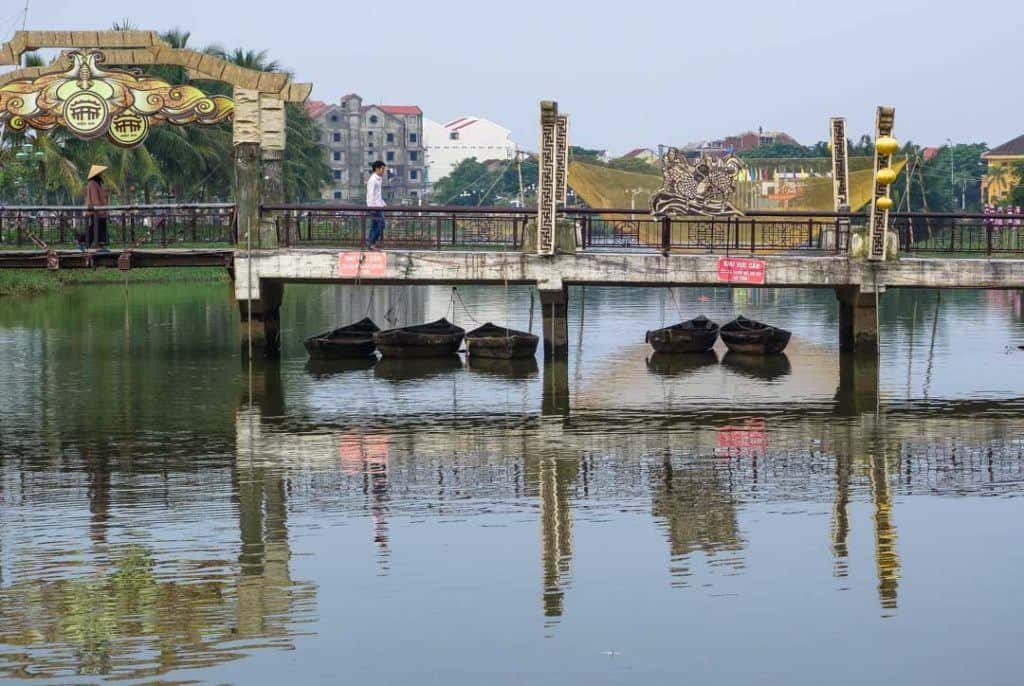
VIETNAM TRIP PLANNING
Best time to visit vietnam.
The best time to travel to Vietnam really depends on what you are looking for in terms of weather, scenery and budget.
Peak season occurs from mid-December through to February. But expect prices to double during this time. The low season is perfect for those on a budget.
- Low Season – April to June, September to November
- Shoulder Season – December to March
- High Season – July & August
Northern Vietnam – The best months to travel Northern Vietnam are April to May or September to October. There are mostly sunny days and the rain has stopped.
The weather gets really cold from December to March and is not suited for hiking or sailing a junk boat in Halong Bay that time of year.
Central Vietnam – The best months for travel to Central Vietnam are January to June. There are heavy rains in October and November and the really hot months are from May to August.
Southern Vietnam – The best months to explore Southern Vietnam are January to April where conditions are beautiful.
You really can travel the south at any time of the year. Just note that from May to November there are afternoon downpours.
VIETNAM TRAVEL BUDGET GUIDELINE
Vietnam is a cheap country to travel if you want it to be, this all depends on what your budget is like. Our advice is always over-budget when making plans, and if you come home with money, it can go towards your next trip. All prices below are in USD per day.
Budgeting Tips
To make your money go further here are a few tips:
- Eat street food as often as possible. You can usually fill up for $1-2USD.
- Travel in groups when possible. Staying in hostels will lead to making friends. And with friends, you can split transportation costs and barter on other expenses.
- Negotiate taxi fares before taking the ride. Vietnamese taxi drivers are notorious for flexible fares that tend to fall int heir favor. Don’t be afraid of a little negotiation.
- Drink bia hoi . Sure it’s not the more delightful beer. But it is shipped in fresh each day, it’s cheap and it’s what the local drink.
- Take in the sights for free. Do a little research and walk the streets on your own. You’ll also find there are a number of free tours and other opportunities if you ask around.
- Sleep on overnight busses for longer trips. Combine the transportation and accommodation line items of your budget and save a few dollars.
But there are a few things you should know about the different budgets at which you can choose to travel.
Note: Budgets shown as Single Traveller / Couples per day.
Budget Traveller ($35 Single / $50 Couples)
If you are on a backpacker budget and planning on staying in dorm rooms, getting street food, drinking a few nights of the week, I would budget for about $35 a day.
A single hostel bed can be $5-$8 per person. A budget basic private room is $15-$20. A street food meal can be $1-$2. A bottle of beer is about $1- $1.50 and a bia hoi is $0.20 per cup. This is not the nicest beer. But it is passable and you get to make new friends when drinking it.
Walking or taking public transport will keep your budget down. There are many free things to do, you just need to think outside the box.
Mid-Range Traveller ($100 Single / $120 Couple)
If you have a little more cash in your budget your travels in Vietnam will become a lot more comfortable.
A nicer hotel is definitely affordable.
There are restaurants where you will pay more than the street food price. But the food is definitely of nicer quality (most of the time). The local beer can get a little too much sometimes so you will be able to enjoy an international beer or wine.
For the attractions you are most interested in, get a guide and learn more about the history of the country. You’ll be able to commit much more of your budget to do things rather than cutting corners just to stay alive.
Luxury Traveller ($90+ Single / $120+ Couple)
You don’t have to have that much more to enjoy a luxury trip to Vietnam. With a few more dollars in your budget, a nicer hotel is definitely affordable. Eat and drink anything you would like at virtually any restaurant.
You can hire transportation without having to haggle. And you can pretty much do any tour you would like to do when visiting any part of Vietnam.
GETTING TO AND AROUND VIETNAM
Entry requirements.
Most travellers are required to have visas when travelling to Vietnam, which can typically be arranged upon arrival. You are typically allowed to stay for 3 – 6 months, depending on nationality.
For information about your specific visa requirements click here
Additionally, Vietnam has introduced an electronic visa (e-visa), which costs $25 USD and is granted for single entry visits for up to 30 days.
You no longer will have to apply through an agent to get an invitation letter or queue at the airport immigration for hours waiting to receive your visa upon arrival.
Apply in advance here .
Once you are approved, all you need to do is print the visa out and present it on entry to Vietnam. Don’t lose this e- visa print out as you will need this during your travels in Vietnam.
Hotels will ask for it on check-in at the accommodation and travel agents may ask for it if you are booking flights.
Also, print out your travel insurance as well. Immigration will ask for this also as they want to know you are covered if you fall ill or get injured during your stay.
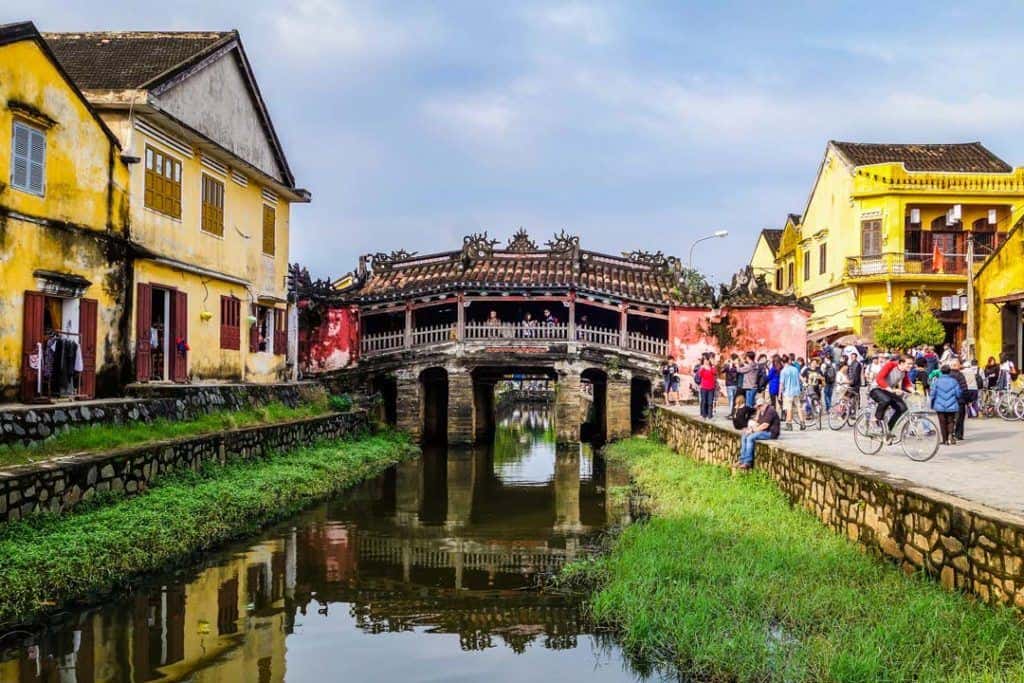
Getting to Vietnam
There are a number of different ways to travel to Vietnam, depending on where you are coming from and how you like to get around with transport.
There are a lot of different airlines that fly to Vietnam from all over the world. There are two major international airports in Vietnam: Tan Son Nhat Airport (SGN) in Ho Chi Minh City in the south and Noi Bai Airpot (HAN) in Hanoi in the north.
Direct flights to Vietnam from Australia, Europe and North America are still limited, but it is improving. You will most likely have to book a flight with a stopover in either Hong Kong, Bangkok, Kuala Lumpur, Seoul or Singapore.
There are many domestic airports scattered among the country. Vietnam Airlines is Vietnam’s national carrier. We have flown with them several times and they are amazing.
You can cross into Vietnam by train from China, all the way from Beijing to Ping Xian. This is the Dong Dang Crossing which is 160km from Hanoi.
After you have crossed the border hop on a train to Hanoi. Don’t buy the direct ticket from Beijing to Hanoi. It works out cheaper to buy your ticket from Beijing to Ping Xian then cross the border and purchase another ticket from Dong Dang to Hanoi.
If you do the train trip from Beijing through to Hanoi, it will take 36 hours so it is best to book a sleeper. Make sure you have your visa organised before getting to the border.
You can bring your own food and drinks for the train or purchase them from the cafeteria on board. There are squat toilets on board and areas to store your luggage.
You can get to Hanoi or Ho Chi Minh City through either the Cambodia, Laos or China borders. There is a route from Vientiane (Laos) to Hanoi, and one from Siem Reap or Phnom Penh to Ho Chi Minh City.
Most travel agents in Vientiane, Siem Reap or Phnom Penh will sell the tickets or at your accommodation. You can also get a minivan from Guangzhou through to Hanoi.
Make sure you have your visa ready. The border crossings by land may not be set up as well as others.
If you want to book any of your bus trips online rather than trying to deal with travel agencies in the country, you can do so on the popular website Bookaway .
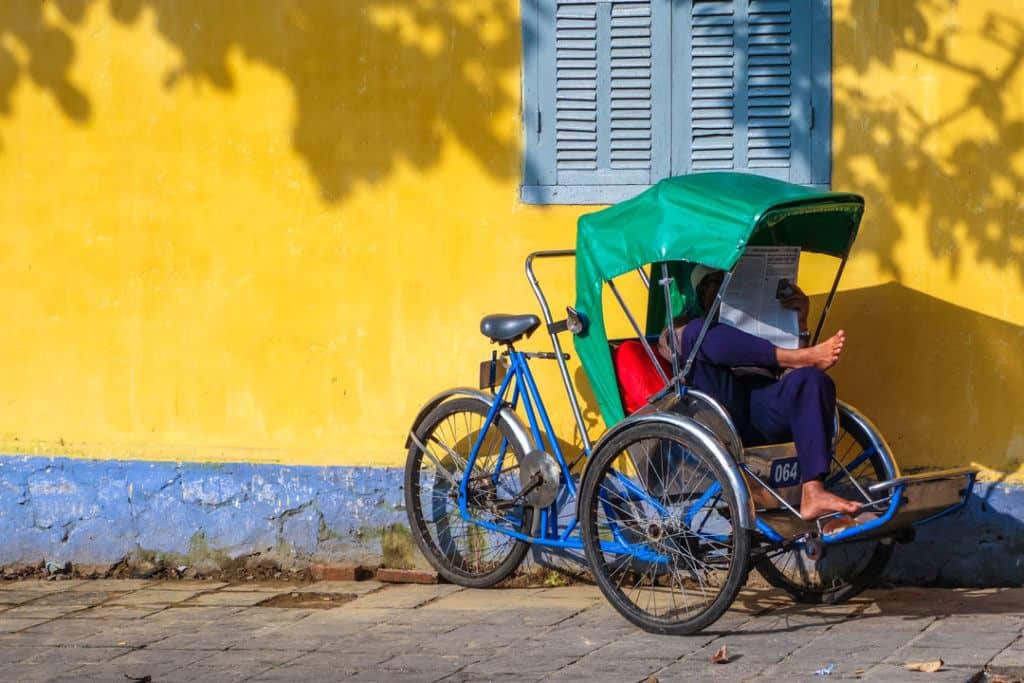
Getting Around Vietnam
Getting around Vietnam is surprisingly easy. Public transport goes everywhere, and there are plenty of moto-taxis that are happy to take you to the places that public transport won’t reach.
Travelling by Air
The fastest way to get around the country, of course, is by air. There are many domestic airports all over the country and you can fly in from major cities.
You can get cheap flights within the country through VietJet Air and Vietnam Airlines. For the best deals head directly on the airline’s website.
Travelling by Taxi, Tuk Tuk Or Mototaxi
When you are in the cities and town catching a taxi, tuk-tuk or moto-taxi can be the best way to get around. For taxi companies, look for the biggest and most reputable companies as you can be ripped off.
For the tuk-tuks, ask your accommodation the average price to your destination so you can agree on a price with the driver.
We recommend Uber and Grab (car or motorbike) which you can use an app and get the price.
Travelling by Bus
It is possible and advisable to travel by bus throughout Vietnam. Busses inside of cities can be complicated and should be a last resort.
However, when travelling long distances in Vietnam busses are a great option. This is especially true if you take night busses and sleep during the ride.
Travelling by Motorbike
We think travelling by motorbike is the best way to see Vietnam if you have the time. Buy your own motorbike and ride the length of the country. Or you can choose one area and explore Northern Vietnam or South Vietnam.
Here’s our post to help guide you on how to buy a motorbike in Vietnam .
Travelling by Train
Taking the train is a great way to get around the country. They are great for overnight journeys as the trains have bed cabins.
In Vietnam, there are many places with roadwork that can last for years. So trains can be the best way to go.
APPS AND TECHNOLOGY
We know you’ll absolutely love travelling in Vietnam. But technology has made it easier, more affordable and safer to travel than ever.
Here are a few apps we think you should definitely acquaint yourself with prior to your travels:
Grab – Use this app to catch a ride from any metro area in Vietnam.
XE Currency – Transfer, monitor and calculate currency as the need arises. This app may not be totally necessary as you are typically tied into rates the banks charge for services. But it is handy to have around.
Express VPN – This will protect your sensitive information wherever you travel – not just in [Country]. Be sure to have this to keep your online information secure as you travel.
iTranslate – Even if you don’t know more than a handful of Vietnamese words, iTranslate will help you communicate as you travel in Vietnam.
WiFi Finder – With this app, you no longer have to guess whether the next place on your itinerary has WiFi or scramble across town looking for hot spots.
BEST THINGS TO EAT IN VIETNAM
When you travel to a foreign country one of the new and most exciting things you will experience is the food. There are so many amazing food choices in Vietnam, and Vietnamese food is delicious.
Here are a few of our favourites.
Goi Cuon: This is a rice paper packed with greens, coriander and various combinations of minced or shredded pork, shrimp or crab. It will be served with a sweet and sour sauce or a delicious homemade peanut sauce.
Sometimes to make the experience even better, you get to hand roll them yourself. This was our favourite dish.
Banh Mi: With this one, it will be different in every corner of Vietnam. This is a baguette sandwich that is filled with meat, greens, pata, pickled vegetables, soy sauce, cilantro and sometimes an omelet.
The meat filling will be roasted pork belly, grilled pork loin, barbecue pork, boiled chicken, or a fried egg.
Pho (pronounced ‘fur’): This flat rice noodle soup is either light beef or chicken broth flavoured with coriander and ginger with spring onions and bits of meat (chicken, pork or beef).
It is a dish you can have any time of the day and is delicious, but it can be hit and miss in some places. If you have an average one, please do try it again. We ate pho a lot for breakfast and never got sick of it.
Bun Cha: This is a Hanoi specialty and it is deliciously addictive. Bun Cha is served with grilled fatty pork over a plate of white rice noodles. It will be served with a sauce.
It will all be served separately and you combined everything together. You can ask for some little fried spring rolls on top too. It is so delicious!
Coa Lau: Hoi An is the best (and only authentic) place to try this one. as the noodles are made using water from a special well in town.
It is chewy rice flour noodles with Chinese barbecue pork, bean sprouts, croutons and fresh herbs in a delicious pork-based gravy.
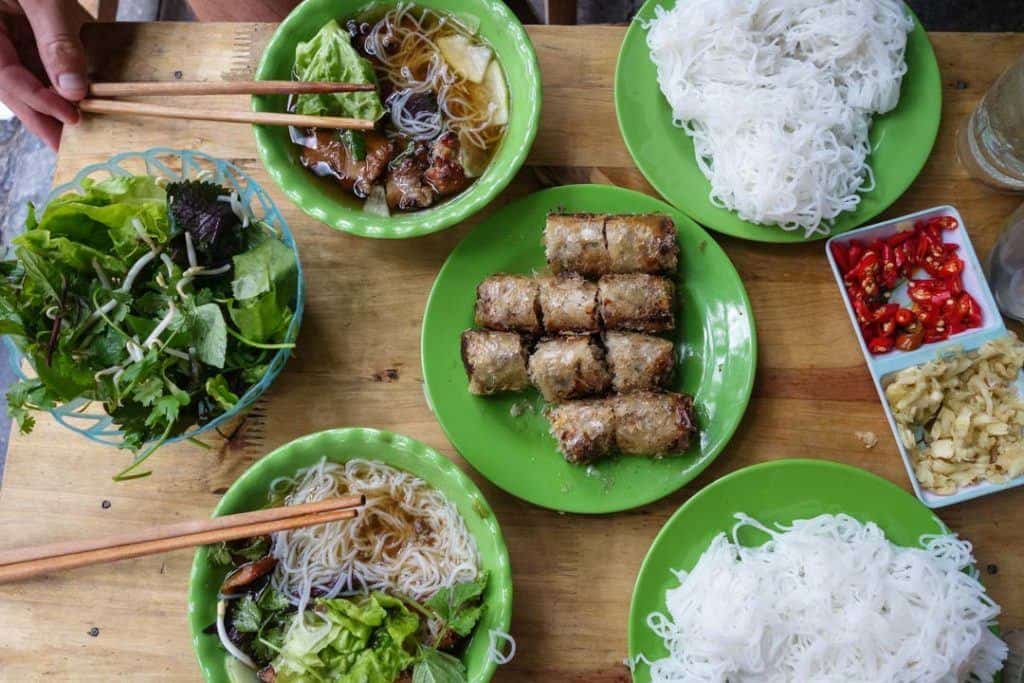
PLACES TO STAY IN VIETNAM
There are accommodation options for all budgets in Vietnam. You can stay in a shared dorm for $5 USD per night, or a luxury hotel for over $300 USD.
The accommodation standards can vary in each destination.
For example, we got a really nice hotel in the middle of nowhere when we were on our bike for $12 a night. But we would not find a place like this in Hanoi, Hoi An, HCMC or Hue for less than $25.
NOTE – In Vietnam, the accommodation will keep your passport for the duration of your stay. This is to do with the government. Officials will randomly come around and check hotels and hostels.
If they do not have the ID or passport of every person staying there, the accommodation will be fined. The accommodation will keep your passport in a safe. If you are unsure just ask, “do you lock my passport up?”
Types of Accommodations
Vietnam is wildly popular among backpackers. Because the costs are generally incredibly low, budget travellers flock to the country.
This means that there are lots of great hostel options when looking for accommodations in Vietnam.
Whether you are busy spending all your time exploring and are just looking for a cheap place to crash for the night or want to make friends along the way, you will find most of what you are looking for in a variety of hostels throughout Vietnam.
Because costs are generally lower in Vietnam than in most parts of the world your quality of life can go up quite a bit when you travel to Vietnam.
One way you can upgrade your travel experience is by booking rooms in hotels instead of beds in hostels. For a few dollars more you’ll get vastly more space and privacy.
In some towns and villages, hotels are your only option.
But generally, these are very reasonably priced. You can expect to spend USD$20-30 for a decent hotel room in most cities, towns and villages across Vietnam.
Another good option in recent years is AirBnB, and there are more and more amazing places popping up to stay in Vietnam for very affordable prices every day.
As is typical in many destinations where Airbnb accommodations are available, you’ll likely find great value and a little more personal space with an Airbnb stay.
If you’re looking for an awesome place to stay, we personally love using Airbnb. If you’ve never used the platform before, sign up using this link to get USD$35 off your first booking .
Our Favorite Places to Stay in Vietnam
We travelled from the south to the north and stayed in many different places. Here are a few accommodation options we highly recommend.
VIETNAM TRAVEL TIPS
The Vietnamese people are friendly, welcoming and hospitable towards travellers. It is a great destination to travel to in Southeast Asia.
The people are very respectful and would like the same back from you. Here are a few things that you should know before going to Vietnam.
GENERAL VIETNAM TRAVEL TIPS
While we have many basic travel tips we suggest you use when travelling to Vietnam, there are also plenty of Vietnam-specific tips that will make your visit the best it can be.
Here are a few we recommend you consider as you plan your trip to visit Vietnam:
Please show respect to their religious beliefs and their cultures . You are travelling to someone else’s country. They have different religious beliefs and cultures in your home. Please respect them.
Watch your belongings. Vietnam is a safe country but unfortunately, there still is petty theft. Whether you are at a restaurant or on a bus always watch your belongings.
Beware of the counterfeit tour agencies . Unfortunately, there are plenty of these around, especially in the main tourist areas. Book through the main owner or operator or any of these tours that we recommend .
Do not drink the tap water. The locals don’t even drink the water. There is bottled water available everywhere. Popular tourist restaurants will usually have on their menu that they wash their salad and veggies in sterilised water and make tea, coffee and soup from that too.
Carry toilet paper everywhere . There are toilets available in restaurants or in public but there may not be toilet paper. Most of the time you have to pay for the public toilet and they may give you some toilet paper, but don’t count on it. Always have your stash.
Toilet paper goes in the bin . DO NOT put the toilet paper in the toilet. Please put it into the bin provided. Vietnam’s sewerage systems are not built for much more than human waste so toilet paper and other items will just clog up your toilet.
Embrace the “bum gun “. Next to every toilet in Vietnam, there is a water hose. This is not to wash down the floor. This is to clean yourself up after you do your business. Don’t be disgusted by this. Embrace it.
Vietnam is bigger than you think . This country is huge and many people underestimate it. Vietnam is about 1,650 kilometres long from north to south. The distance on buses and trains is long so be prepared.
Take note of the Vietnamese money . It will be a new currency for you so do take a look at it before you go out spending. There are more zeros in it than you might be used to (1USD = 23,000 Dong)
Always take photos when you rent a scooter . Renting a scooter in Vietnam is something everyone does. It is a great way to get around and see all the attractions. But where you rent it from can get you into trouble. Whenever you rent a scooter take photos of the bike or else might end up with a crazy expensive bill.
Always wear a helmet. Always . Please wear a helmet. The roads are crazier here than they are in your country. The rules are different and road conditions are not the best. A quality helmet could save your life in an accident.
Make sure you have travel insurance . We tell people who are going travelling, “if you can’t afford travel insurance, you can’t afford to travel.” You do not know what is going to happen while you are away and knowing you are covered will put your mind at ease.
Be confident when crossing the road . The roads in Vietnam are crazy. Crossing the road can be daunting but you need to be confident. Do not walk backward or hesitate. Walk slowly and watch the traffic coming towards you. They will all move around you.
Take your shoes off before entering a temple or a person’s home . It is a custom that stems back to ancient times and a big part comes back to cleanliness. The ground is used for chatting, dining and even sleeping.
Cover your shoulders and knees when entering a temple . This is common in most religious sites. There are always signs suggesting visitors dress ‘appropriately.’ Shoulders and knees should be covered. If it is a hot day and a t-shirt is too sticky, carry a scarf for when you visit to cover your shoulders.
Keep a low profile . Do not be loud, raise your voice in aggression or show off. Do not show dramatic affection publicly like kissing. Save it for the hotel room
Ask for permission before taking a photo of someone . This is polite and ensures you are not intruding on them. The people are not there for your entertainment. If they say no, smile and thank them anyway.
Do not take photos of anything to do with the government or military. This is a big NO in any country and can end up with you in jail.
Do not touch someone on the head . The head is the most important part of the body. Touching someone’s head who you don’t know is like saying you are more important than they are.
Place your chopsticks across the top of the bowl when finished . Don’t have your chopsticks hanging out of the bowl, and don’t point them at anyone when they are resting on the plate.
VIETNAM PACKING LIST
We always travel with a core packing list wherever we go. And when it comes to Vietnam, many factors will affect what else you need to bring along with you.
Check out our travel essentials and be sure to add any of the other additional items listed below.
Important Note! Before you book any international trip, we honestly recommend getting travel insurance. You never know when things will go wrong, and medical bills can add up quickly if you get sick or injure yourself overseas.
Our personal recommendation based on our own experience is World Nomads .
TRAVEL INSURANCE. SIMPLE & FLEXIBLE.
Which countries or regions are you traveling to, what’s your country of residence, enter traveler’s age, staying safe in vietnam.
Vietnam is extremely safe, apart from the one major danger which is the roads. They are crazy, even more so if you try to ride 10’000km around the country on motorbikes as we did!
Aside from that, common sense will keep you safe.
Here are a few reminders of what common sense when travelling in Vietnam means:
As you saw above, Vietnam is extremely safe. We did not feel unsafe once in the 7 months we were there (excluding the roads).
This doesn’t mean you can completely let your guard down though, and petty theft does happen in this country, although it’s not common.
Some tips for protecting your things:
In other words, use common sense and you’ll be fine.
STAYING CONNECTED IN VIETNAM
Staying connected with friends and family (and work) when travelling in Vietnam is important. But if you don’t know how to connect you can find yourself greatly inconvenienced or spending too much money.
We feel like your money will go a lot further if you consider a few options.
Purchase a SIM Card
Picking up a SIM card has become the quickest and typically most affordable way to stay connected in Vietnam or any country for that matter.
If you have an unlocked phone you can use a 4G SIM card to connect to the cellular networks in Vietnam. From there you can cast a hot spot if you need to crank out some work on your computer or want to connect a tablet.
This 3G/4G SIM card is a great and affordable option for a SIM card if you are flying into Vietnam.
Rent a Portable WiFi Device
Alternatively to a SIM card, particularly if you don’t have an unlocked phone, you can rent a portable WiFi device during your travel to Vietnam.
This device will be delivered to you when you arrive in Vietnam and will provide 4G service for less than USD$5 per day.
You’ll be able to connect anywhere you can find service across the country, which will be most of the places you are likely to travel in Vietnam.
Access Free WiFI
Free is always best, if it is convenient. And there are plenty of places throughout Vietnam that will provide free WiFi in public spaces or at restaurants, cafes and hostels and hotels.
We recommend using the WiFi Finder app, which will help you locate WiFi anywhere you travel in Vietnam.
BE A RESPONSIBLE TRAVELER IN VIETNAM
We absolutely love Vietnam. And we love the idea that it will remain a beautiful and friendly place for travellers for years to come.
Here are a few tips specific to travel to Vietnam that will promote sustainable tourism in the country:
Use your own energy to get around. Walk or cycle through town as much as possible. Taking a cyclo-taxi is a close alternative if you don’t have the energy to propel yourself through the city. But this reduces the impact of taxis, busses and other forms of automotive transportation.
Mind your plastic . Plastic is everywhere in Vietnam. But using your own reusable bag for groceries and other shopping, carrying a reusable water bottle and having your own straw are just 3 of the many simple ways you can reduce the amount of plastic you use.
Shop local . Visiting the markets will be one of your top experiences when travelling to Vietnam. Support local vendors as often as possible, including in taking tours when available.
Be mindful of wildlife . Wildlife in the wild is great. But be mindful not to provoke, feed or otherwise molest wildlife. And never purchase any item made of or involving rare or endangered species.
Attempt to communicate in Vietnamese . You’re probably not going to be fluent as soon as you arrive in the country. But knowing a few phrases and doing your best to communicate with locals will show respect and earn trust and make your experience richer.
KEY VIETNAMESE TRAVEL PHRASES
You don’t have to be fluent in Vietnamese to have a great time when you travel to Vietnam. But it does help to know a few key phrases.
This will not only assist you in your travels but it will also show respect to the local Vietnamese people that you are doing your best to assimilate into their culture.
BOOKS TO READ ABOUT VIETNAM
Maybe you already know everything about Vietnam. Chances are you don’t!
But even if you are well-read, here are a few suggestions that might be worth your time while you’re on the plane to Vietnam.
The Quiet American (Graham Greene) – Originally published in 1956 and adapted for film twice, this story by Greene became an instant classic. Greene fictionalizes life in 1950s Vietnam as told by a British correspondent trying to understand the roots of the rising conflict set to occur.
At Home In The World (Thich Nhat Hanh) – World renown Vietnamese monk, Hanh reflects on lessons and stories in life from the Buddhist perspective.
Vietnam: Rising Dragon (Bill Hayton) – A piece of nonfiction that looks back on the Vietnam of old and attempts to projects its place in the future of Southeast Asia.
The Sympathizer (Viet Thanh Nguyen) – The Pulitzer Prize-winning book, allegedly influenced by The Quiet American , is told through the eyes of a double-agent during the Vietnam War who struggles to understand the minds and hearts of men engaged in war.
DISCLAIMER: Some of the links in this article are affiliate links, which means if you book accommodation, tours or buy a product, we will receive a small commission at no extra cost to you. These commissions help us keep creating more free travel content to help people plan their holidays and adventures. We only recommend the best accommodations, tours and products that ourselves or our fantastic editorial team have personally experienced, and regularly review these. Thanks for your support, kind friend!
Table of Contents
Read our vietnam posts, 20 amazing things to do in hoi an, vietnam (2024 guide), 14 incredible things to do in dalat, vietnam (2024 guide), the perfect 3 days in hanoi itinerary [2024 guide], 25 amazing things to do in hanoi, vietnam (2024 guide), the perfect 3 days in ho chi minh city itinerary [2024], the 8 best day trips from ho chi minh city (2024 guide), caves, zip lines and deep mud in phong nha, ganh da dia – vietnam’s own ‘giant’s causeway’, ba be national park – the lake, trekking and happy water, motorbiking the road from dalat to nha trang in vietnam, riding sea to sky: hue to hoi an by motorbike, getting a chinese visa in hanoi, vietnam.
Vietnam travel guide
This Vietnam Travel Guide is a comprehensive resource that offers essential information for travelers exploring this diverse country. It includes details on popular destinations, practicalities such as visas, currency, and language, as well as transportation options like taxis, buses, trains, and domestic flights. The guide also provides insights into the weather patterns month by month, allowing you to plan your trips accordingly. Furthermore, it offers cultural background and inspiration.
Destinations
Essential guide, getting around, vietnam weather by month.
- Inspiration
Vietnam is a country with a countless of destinations to explore, and this Vietnam travel guide highlights some of the most popular ones.
North Vietnam
Hanoi , the capital city of Vietnam, is known for its rich history, vibrant culture, and bustling street life. Visitors come to explore its charming Old Quarter, taste delicious street food, and visit iconic attractions like Hoan Kiem Lake and the Temple of Literature.
Sapa , located in the northwest of Vietnam, is renowned for its stunning terraced rice fields and ethnic minority hill tribes. Travelers flock to Sapa to trek through breathtaking landscapes, experience the unique culture of local communities, and witness the beauty of the Fansipan Mountain, known as the “Roof of Indochina.”
3. Halong Bay
Halong Bay , a UNESCO World Heritage site, is famous for its breathtaking natural beauty. Travelers visit this iconic destination to cruise along the emerald waters, marvel at the limestone karsts and islets, and explore hidden caves and floating fishing villages.
4. Ninh Binh
Ninh Binh , often referred to as the “Halong Bay on land,” captivates visitors with its stunning karst landscapes, ancient temples, and picturesque countryside. Travelers come to Ninh Binh to take boat rides through the Trang An Complex, explore the ancient capital of Hoa Lu, and enjoy the tranquility of the rural scenery.
5. Ha Giang
Ha Giang , located in the far north of Vietnam, offers adventurous travelers an off-the-beaten-path experience. Known for its dramatic mountains, winding roads, and ethnic minority communities, Ha Giang attracts visitors seeking epic motorbike journeys, trekking adventures, and cultural immersion in remote and pristine landscapes.
6. Mai Chau
Mai Chau , nestled in the peaceful valley of Hoa Binh Province, offers a serene escape from bustling cities. This rural destination is famous for its picturesque landscapes, traditional stilt houses, and warm hospitality of the Thai ethnic minority. Visitors can cycle through scenic villages, participate in local homestays, and enjoy traditional dance performances.
Central Vietnam
7. phong nha.
Phong Nha , is a paradise for nature and adventure enthusiasts. This UNESCO World Heritage Site is famous for its magnificent cave systems, including the world’s largest cave, Son Doong. You can explore the stunning underground wonders, go trekking in the lush jungle of the national park and kayak over the Son River.
Hue , the former imperial capital of Vietnam, is renowned for its historical significance and majestic citadel. Visitors come to Hue to explore its UNESCO World Heritage sites, including the Imperial City and the royal tombs, and to experience the city’s rich cultural heritage, traditional music, and delicious royal cuisine.
Da Nang , a coastal city in central Vietnam, is known for its beautiful sandy beaches, stunning bridges, and modern skyline. Travelers visit Da Nang to relax on its pristine shores, explore iconic attractions such as the Marble Mountains and the Dragon Bridge, and indulge in delicious seafood.
Hoi An , a charming ancient town, enchants visitors with its well-preserved historic architecture, lantern-lit streets, and vibrant riverside atmosphere. People flock to Hoi An to wander through its atmospheric alleys, shop for tailored clothing, immerse themselves in its lantern festival, and savor local delicacies
11. Nha Trang
Nha Trang, a coastal resort city, is famous for its turquoise waters, white sandy beaches, and vibrant underwater world. Travelers visit Nha Trang to relax on its idyllic beaches, enjoy water sports and island-hopping tours, and experience its lively nightlife and seafood dining scene.
Dalat , situated in the Central Highlands, is known as the “City of Eternal Spring” for its pleasant climate and picturesque landscapes. Visitors come to Dalat to escape the heat, explore its French colonial architecture, visit flower gardens and waterfalls, and engage in outdoor activities like hiking, biking, and canyoning amidst its natural beauty.
South Vietnam
13. ho chi minh city.
Ho Chi Minh City , the bustling metropolis of Vietnam, offers a captivating blend of modernity and history. Visitors are drawn to Ho Chi Minh City to explore its iconic landmarks like the Independence Palace and Notre-Dame Cathedral, indulge in vibrant street food, experience the vibrant nightlife, and immerse themselves in the city’s rich history and culture.
14. Mekong Delta
The Mekong Delta , a vast maze of rivers, canals, and lush green fields, is a unique region known as the “Rice Bowl” of Vietnam. Travelers venture to the Mekong Delta to cruise along its waterways, visit floating markets, witness traditional village life, and taste the fresh tropical fruits and local delicacies unique to this region.
15. Phu Quoc
Phu Quoc , a tropical paradise island, is renowned for its pristine white-sand beaches, crystal-clear waters, and stunning coral reefs. Visitors flock to Phu Quoc to relax on its picturesque beaches, explore its national parks, indulge in water activities such as snorkeling and diving, and savor the island’s fresh seafood.
16. Con Dao
Con Dao , a secluded archipelago, offers unspoiled natural beauty and a rich historical background. Travelers seek out Con Dao for its pristine beaches, lush forests, and diverse marine life, as well as to discover its haunting history at the former prison complex, Con Dao Prison. The island provides a tranquil retreat for relaxation, outdoor activities, and exploring its captivating landscapes.
Mui Ne , a coastal town, is renowned for its stunning sand dunes, vibrant kite-surfing scene, and serene fishing villages. Visitors come to Mui Ne to witness the dramatic landscapes of the Red and White Sand Dunes, engage in water sports, taste fresh seafood, and enjoy the laid-back beach atmosphere and stunning sunsets.
Off the beaten track destinations
Explore the off the beaten track destinations in Vietnam: Cao Bang , home to the stunning Ban Gioc Waterfall ; Mu Cang Chai , renowned for its breathtaking terraced rice fields; Quy Nhon , a tranquil beach town; Kon Tum, where you can discover the mountains and ethnic minorities of the central highlands. Experience the unspoiled beauty of Lan Ha Bay and Bai Tu Long Bay , the lesser-known siblings of Halong Bay. Visit Cat Ba, the largest island in the bay, and uncover the hidden gem of Ba Be Lake , the largest natural lake nestled in the jungle.
Health & Safety
When traveling to Vietnam, it’s important to be aware of certain health and safety considerations.
Mosquitoes are prevalent, especially in certain regions, so it’s advisable to use mosquito repellent and take precautions to prevent mosquito-borne diseases like dengue fever or malaria.
Road safety can be a concern, with chaotic traffic and different driving habits, so it’s recommended to exercise caution and use designated pedestrian crossings.
It’s advisable to avoid drinking tap water and instead opt for bottled or filtered water to prevent waterborne illnesses.
Additionally, practicing good food safety by eating freshly cooked or hot meals, avoiding street food stalls with questionable hygiene practices, and practicing proper hand hygiene can help prevent food-related illnesses.
It’s always recommended to consult with a healthcare professional or travel health clinic before your trip for personalized advice on vaccinations and health preparations.
Vietnam is generally a safe destination for travelers, with a low rate of crime targeting foreign visitors; however, it’s important to remain vigilant and take precautions against petty theft, such as keeping a close eye on personal belongings and being aware of common scams.
Money & budget
Vietnam’s official currency is the Vietnamese Dong (VND), and it’s advisable to carry local currency for most transactions as other currencies are not accepted. Banks and authorized currency exchange offices are the best places to exchange foreign currencies, but interestingly, gold jewelry shops often offer competitive exchange rates.
The average cost of a trip to Vietnam varies depending on your travel style. For budget travelers, a weekly average budget can range from $150 to $300, including accommodation, meals, transportation, and some sightseeing. Midrange travelers can expect to spend around $300 to $700 per week, while luxury travelers may have a budget of $700 and above per week.
In Vietnam, there is no tipping culture , and service charges are usually included in the bill. However, it’s appreciated to give small tips for exceptional service. ATMs are widely available throughout the country, but it’s important to note that there may be limits on the amount you can withdraw per transaction. Additionally, many local shops and restaurants may not accept card payments, so it’s advisable to carry enough cash for smaller purchases.
Internet & calling
Vietnam has a widespread availability of Wi-Fi networks, ranging from local restaurants and coffee shops to upscale resorts. As a customer, you can typically access these Wi-Fi networks for free.
However, to ensure a reliable internet connection and avoid dependence on Wi-Fi, it is recommended to buy a Vietnamese SIM card . SIM cards are affordable and convenient, allowing you to have internet access for various purposes such as navigating with Google Maps, using Google Translate, booking taxis through ride-hailing apps, or checking reviews on platforms like TripAdvisor. While there are several providers to choose from, Viettel is generally considered the best option for its coverage and reliability.
Electricity & socket adapters
The voltage in Vietnam is typically 220V, and the sockets commonly used have 2 pins , accommodating both flat and round pins. If your devices use a different type of plug, you can either bring a travel adapter with you or easily purchase one in Vietnam at one of the many convenient stores available.
Traveling to Vietnam
Before traveling to Vietnam, it is essential to check the visa requirements for your country. While a few countries, including 11 European countries, are eligible for visa-free entry , allowing a maximum stay of 15 days, those wishing to stay longer or coming from other countries such as the US, Australia, Canada, or New Zealand, must arrange a valid visa before their trip.
For most travelers, the e-visa is the recommended option, which can be easily obtained through the official website of the Vietnamese immigration. The e-visa process typically takes 3 to 4 working days, costs 25 USD, and allows a stay of up to 30 days in Vietnam.
Arrival options
Unlike major hub cities like Hong Kong, Singapore, Bangkok, and Kuala Lumpur, Vietnam doesn’t have as many international direct flights from the US, Australia, and Europe, often requiring a transit. It’s important to note that even when boarding your flight to Vietnam, you need to show a valid visa.
In addition to flights, Vietnam can be accessed by land borders from countries such as Cambodia, Laos, and China. Another option is entering Vietnam via a seaport. Fortunately, all of these entry options, including land and seaports, are possible with an e-visa.
Long distance
1. domestic flights.
Domestic flights in Vietnam are a great option for traveling within the country, offering convenience and affordability. With tickets that can be as cheap as $40 USD, it’s an excellent alternative to avoid long journeys by bus. Vietnam has three major airlines, namely Vietnam Airlines, Vietjet Air, and Bamboo Airways, providing extensive coverage to numerous domestic airports across the country, totaling around 21 airports.
2. Bus travel
Bus travel in Vietnam is a popular and extensive mode of transportation, with a network that connects every corner of the country. It is known for being very affordable, making it an economical choice for budget-conscious travelers. There are various options available, including day buses and sleeper buses, with different classes such as smaller limousine buses, VIP sleeper buses, normal sleeper buses, and mini vans. Opting for the luxury options may provide a more comfortable and enjoyable experience without a significant increase in cost.
3. Train travel
Train travel in Vietnam offers a unique and nostalgic experience, allowing you to soak in the scenic beauty of the country at a more relaxed pace. While trains may be slower compared to buses, they are generally considered a safer mode of transportation. Depending on your preference and budget, trains offer various options including hard seat, soft seat, and different cabin configurations such as 4 berth and 6 berth cabins. For popular routes like Sapa to Hanoi, there are tourist trains available, providing additional comfort for the journey.
4. Private transfers
Private transfers in Vietnam offer convenience and flexibility for travelers, as foreign tourists are not permitted to drive cars themselves. Renting a car with a driver allows for comfortable and hassle-free transportation, whether for airport transfers or exploring different destinations. Moreover, private transfers can be customized to include stops along the way, giving you the opportunity to create your own personalized tour or embark on a multi-day trip to discover the diverse landscapes of Vietnam.
Short distance
5. public transportation.
While public transportation options like the metro and buses exist in Vietnam, they are often underutilized by tourists. The metro system is still in its early stages of development, and communication barriers can make it difficult to navigate public bus routes. However, the biggest reason not to use public transportation in Vietnam is the way better alternative of using taxis.
Taxis in Vietnam are an affordable and convenient mode of transportation, offering door-to-door service for travelers. Additionally, taxi apps like Grab have gained popularity, providing an effortless way to book a taxi and communicate your destination, effectively overcoming any language barriers you may encounter.
Walking in Vietnam’s cities can be challenging as sidewalks are often in poor condition and occupied by parked motorbikes, forcing pedestrians to walk on the main road. Crossing roads can also be a daunting task, unless you come across a traffic light. Generally, Vietnam is not considered pedestrian-friendly in urban areas.
However, outside the cities, there are excellent opportunities for trekking in Vietnam , allowing you to explore beautiful landscapes, such as rice fields, jungles, and smaller villages.
Other options for getting around
Apart from practical transportation options, there are leisurely alternatives for getting around in Vietnam. Cycling is a fantastic way to explore the peaceful cities and picturesque countryside, offering a closer connection to the surroundings.
Cyclo rides provide a unique and authentic local experience, allowing you to leisurely explore the streets and soak in the vibrant atmosphere. Boats and cruises are popular for discovering the rivers, canals, and stunning landscapes of the Mekong Delta and the famous Halong Bay.
Best time to visit Vietnam
Vietnam experiences three distinct weather regions due to its elongated shape. Each region has its own best time to visit , making it somewhat challenging to pinpoint a single ideal time. However, if you’re looking for a period that aligns with all three regions, the best time to visit is generally from January to May, with March being particularly favorable.
Northern Vietnam : In the north, the weather is divided into four seasons. From January to March, it is often chilly with occasional fog in Hanoi and Halong Bay. Spring (April and May) brings pleasant temperatures and blooming flowers. Summer (June to August) is hot and humid, while autumn (September to December) offers cooler temperatures and clearer skies.
Central Vietnam : Central Vietnam has a tropical climate with distinct wet and dry seasons. From January to August, the weather is relatively dry, making it a good time to visit cities like Hue and Hoi An. However, be aware of potential typhoons from August to November. The region also experiences high temperatures in the summer months.
Southern Vietnam : Southern Vietnam has a tropical climate with two main seasons – dry and wet. From November to April, the dry season prevails, characterized by lower humidity and pleasant temperatures. May to October is the wet season, with frequent rainfall and higher temperatures. Ho Chi Minh City and the Mekong Delta are popular destinations in this region.
Vietnam by month
With so many incredible destinations to choose from in Vietnam, it can be overwhelming to decide where to go. Here are some inspiring recommendations to help you plan your trip:
- For the best rice fields , consider visiting Sapa, which is easily accessible and boasts vast landscapes. Alternatively, Pu Luong offers smaller, less touristy rice fields but requires a bit more effort to reach.
- When it comes to beautiful beaches , Phu Quoc is renowned for its stunning shores. Along the central coast, you’ll also find picturesque beaches in Hoi An, Quy Nhon, Phu Yen, and Nha Trang.
- Seeking adventure? Embark on a thrilling motorbike journey in Ha Giang, explore captivating caves in Phong Nha on caving expeditions, or try canyoning in the scenic town of Dalat.
- Vietnam is home to some of the most beautiful cities , including the charming ancient town of Hoi An, the bustling capital city of Hanoi, the historic city of Hue, and the picturesque hill station of Dalat.
- If trekking is your passion, head to Sapa, Ha Giang, Pu Luong, or other mountainous regions for unforgettable hiking experiences amidst breathtaking landscapes.
- For nature enthusiasts, Ha Giang, Sapa, Ninh Binh, Halong Bay, and Ban Gioc Waterfall offer spectacular natural wonders to explore and admire.
For more inspiration and detailed information about these and other remarkable destinations in Vietnam, you can check out our Vietnam inspiration list .
Vietnamese culture
To fully immerse yourself in Vietnamese culture, here are some helpful tips to enhance your experience:
- Embrace Vietnam’s culinary pride by indulging in local cuisine. Take a street food tour or join a cooking class to discover the diverse flavors and ingredients that make Vietnamese food so renowned.
- Vietnam is home to 54 ethnic groups , each with its own unique traditions. Learn from them by visiting ethnic markets, staying at homestays, and exploring villages to gain insights into their customs, arts, and way of life.
- Gain a deeper understanding of Vietnam’s history by learning about the Vietnam War . Visit significant sites such as the Cu Chi Tunnels and the War Remnants Museum , which provide valuable perspectives on the country’s past.
- When visiting temples and pagodas, dress appropriately by covering your shoulders, wearing modest clothing, and removing your shoes as a sign of respect.
- Make an effort to learn some basic Vietnamese phrases . While many Vietnamese may not speak fluent English, they appreciate and welcome your attempts to communicate in their language.
- Celebrate special events with the locals, such as Tet (Lunar New Year), Mid-Autumn Festival , or National Day . Participate in traditional festivities, enjoy local customs, and savor the festive atmosphere.
- When entering someone’s home or certain establishments, it is customary to remove your shoes as a gesture of cleanliness and respect.
- Always ask for permission before taking photos of people, as it shows respect for their privacy and personal space.
- Avoid any disrespectful actions towards the national flag or the country’s leaders. Show reverence and sensitivity towards symbols of national importance.
- Explore traditional craft villages to witness artisans practicing age-old crafts, such as pottery, silk weaving, or wood carving. This provides an opportunity to appreciate Vietnam’s rich artistic heritage.
- Join locals for a casual beer-drinking experience on the street. Sidewalk stalls offer a social and lively atmosphere where you can engage with Vietnamese people and soak up the local culture.
- Experience the warmth of Vietnamese hospitality by joining a family dinner. Embrace the tradition of sharing abundant food and engaging in lively conversations, creating lasting memories of authentic Vietnamese hospitality.
- Ho Chi Minh City
- Mekong Delta
- Language & travel dictionary
- Electricity
- Internet & calling
- Best travel time & weather
- Hoe does it work?
- Visa on Arrival
- Visa at embassy
- Holidays & Events
- People & minorities
- Flights to Vietnam
- Domestic flights
- Motorbike buy/rent
- Train travel
- 15 most beautiful destinations
- 20 best things to do
- 10 best off the beaten track
- 10 most stunning beaches
- 10 best rice fields places
- 10 best adventures
- 10 cultural experience
- All travel inspiration
- Package trips
- Custom made trip
- Destination Guide
- Essential Guide
- Getting Around
- Vietnam Month by Month
- Vietnam blog
- Travel tips
- Custom Made Trip
- Day- & Multiple Day tours
- Holiday Packages
- Local Meo Vac Homestay
- Local Dong Van Homestay
- Our Team & Company
- Our Customers & Reviews
Copyright © 2023 Local Vietnam
Start typing and press enter to search
Free ebook vietnam travel guide.

The Complete Travel Guide to travel to Vietnam (Updated 2023)
Over the past years, Vietnam has emerged as a premier tourist destination in Southeast Asia, with an estimated 18 million international arrivals in 2019. The number is only expected to rise – and for a number of good reasons. The country is renowned for its colorful history, diverse culture and quintessential natural landscapes.
If you are planning to visit, an illustrated guide will prove handy. This post is packed with all the important information so you don’t have to spend a lot of time researching online and browsing multiple websites. We have done much of the work for you and we are extremely proud of this comprehensive article as it will serve as a valuable resource to anyone who wishes to visit Vietnam.
Part I. Travel Visa
3 month multiple entry visas will be available from 15 August 2023. Citizens from all countries are now eligible for the e-visa program. 09 more ports of entry have been added to the list of eligible Entry/Exit points. Effective from 15 August, 2023, regular passport holders of 13 countries will be exempt from visa requirements for Vietnam for 45 days instead of 15 days.
1. Do you need a Visa to go to Vietnam?
Vietnam offers visa exemptions to tourists from 13 countries and e-Visas to tourists from all countries. Travelers can also apply for a visa on arrival online or in person at a Vietnamese embassy or consulate.
2. Visa Exemptions
Vietnam’s new visa policy effective from 15th August 2023 extends stay duration for 13 countries enjoying unilateral visa exemption from 15 days to 45 days , regardless of passport type and entry purpose. The 13 coutries include: Germany, France, Italy, Spain, the UK, Russia, Japan, Republic of Korea, Denmark, Sweden, Norway, Finland and Belarus .
Below is the full list of 25 countries +Kazakhstan that are exempted from visa requirement:
Brunei, Myanmar, Belarus, Denmark, Finland, France, Germany, Italy, Japan, Norway, Russia, South Korea, Spain, Sweden, The UK, The Philippines, Cambodia, Indonesia, Kyrgyzstan, Laos, Malaysia, Singapore, Thailand, Chile, Panama.
Notes on Exemptions:
The exemptions listed above are valid until Dec. 31, 2025.
Pro Tip: + All nationalities traveling directly to Phu Quoc Island can visit for 30 days visa-free. You just need to show an outbound ticket on arrival in Vietnam. + If you enter Phu Quoc and then travel to the mainland, you will need to apply for an e-visa/visa to Vietnam. The best way is to apply for evisa/visa in advance and you will need to show your e-visa/visa on arrival at Phu Quoc International aiport for eligible stamp on your passport to visit the mainland later on. If you fail to do so, you might have to apply for a different visa and the procedure would be more complicated.
3. e-Visa Requirements
The e-Visa is one of several visa types offered by the Vietnam Immigration Department to foreigners entering the country. It is valid for 90 days and single entry and multiple entry . It costs US$25 for single entry and US$50 for multiple entry for card payments and requires at least three working days to process.
Vietnam e-Visa Requirements:
- A passport with six (6) months’ validity
- A photo in .jpg format of your full passport data page
- A passport photo in .jpg format (4×6 cm, white background, without glasses)
- A valid international credit or debit card
- An email address for support purposes
- A temporary address in Vietnam
- Your entry and exit dates and entry and exit points/airports
How to Apply for Vietnam’s e-Visa:
Step 1 : Prepare the required materials
Step 2 : Open the official website for Vietnam’s e-Visa Application
Step 3: Upload your .jpg images (passport data page and passport photo) and fill out the required fields on the form.
Step 4: Pay the e-Visa fee of US$ 25 for single entry visa or US$50 for multiple entry visa using any of the payment methods offered. Copy the document code provided. This fee is not refunded if your application is refused or your visa letter contains any wrong details that have been provided by you in the application form.
Step 5: Within three working days you will receive an email about your e-Visa application. Use your document code to locate your e-Visa online. Download and print the e-Visa in two copies for safety.
Pro Tip: Tourists with an e-Visa do not need to queue at Visa on Arrival counters. You can go directly to the immigration counter at your point of entry.
3. Vietnam E-visa official website
- https://dichvucong.bocongan.gov.vn/bocongan/bothutuc/tthc?matt=26276 for guaranteeing agencies and organizations, and
- https://dichvucong.bocongan.gov.vn/bocongan/bothutuc/tthc?matt=26277 for individual foreigners
4. Vietnam Visa on Arrival
If you want a multiple-entry visit or a stay that would last more than 30 days , you may want to apply for a visa on arrival. You will need the following:
- A 4×6 passport photo (white background and no glasses)
- A fully filled-out visa application form
- A passport or substitute ID valid for six (6) months from the date you plan to visit Vietnam
- Payment (US$25 per person for single entry or US$50 per person for multi-entry) for visa fees
- A Letter of Approval from a Vietnamese embassy or consulate (if you will pick up your visa at the airport)
If you are located close to a Vietnamese embassy or consulate, you may submit your application form, passport, photo, and visa fee in person.
If you are short on time or a Vietnamese embassy is far from your location, there are reputable online services that can provide a valid Letter of Approval for a fee. Bring this letter along with your visa application form and other documents to the Visa on Arrival counter at the airport when you arrive.
Part II. Best Time to Visit
There is really no right or wrong time to visit Vietnam because for much of the year there’s both sunshine and rain in different quantities. Vietnam has more than 2000 miles of coastline and three varying weather systems. You can think of the country as having three separate tourist destinations when it comes to the weather.
In Hanoi and the north, May to October is hot and humid, while November to April is cool and dry. In Central Vietnam, the weather is hot and dry between January and August when temperatures can rise to mid-30°C. Heavy rains tend to pour in the months of September, October and November. The southern region is generally hot and dry from November to April, and a bit warm and wet between May and October, with high precipitation in June, July and August.
1. Weather by Region and Season
Far North (Sapa, Bac Ha, Mu Cang Chai, and Ha Giang)
The climate in Sapa and the northwest region is divided into two seasons: the wet season runs from April to September, while the dry season lasts from October to late March. It can get extremely cold in December and January, especially in the evening.
The best time to visit the northeast is during the dry season, which runs from October to April. December and January can get very cold. Try to avoid travel during the rainy season, from May to September.
North Vietnam (Hanoi, Halong Bay, Cuc Phuong, Mai Chau and Ninh Binh)
North Vietnam, including the capital Hanoi, has a summer and winter season. The latter is generally cool but mostly dry and lasts from November to April. The coldest months are January, February and March, with average temperatures of 17-22°C .
Summer is from from May to October. It is hot and humid, and it is during this time when the region has its highest rainfall. July to September are frequently the wettest months, during which inclement weather can prevent cruises in Halong Bay.
**Central Vietnam (**Danang, Dalat, Hoi An, Hue, Nha Trang and Quy Nhon)
Danang, Hoi An and Hue have hot and dry weather that lasts from mid-January to late August. During this period temperatures often rise to mid-30°C. Winter sees an increase in rainfall, with October and November being the wettest.
Hue is usually cooler than Hoi An, particularly early in the year. The coastal city of Quy Nhon shares a similar weather pattern to Hoi An but the dry season lasts a little longer because of its proximity to the southern system.
Dalat, in the Central Highlands, is wet from June to October. It is far drier from November to May, and cold from December to January.
The coastal resort city of Nha Trang in the far south of Central Vietnam has a longer dry season that runs from January to September. The rainy season lasts from October to December, with approximately 50 percent of the annual rainfall pouring in October and November.
South Vietnam (Ho Chi Minh City, Phu Quoc and Con Dao, The Mekong Delta, Phan Thiet and Mui Ne, Ho Tram and Long Hai)
Temperatures remain constant throughout the year, usually ranging from 25 to 35°C. The climate is split into two seasons: wet and dry. The latter starts in November and ends in April or early May. It is slightly hotter and more humid from late February to May. The wet season lasts from May to November, with June, July and August receiving the most rainfall.
In the far south, Phu Quoc and Con Dao often see sunny days so both islands can be enjoyed year-round.
Part III. Holidays & Special Events
1. tet nguyen dan – the vietnamese lunar new year.
Tết is the most important celebration in Vietnamese culture. It is also known as the Vietnamese New Year, Vietnamese Lunar New Year or Tet Holiday. It is the shortened form of Tết Nguyên Đán, which is the Sino-Vietnamese term for “Feast of the First Morning of the First Day”.
Tết marks the arrival of spring and generally takes place from late January to mid-February. Since a lot of people return home to celebrate the holiday with friends and family, the busy cities clear out and become almost like ghost towns.
Tết can be an exciting time to visit Vietnam, but it is also the busiest time of the year to be there. The festivities will definitely have a huge impact on your travel plans. Markets and shopping malls become busier and hotels get booked. Popular beach destinations and tourist spots like Hoi An have more sightseers than usual.
It can become incredibly noisy though. Cities will have fireworks everywhere, people will be making noise by banging gongs, ringing bells, and lighting firecrackers to scare away evil spirits that bring bad luck. The revelry typically lasts for three days, although in some areas it could drag on for more than a week. The first day of Tet is normally spent with family, the second day is for catching up with friends, and the third day is dedicated to teachers and visiting temples.
Traveling during this holiday season can pose some difficulties. Buses and trains are sold out in advance so travel itineraries can’t wait until the last minute. Museums, shopping areas, and other commercial establishments can be closed for up to five days and this can affect sightseeing plans. See to it that you have things to do to keep you occupied.
Pro Tip: Plan well in advance as hotels and domestic flights might be fully booked already. Please bear in mind that tour guide fee and transportation fees are often increased during this period due to high demand.
Dates for Tet in Vietnam:
- 2022: February 1-4
- 2023: January 22-26
- 2024: February 10-14
2. Hue Festival
This is a big biennial festival that takes place in the city of Hue, where you can enjoy a wide variety of games, cultural events, and performances held for more than a week. It was created in 2000 with the goal of preserving traditional customs that date back to the Nguyen Dynasty. Since then it has been observed in the months of April, May and June every two years. During this period special showcases are held like the Hue Poetry Festival, Ao Dai Fashion Shows, Dialogue of Drums and Percussions, and sporting activities such as boat racing, kite flying and human chess. There are also movie screenings, street performances and art exhibitions.
In addition, a number of ancient sceneries of the Nguyen Dynasty are reproduced to give tourists a sneak peek into the feudal era of Vietnam. Some of the typical events include the Xa Tac Offering Ritual, the Nam Giao Offering Ritual, and the Royal Refined Music of Hue which was recognized by UNESCO in 2003 as a Masterpiece of the Oral and Intangible Heritage of Humanity.
3. Mid-Autumn Festival
This magical festival is celebrated on the 14th and 15th day of the lunar month. Also known as the Harvest Festival, Full Moon Festival and Children’s Festival, it features an array of activities like lion dances, children carrying paper lanterns, and food booths selling sticky rice, mooncakes, fruits and sweets. During the night of the festival, families set up their ancestral altar upon which they display offerings honoring the full moon.
The Mid-Autumn Festival is best observed in the UNESCO-listed town of Hoi An, where locals kick the festivities up a notch. There’s plenty of lantern processions, street performances and art shows. Kids are encouraged to participate in drawing, coloring and essay writing contests, while tourists get to enjoy the awesome sights of brightly colored paper lanterns lining the Japanese Covered Bridge and the banks of the Thu Bon River.
Part IV. Getting Around Vietnam
Vietnam is a sinuous, serpentine nation, slithering 1,025 miles down along the eastern seaboard of Indochina. This is probably the reason why imaginative ways of transportation are a fascination. From being pedaled along in a bicycle rickshaw known as the cyclo to an exhilarating ride on a motorbike taxi , transportation runs as big a gamut as you’ll find elsewhere in the world.
If you wish to traverse the entire length of the country with side trips to Hanoi and Ho Chi Minh City, you have quite a handful of transportation options. The big question is which ones should you choose? Well, the answer depends on your time, budget, and sense of adventure.
If you’re short on time, travelling from north to south by plane makes a lot of sense. If you plan to visit the more remote tourist destinations such as the Northern Highlands, hiring a taxi or taking the train are the best options. If you’re on a budget but have plenty of time and patience, then the bus system will do. Or, if you’re the adventurous type, you may just have to hop aboard a motorcycle!
1. Vietnam by Plane
Vietnam has more than 20 airports. Quite a big number for a relatively small country. The reason behind this is that most of the airstrips constructed during the Vietnam War were converted to peacetime airports.
To date, majority of international flights land in Hanoi and Ho Chi Minh City, with daily arrivals coming from Asian hub cities. Bangkok, Guangzhou, Hong Kong, Phnom Penh, Siem Reap, Singapore, and Seoul have the most number of flights. Some international flights also head to Danang and Nha Trang.
Major international airline companies include Vietnam Airlines, China Southern Airlines, Hong Kong Airlines, Korean Air, Singapore Airlines, Thai Airways, Jetstar, and AirAsia.
Vietnam Airlines, Bamboo Airways, Vietravel Airlines, VietJetAir, Jetstar and VASCO operate domestic flights.
A lot of tourists explore Vietnam by making their way north from Ho Chi Minh to Hanoi, and then they do the other leg by plane. This will only take two hours, but if you take other modes of transport, the journey could take days, weeks, or even months.
The other key cities are also well connected. Whether you need a flight from Can Tho, Da Nang, Da Lat, Hai Phong, Hue, Phu Quoc or Nha Trang – flying to these areas from Hanoi or Ho Chi Minh is easy because of the range of available domestic flights.
2. Vietnam by Train
Vietnam has 1,600 miles of railway, with the main line called Reunification Express providing an all-in encounter with the nation’s amazing beauty, people and history. The rail line runs from Hanoi to Ho Chi Minh City. It has multiple stops including popular tourist destinations like Danang, Hue and Nha Trang. Note, however that the whole trip takes more than 40 hours! Moreover, trains are generally more expensive than buses, but the comfort level is well worth it.
Book an overnight train so you can sleep your way through most of the travel time inside an air conditioned sleeper berth. There are several classes on Vietnamese trains, but try to go for the highest level that you can afford. For overnight travel, there are hard-berth and soft-berth compartments, with six and four bunks, respectively.
Vietnam is currently upgrading its train system, but even today, you can rest assured that traveling by train is one the best experiences you can have in this southeast Asian nation. Make sure you purchase your ticket in advance, especially during peak season.
Another option is to engage the services of a private company, which links more luxurious carriages to standard trains. A lot of tourists prefer this when they are going from Hanoi to Lao Cai in the Northern Highlands. A number of companies, including Fanxipan, Chapa Express Train, Sapaly Train, and Victoria Hotels, operate luxurious private carriages called Victoria Express Train. While the Victoria cars are regarded as the most comfortable on this route and travellers don’t need to book Victoria Hotel Sapa to travel on Victoria Express Train like before.
3. Vietnam by Bus
If you have lots of time and comfort is not your top priority, going around Vietnam by bus is a good option. Majority of the cities are served by a bus route, but a word of caution, travelling along the country’s rickety roads may not be for everyone. For instance, a 172-mile bus ride from the Mekong Delta to Ho Chi Minh City will take approximately 8 hours .
For tourists and those on a budget, the best bus options are the privately operated vehicles called ‘open tour’ buses. The fares are cheap and they cover all the top destinations. You can purchase an ‘open’ ticket so you can ask the driver to stop if you see something interesting along the Hanoi-Saigon route. However, some prefer to keep their options flexible by purchasing individual tickets as they go.
The open tour buses are better than national buses because they are air-conditioned and operate on fixed schedules with a limited number of passengers. State-run buses can be the exact opposite so beware. Research any private bus company before buying a ticket and see to it that you bring along some snacks and drinks for the ride.
4. Vietnam by Boat
Ferry services can whisk you to the major islands. One thing that you should never miss is a cruise in Halong Bay – the top boat destination in Vietnam. There are dozens of private ships plying the emerald waters, taking tourists to marvel at the magnificent karst island formations. You can choose from day trips and overnight excursions, with a full range of vessels, from bare-bones to the most luxurious.
Boat tours are also offered in the charming city of Hue where local households try to earn a few bucks from passing gappers. Lunch trips, fishing, and snorkeling are available from Hoi An, Phu Quoc, and Nha Trang to the nearby islands.
You can also go on a river tour along the Mekong Delta, on board a private company’s river cruise. For tourists who are traveling to both Vietnam and Cambodia, a popular itinerary that links the two neighboring countries is a ride on a fast boat from Phnom Penh to Chau Doc.
5. Vietnam by Motorcycle or Motorbike
For the adventurous, motorbike or scooter rentals are offered in most major cities. You can also find motorcycle rentals, especially in Dalat. Carefully inspect the bike before you roar off and remember that there is a helmet law in Vietnam.
If you are not ready to roll on your own, you may opt for the Easy Rider Adventures in Dalat. It is quite a popular tour company so beware of the imitators. They offer short rides, bespoke, and multi-day trips.
6. Vietnam by Local Transportation
You’ve got three options: taxi, cyclo or the xe om. Metered taxis are cheap by international standards. However, dubious taxis with tampered meters ply the streets of Hanoi and Ho Chi Minh City. Only hire taxis from reputable companies like Mai Linh and Vinasun.
The cyclo is a three-wheel bicycle taxi. They first appeared during the French colonial period following a failed attempt to introduce rickshaws. This mode of transport is dying out, but is still available in some key cities. Cyclo drivers usually hang out near markets and major hotels. Remember to negotiate the fare before going anywhere.
The xe om is a motorbike taxi. Literally translated, xe means motorbike, while om means hug, so now you have an idea on how it works. Going around by xe om is okay as long as you are traveling light and don’t have a lot of luggage. There are lots of xe om drivers hanging around bus stations, hotels, and street corners. Just like with cyclos, negotiate the fare before you hop in.
Part V. Best Places to Stay in Vietnam
When it comes to accommodation in Vietnam, affordable luxury is the name of the game. You get to bask in sheer comfort and convenience in Indochina for what you would normally spend for a cracker-box suite in the United States and major European cities. Pay a little over US$100 and you are treated like royalty! If you plan to visit, go for a luxury room and you can rest assured that it’s worth every single penny.
Check out our mini ebook for additional information so it will be easier for you to pick which hotel perfectly suits your needs and preferences…
Part VI. Top Destinations/Attractions in Vietnam
Vietnam is country of staggering natural beauty, with its islands and beaches considered as among the very best in Southeast Asia. It’s a land of cultural complexities and its cuisine is arguably the most sumptuous in the region**.** More than 20 years have passed since the country was formally unified, and during that period, it has done an exceptional job of mending its wounds. Today, this proud country is a superb travel destination. You can’t go wrong – it’s both exotic and compelling!
Hanoi is chock full of history and culture, particularly in the Old Quarter, which is the tourism hub of the city with its bustling market streets, pulsating nightlife and some of the best local cuisine in the country. If you plan to visit, here are the other destinations that you shouldn’t miss:
- Imperial Citadel of Thang Long
- Water Puppet Theatre
- Ho Chi Minh Mausoleum
- Hoan Kiem Lake and Ngoc Son
- Dong Xuan Market
- Ba Vi National Park
- Hanoi Opera House
- Temple of Literature
This picturesque town has both culture and breathtaking natural beauty rolled into one enticing package. It is home to a number of ethnic groups and has grown significantly over the past years. What was once a quiet mountain town is now a tourist hot spot. Try to find a homestay in one of the villages or if the weather permits, climb Fansipan which is the highest mountain in Indochina. Check out this list of fun things to do in Sapa to spice up your itinerary…
- Trek and visit the captivating tribal villages
- Take a leisurely stroll near Sapa Lake
- Marvel at the majestic and romantic Love Waterfall
- Take a cable car up to lofty Fansipan
- Gaze in awe at the green rice terraces of Muong Hoa Valley
- Bask in the splendor of Thac Bac Waterfall (or the Silver Falls)
- Enjoy a traditional textile experience at Cat Cat or Ta Phin Village
- Experience the hustle and bustle of the Sapa market
- Snap photos amid the colorful sights of Ham Rong Flower Garden
- Discover history and culture at Sapa Museum
- Go off the beaten track and trek through authentic villages along Muong Hoa Valley
- Stay overnight in one of the homestays in remote villages of Ban Ho or Thanh Phu
- Go ecofriendly by staying overnight in one of the ecolodges near Sapa: Topas Ecolodge, Utopia Lodge
- Visit one of the colorful ethnic markets near Sapa: Coc Ly market on Tuesday, Can Cau Market on Saturday, Muong Khuong, Bac Ha markets on Sundays
3. Halong Bay
No trip to the northern region of Vietnam is complete without a visit to Halong Bay. Declared as a UNESCO World Heritage Site in 1994, Halong Bay’s towering limestone islands are a sight of ethereal beauty. It’s therefore not surprising that it is northern Vietnam’s premier tourism hub.
The entire Halong Bay or sometimes referred to as the Gulf of Tonkin, covers an area of approximately around 1,500 square kilometers. Experts claim that it took roughly 500 million years to form Halong Bay to the 1,969 islands and islets made from karst limestone. Humans have inhabited the area since time immemorial but inflicted no damage to the natural wonder. The magnificent landscape has definitely added unique cultural values to this unique spot.
Things to do in Halong Bay
- Sign up for a day boat cruise or better, spend a night on a traditional wooden boat
- Kayak around the karst formations, explore fishing villages and hidden lagoons
- Get up early to participate in a Taichi Class on the sundeck and see the Sun rising
- Go spelunking at Hang Sung Sot Cave
- Go squid fishing at night
- Have a bird’s eye view of the landscape on board a seaplane
- Take an excursion to Cat Ba Island and explore one of the caves (Hospital Cave, Trung Trang Cave)
- Bicycling to Viet Hai Village
- Enjoy the serene surroundings at Lan Ha Bay
- Check out Virgin Cave in Bon Hon Island
- Travel to Monkey Island and stay at the secluded Monkey Island Resort
Located in the central coast of Vietnam, Hoi An is popular for its well-preserved Ancient Town that is traversed by canals. The city is a melting pot of history as clearly reflected by its architecture, a blend of different eras and styles – from French colonial buildings to Vietnamese tube houses, wooden Chinese temples, and the Japanese Covered Bridge with its iconic pagoda.
Things to do in Hoi An
- Explore the UNESCO Heritage Sites including Hoi An Old Town
- Snap amazing photos at the iconic Japanese Covered Bridge
- Enjoy a gastronomic treat at the popular restaurants
- Soak up the sun at An Bang Beach
- Get your bicycle and explore the village paths and countryside
- Sharpen your bargaining skills at the Hoi An Central Market
- Take a tour at the Museum of Trade Ceramics
- Enjoy a day of scuba diving and snorkeling at Lao Cham Island
- Have some special tea at Reaching Out Tea House
- Attend a Cooking Class at Sabirama Cooking School
- Go for a stroll to the Lantern Market
- Sit down and learn to make silk lanterns at a local house
- Sip a cup of coffee or cool drink at Faifo Cafe with panoramic view from the rooftop
- Further afield: visit My Son Sanctuary for a half day; spend a full day on Ba Na Hills to explore the viral Golden Bridge and the Amusement complex on the Ba Na Hills with round trip transfers by cable car; trek the Bach Ma National Park
5. Nha Trang
Located in Vietnam’s south-central coast, Nha Trang is a traveler’s paradise. This resort city offers you miles of of white sandy beaches against a backdrop of verdant mountains, lots of beautiful islands, plenty of historical sites and long hours of sheer relaxation. In addition, there is a menagerie of other captivating activities that will leave you asking for more!
In case you are wondering what to do in Nha Trang, then take a look at the list below.
- Engage in adrenaline pumping water sports, scuba diving and snorkeling
- Embark on sailing trips to neighboring islands
- Take a trip to paradisaical Doc Let or Bai Dai beaches
- Go on excursions to Ponagar Cham temples and the 19th century Long Son Pagoda
- Check out Vinpearl cable car, the world’s longest oversea cable car
- Visit Vinpearl Amusement Park and spend a full day to experience unparalleled fun for kids
- Visit Yang Bay Eco Park, a charming nature park just a stone’s throw away from the town centre
- Kick back and relax Vietnamese style at the Thap Ba Hot Springs and Mud Baths
- Explore the National Oceanographic Museum of Vietnam
- If you love photography, make sure to drop by the Do Dien Khanh Gallery
- Explore the countryside by bicycle or by boat
- Rafting the Cai River
Known as the “City of Eternal Spring” because of its temperate weather, the town of Dalat has been one of the most popular destinations in southern Vietnam’s Central Highlands for getaway holidays . A lot of people call it ‘Le Petit Paris’ and this hill town even has a mini-replica of the Eiffel Tower in its centre! It is also a preferred location among domestic honeymooners, hence it’s also called ‘The City of Flowers’ and ‘The City of Lovers’
Dalat is renowned for its wide variety of flowers, fruits, and vegetables from its farmlands. It’s equally known for its pristine nature sites, beautiful landscape, and minority villages. There’s certainly something for everyone, but here some of the things that you should try if you visit this remarkable place…
- Explore the summer palace of Emperor Bao Dai, the last emperor of Vietnam
- Visit Da Lat Railway, one of Vietnam’s oldest railway stations and known for its art deco architectural style
- Marvel at the unconventional and fairytale-like architecture of the Hằng Nga Guesthouse, also known as the ‘Crazy House’
- Go on a cable car ride to Truc Lam Pagoda, a complex featuring traditional Asian architecture
- Mingle with over 100 monks and nuns at the Truc Lam Pagoda (a Buddhist Zen monastery)
- Take in the stunning vistas atop Lang Biang Mountain
- Allot a few hours and make a trip to Pongour Waterfalls
- Stroll through elaborate floral displays at the Dalat Flower Gardens
- Go on a drive outside the city and visit Lang Biang Mountain and the Elephant Waterfalls
- Head to a village of K’Ho ethnic minority to learn about local life, Vietnamese coffee and enjoy a cup of freshly brewed coffee by the farm owner/local host
- Discover how weasels and coffee come together at the Trai Ham Da Lat Weasel Coffee
- Find cute gifts and haggle for inspired goods at the lowest prices at the Dalat Night Market
- Trek on the quite path through the pine forest, coffee and persimmon plantations up to Pinhatt Mountain in order to enjoy the fabulous, picturesque view of Tuyen Lam Lake.
- Hit the road on two wheels and head off to Lak Lake
7. Ho Chi Minh City
Commonly called Saigon, Ho Chi Minh City is known for its French colonial landmarks, including the 19th-century Central Post Office and the Notre-Dame Cathedral, which is entirely constructed of materials imported from France. From the cheapest guesthouses to world class hotels, the tastiest of street stalls to the classiest restaurants, the scrum of the markets to the finest boutiques, Ho Chi Minh City is a high-octane conurbation of commerce and culture.
Without further ado, here are the top things to do in Ho Chi Minh City:
- Crawl through the Cu Chi Tunnels
- Savor the flavor of a bowl of Pho
- Visit the Giac Lam Pagoda, the oldest temple temple in the city
- Enjoy a romantic dinner on Bonsai River Cruise
- Explore the War Remnants Museum
- Tour the Reunification Palace
- Visit the Central Office which was designed by Gustave Eiffel, of Eiffel Tower fame
- Grab a cup of coffee in Tao Dan Park
- Have a drink and enjoy the nightlife in Pham Ngu Lao or Bui Vien Street
- Tour the History Museum with artifacts dating 4,000 years
- Say a prayer at the Notre Dame Cathedral
- Marvel at the splendor of the Cao Dai Temple
- Scale the Bitexco Financial Tower
- Snap some amazing photos at the Phuoc An Hoi Quan Pagoda
- Visit the Jade Emperor Pagoda, one of the fanciest temples in the city
- Tour the Ho Chi Minh City Museum
- Explore the Fine Arts Museum
- Admire the caramel-colored Cha Tam Church
- Shop till you drop and dine at the Ben Thanh Market
- Shop like a local at the Binh Tay Market
- Head to an organic farm in the outskirt of Ho Chi Minh City to learn about herbs, pick up ingredients for the cooking lesson.
8. Mekong Delta
The Mekong Delta in is the ‘rice bowl’ of Vietnam. It is a water world with its vast maze of rivers, canals, swamps, and floating markets. You’ll also find ornate Khmer pagodas, Buddhist temples, and communities surrounded by rice paddies. Boats are the primary means of transportation, and tours of the region typically start in Ho Chi Minh City or in Can Tho, a bustling city in the heart of the delta.
- Embark on a Sampan Cruise in My Tho. Regardless where the cruise starts, the boat will take you to Dragon (Con Tan Long), Tortoise (Con Quy) and Unicorn (Con Thoi Son) islands
- Visit the Vinh Trang Pagoda and the Bat Pagoda
- Tour the Cai Be Fruit Orchard, the largest of its kind in the delta
- Visit floating markets and experience the daily life on the Mekong River
- Pick up a bicycle to ride along peaceful village paths in deeper Mekong Delta
- Sample a bowl of noodle soup at Cai Rang floating market
- Come to the Tra Su Cajuput Forest to see what the wetlands look like
- See the process of traditional silk making in Tan Chau Silk Village
- Go bird watching at Tram Chim National Park
- Scale the Sam Mountain and enjoy a grand view at the peak featuring Cambodia on one side and Vietnam on the other
- Be more daring at Dong Tam snake farm, dubbed “The Kingdom of Snakes”
- Visit Hon Phu Tu – Father and Son Island off the coast of the Cave Pagoda strait
Part VII. What to Eat in Vietnam
Vietnam may have a varied landscape but all of its cuisine features the balance of aromatics, sourness, sweetness, and fish-sauciness. Just like other Asian cuisines, it is all about striking that perfect blend: the sweet and the salty, the fresh and the fermented. Another thing that’s remarkable about Vietnamese cuisine is that it ain’t complex by any means. In fact, most of the popular dishes can be prepared and cooked just as well on the roadside as in a first-rate restaurant. It’s this simplicity, the fresh ingredients, and the subtle variations by region, that makes the food special and keep tourists coming back for more.
Up north, the food has a heavy Chinese influence with its noodle-based soups ands stir-fries. As you head south, there’s more blending of flavors with neighboring Cambodia and Thailand. Down south, the tropical climate nourishes more rice paddies, herb gardens, coconut groves, and jackfruit trees. The food is usually sweeter: savory dishes have more palm sugar and pho has sweeter broths.
It’s tough to talk about Vietnamese food without mentioning French influence. Evidently, colonization had a lasting effect on the entire nation including the land, the people, and the flavors. Perhaps the most distinct is the banh mi, which refers to the French baguette used to make this delectable Vietnamese sandwich. However, the locals have taken this sandwich to a whole new level and made it their own with fish patties, sardines, grilled pork, cilantro, chili-spiked pickled carrots, among other fillings.
Leave a Comment Cancel reply
You may also like.

Discover Vietnam’s Hidden Gems: A Tourist’s Guide to Love Filming Locations
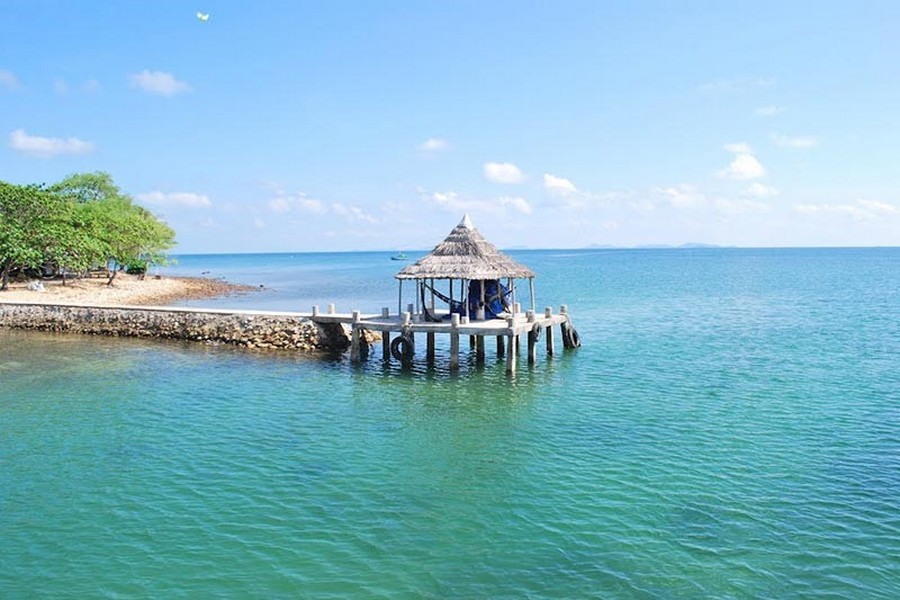
Top 10 most beautiful islands of Vietnam
10 Reasons To Visit Vietnam That Make Your Trip Unforgettable
Our newsletter.
Get free consultation on designing your travel itinerary in Vietnam
Plan Your Dream Trip to Vietnam & Southeast Asia!
Get a FREE custom itinerary designed just for you by our travel specialists.
How It Works:
(1) Share your name, email and preferences.
(2) Get your custom itinerary within 24 hours.
(3) Enjoy a memorable trip designed just for you
Don’t wait! Take the first step toward your dream vacation now.
Get Your Free Quote Today!
- Your Name *
- Your Email *
- Your Message
Rate this post
Travel Guide Vietnam
Book your individual trip , stress-free with local travel experts
Select Month
- roughguides.com
- Travel guide
- Itineraries
- Local Experts
- Travel Advice
- Accommodation
Plan your tailor-made trip with a local expert
Book securely with money-back guarantee
Travel stress-free with local assistance and 24/7 support
Elisabeth and Alain Wilbois
This e-mail is to express how we enjoyed the trip we had with Henry as driver and guide, all over Malaysia. Henry was very committed in his role: he could ...
Despite its tumultuous history, Vietnam has bounced back to become a big-hitter on the Southeast Asian travel circuit. Unsurprisingly, from a country so long and skinny, there’s plenty of variety on offer: emerald paddy fields and white-sand beaches, full-tilt cities and venerable pagodas, limestone islands looming dramatically out of the sea, vast caves, craggy mountains, and friendly minority communities – with their elaborate tribal costumes and age-old customs. Travel to Vietnam and you’ll be met with warmth and curiosity. Add to that, some of the region’s most nuanced cuisine, and you’re onto a winner.
Where to go in Vietnam
Best time to travel to vietnam.
- How to get to Vietnam
Top 7 best places to visit in Vietnam
Vietnam travel itineraries.
While Hanoi , Ho Chi Minh City and the other major centres are intriguing enough, it’s Vietnam’s striking landscape that most impresses. Rugged mountains hug the west, bordering Cambodia and Laos ; to the east lies the South China Sea – or the East Sea, as the Vietnamese call it. To the north and south, the land fantails out into the splendid deltas of the Red River and the Mekong , and it’s in these regions that you’ll encounter the paddy fields, dragonflies, buffaloes and conical-hatted farmers that constitute the classic images of Vietnam.
As for wildlife, the discovery in recent years of several previously unknown species of plants, birds and animals showcases the wealth of Vietnam’s biodiversity. This makes the improving access to the country’s national parks all the more gratifying for travellers wanting to visit Vietnam.
- Spoken language : Vietnamese (majority of population).
- Official unit of currency : dong (VND ₫).
- Population : 95 million. Around two-thirds live in the countryside (one of the highest rural population densities in Southeast Asia), yet the country has a literacy rate of around 95 percent.
- Tourist numbers : two million in 2000; fifteen million in 2018.
- Politics : The Socialist Republic of Vietnam (capital Hanoi), is one of the world’s last surviving one-party Communist states. It shares land borders with China, Laos and Cambodia and comprises over 330,000 square kilometres, with more than 3400km of coastline.
- UNESCO World Heritage sites : Vietnam has eight. Phong Nha-Ke Bang National Park is home to Hang Son Doong, the world’s known largest cave.
- Visas: Some nationalities are exempt from visa requirements. Travellers from the UK need a visa if staying longer than 45 days. Find out more and get your Vietnam visa .
Want to know even more useful information about Vietnam before your trip? Read our Vietnam travel tips .
Travel to Vietnam and you’ll discover there is no shortage of beautiful and intriguing places to explore. Experience the buzz of vibrant Ho Chi Minh City, or captivating Hanoi, with its lively Old Quarter and mouth-watering street food, while the alluring riverside town of historic Hoi An in central Vietnam makes for a more mellow experience.
The Central Highlands affords fantastic trekking opportunities and other outdoor pursuits, with the breezy mountain town of Da Lat providing the ideal base, while a visit to the remote upland regions of central and northern Vietnam is likely to focus on the ethnic minorities who reside there.
Explore the pancake-flat rice lands of the Mekong Delta with its wonderful floating markets, and meander between Ha Long Bay ’s striking limestone forested islands.
Of course, a visit to Vietnam wouldn’t be complete without some relaxing beach time . Take your pick from the gorgeous golden beaches in the south, such as Doc Let beach, on the Hon Khoi Peninsula, and enjoy some superb swimming and snorkeling – as well as exquisite seafood.

Sunrise in Golden Valley near Da Lat © TBone Lee/Shutterstock
Discover more places in Vietnam

- North Vietnam Travel Guide
- The Mekong Delta, Vietnam
- The northern coast Travel Guide
- The Southern Coast Travel Guide
Vietnam is long and slender, with different regions subject to different weather conditions at any one time, which makes figuring out the best time to visit Vietnam somewhat tricky.
The country has a tropical monsoon climate. If you’re visiting the south of the country the driest months tend to be between December and April, while the north of the country is typically driest in spring and autumn.
Within this broad weather picture are regional variations, with differences in altitude also key to varying temperatures. Whereas the south tends to have a year-round tropical climate, the north is considerably cooler in winter.
You can still enjoy a visit to Vietnam during the rainy season, but it’s worth bearing in mind that if you’re intending to go trekking, monsoon downpours can mean flooding in certain areas, and transport can be severely disrupted. You’ll also have to put up with a lot more mosquitoes. On the plus side, there are fewer visitors. Find out more about the best time to visit Vietnam here .
The number of international flights heading to Vietnam has been steadily increasing of late – a fair sign of the country’s burgeoning popularity as a tourist destination.
The vast majority of visitors fly into Ho Chi Minh City and Hanoi, although a fair chunk of visitors still take the cheaper option of an indirect flight routed through Bangkok, Singapore or Hong Kong.
Taking an indirect flight might be your only option if there are no direct flights available from where you intend to travel. While you can fly direct from London, for example, there are no direct flights from Ireland, North America, New Zealand, and very few from Australia. Take a look at Skyscanner for options.
If you’re coming from one of Vietnam’s neighbouring countries, you can fly from several cities, taking advantage of the low cost flights available through budget airlines.
Or, you can enter Vietnam overland from China , Laos, or Cambodia. It’s pretty simple as long as you have the appropriate visa, and this option means you can see more of the region than you would if you simply jetted in.
There are several options for travel within Vietnam. Though still a little rough around the edges, its transport network is continuing to improve. Comfortable buses operate regularly and fares are cheap, or you can travel by coach. If you’re going long distances, booking a berth on an overnight train could be an appealing option. Or, there are cheap domestic flights available, making it possible to visit different ends of the country in a short space of time. Read more about how to get to Vietnam and how to get around Vietnam .

Bout tours around Ha Long Bay © S-F/Shutterstock
1. Sample Hoi An delicacies
Little Hoi An has an almost bewildering selection of mouth-wateringly good restaurants, offering up specialities, such as Cao Lau – rice-flour noodles in soup flavoured with mint and star anise, topped with slices of pork, bean sprouts and pork-rind croutons. The elegant restaurant Morning Glory is one of the best places to try it, along with other superbly prepared dishes, for a reasonable price. You can also try your hand at Vietnamese cooking by taking one of many cookery classes available in town.
Discover 10 Vietnamese foods you need to try .
2. Cruise around Ha Long Bay
An exploration of Ha Long Bay in northern Vietnam is a must for any visit to Vietnam. Dramatic limestone rock formations which jut straight up from the water make up the two thousand or so forested islands. Visit the enchanting caves via one of the tours available and, if you can, make time for one of the three-day tours, as you get to spend a night at sea. Swimming and kayaking around the bay’s bright green waters is a glorious experience.
3. Trek around Sa Pa
On a clear day the views around Sa Pa in the far north of Vietnam are breathtaking. Lush terraced rice fields line the steep valley and mountains loom from all sides. It’s the gateway to fantastic trekking country and the reason most visitors come here. Explore the Hoang Lien Son Mountain range, home to Fan Si Pan, Vietnam’s highest mountain, and visit the small ethnic communities still living a traditional way of life.
4. Relax on Phu Quoc Island
Picture postcard Phu Quoc island in the Gulf of Thailand is no longer a well-kept secret. Word is out about its powdery white-sand beaches facing glorious sunsets, its dense jungle, and the laid-back atmosphere of the island. But even though visitor numbers are up, there is still plenty of unspoiled creamy soft sand in which to dig your toes. You can also paddle around the bays in a kayak, or dive around the reefs, weaving among colourful tropical fish and perhaps a hawksbill turtle.
Around half of the island is part of a UNESCO-listed national park and remains pretty much untouched. You’ll find hiking trails in its tropical rainforests, and a fantastic array of wildlife.
Zipping on a motorbike is a great way to explore the island’s back roads and quiet fishing villages.
5. Hike and bike around Da Lat
Dubbed the city of Eternal Spring for its year-round cool climate, this former hill station in the Central Highlands, with its winding streets and French colonial-era villas, is the place to head when the heat in cities below becomes stifling. Combine a visit to the splendid Bao Dai’s Summer Palace with the Crazy House, a fairytale riot of twisted cement.
But it’s the area surrounding Da Lat that’s the big draw. Fragrant pine forests and dramatic waterfalls beckon, and alongside hiking there’s the opportunity for mountain biking and rock climbing – or, for those seeking greater thrills, canyoning. You can also rent a motorbike for a bit of adventure, and it’s a great way to explore more of the area.
For a more sedate experience, enjoy the beautiful view via the cable car to the Truc Lam Pagoda.
6. Stay in a Stilthouse on The Pu Luong Nature Reserve
This spectacular nature reserve in the northern coastal area of Vietnam is as yet comparatively unknown to outsiders. Trek amid magnificent rice terraces, and visit the white Thai or Muong minority groups, some of which offer home-stay accommodation. You can help prepare a meal and join in with family life, and then bed down in a thatched stilthouse.
7. Soak up the sights and smells of Hanoi
A visit to Vietnam wouldn’t be complete without a visit to its capital city. Hanoi , with its constant buzz of motorbikes and general hubbub is the place to experience city life at full throttle. Wander the sinuous streets of the Old Quarter, with its narrow red roofed tube-houses, temples and pagodas, and whir of street vendors. Perch on a plastic stool and watch the hectic world go by over a cup of Vietnamese coffee or glass of beer.
Check out the atmospheric French Quarter, with its impressive Opera House, and visit the many cultural and historical sites, such as the Ho Chi Minh Mausoleum and Museum of Ethnology.
Everywhere you go you’ll be hit with the scent of delicious street food, such as the traditional breakfast dish of pho, a beef noodle soup.

Busy streets of Hanoi © John Bill/Shutterstock
The carefully created travel itineraries in our Vietnam travel guide will inspire and help you make the most of your trip. Combining the classic tourist sights and busy cities with laidback beaches, quiet temples and remote mountain villages, where you’d be hard-pushed to find another visitor, there’s an itinerary to match your interests and suit your time frame – whether you have a month to travel in Vietnam, or just a week or two. And don’t worry about seeing everything – each of the routes will give you a good taste of the country.
Travel ideas for Vietnam, created by local experts

10 days / from 2150 USD
Vietnam Culinary Discovery
Vietnamese cuisine can be divided into three categories, each pertaining to a specific region, namely the North, Centre and South. You will visit all of these on this culinary tour of Vietnam. Awaken all of your senses to the wonderful sights, sounds and aromas of this fascinating country.

16 days / from 2150 USD
Very Vietnam
Vietnam is full of surprises, seamlessly mixing both ancient and modern. See rice paddies, traditional villages, markets, temples and pagodas. Discover romantic cities, cruise around mystical Halong Bay, laze on pristine beaches and get out and about in exuberant Ho Chi Minh City.

4 days / from 550 USD
Cultural Saigon
Southern Vietnam is home to modern Ho Chi Minh City, a vibrant southern capital full of historic attraction and old Saigonese charm. Soak up some café culture, enjoy authentic street food, and get a taste of the city’s thriving markets.
If you have a month to travel around Vietnam the Grand Tour could be the one for you: it’s the classic itinerary, packing in the essential sights, bustling cities, beautiful beaches, rural Vietnam, and much more. If you have a week or two and want to focus on Vietnam’s ethnic minority groups residing in the north, the Ethnic Culture tour is ideal. And if you have just a week and want to get off the beaten track go for the Unseen Mekong Delta itinerary.
Below is a sample itinerary, ideal for the first-time visitor to Vietnam, but you can see all our itineraries here .
Quintessential Vietnam
You’ll get a taste of everything with this itinerary: big cities, historical and cultural sights, idyllic beaches, boat trips, intriguing caves, unspoiled countryside, homestays in rural villages, and more. Allow sixteen days, or longer if you want to take things at a more relaxed pace.
Start off your tour in Vietnam’s capital and enjoy its busy yet laid-back vibes. Visit some of the principal sights in Hanoi : the Ho Chi Minh Mausoleum, and the nearby One-Pillar Pagoda, the Military History Museum, or the Ethnology Museum, and the Temple of Literature, Vietnam’s principal Confucian sanctuary and its historical centre of learning. Wander around the Old Quarter and take a stroll around Hoan Kiem Lake. Sample delicious street food and watch a traditional water puppet show in one of the famous theatres.
2. Ha Long Bay
Take a two-day boat tour around some of the two thousand or so dramatic limestone islands and intriguing caves of the World Heritage Site Ha Long Bay , Vietnam’s top draw. Enjoy the magical scenery while swimming in the emerald green waters around Titov island beach. Tours can be arranged from Hanoi.
3. Mai Chau and Ninh Binh
Just a few hours away by road Hanoi, The Mai Chau valley is largely unspoiled.
Hop on a bicycle and explore the surrounding rice paddies nestled against forested mountains, and wander around Mai Chau’s bustling morning market. Then visit the nearby White Thai villages to spend the night in a homestay.
Drive to Ninh Binh, the ideal base from which to visit beautiful Tam Coc, essentially a miniature landlocked version of Ha Long Bay, and an easy cycle ride from Ninh Binh. Take a boat trip through the limestone tunnels and between karst hills to the three long, tunnel caves at Tam Coc itself.
Travel to the engaging city of Hue and take a day-long boat trip along the Perfume River to visit the Thien Mu Pagoda and Hon Chen Temple, the Imperial City, and the Tu Duc mausoleum. At the end of the day have a wander through the lively Dong Ba Market.
The next morning take a bicycle, or tour by cyclo, along the north bank of the river to tranquil Kim Long village, where mandarins and other Imperial officials built their houses surrounded by lush gardens, in the late nineteenth century.
Drive to Da Nang via the Hai Van Pass, or “Pass of the Ocean Clouds”, taking in the superb views of Da Nang Bay. Stop off at the Cham Museum in Da Nang, with its impressive display of terracotta and sandstone figures. Then continue to Hoi An .
Wander the narrow streets, soaking up historic Hoi An’s charming old-world atmosphere, with its old merchants houses and wooden-fronted shops. Visit some of the sights, such as the Phuoc Kien assembly hall, the Museum of History and Culture and the beautifully preserved eighteenth-century Tan Ky House. It’s worth tying in your visit to coincide with its monthly lantern festivals – candle-lit paper lanterns meandering down the river is a magical sight.

The riverside town of Hoi An © Judyta Jastrzebska/Shutterstock
6. Nha Trang
Cosmopolitan Nha Trang combines cultural highlights with stylish restaurants and lively bars, and 6km of glorious sandy coastline offering prime opportunities for swimming, snorkeling and other watersports.
Visit the wonderful Po Nagar Cham towers, built between the seventh and twelfth centuries by the Hindu Cham people, and then take a look around the Long Son Pagoda.
Then head for one of the city’s gorgeous beaches, such as Tran Phu beach, closest to the city action and backed by a great promenade, the quieter Hon Chong beach, or the more secluded and pristine Bai Dai beach.
Move on to Da Lat , 1500km high in the Lang Bian Plateau. Visit the splendid Summer Palace of Emperor Bao Dai, and the gaudy Crazy House. Enjoy the Da Lat flower gardens and then set off for Ho Chi Minh City, stopping en route to visit tea, coffee, or rubber plantations.
8. Ho Chi Minh City
Embrace the bustle of the metropolis and see some of city’s main sights: the Notre Dame Cathedral, the History Museum, the Jade Emperor Pagoda, the Reunification Palace, the War Remnants Museum. Take a wander around Cho Lon, the city’s Chinatown, sample street food at Ben Thanh market and, come sundown, stroll along pedestrianized Nguyen Hue.
Take a day-trip from Ho Chi Minh City to the Cu Chi tunnels at Ben Dinh or Ben Duoc, a system of tunnels created by the Viet Cong during the Vietnam war.
An alternative day-trip is to the wonderful countryside around Ben Tre in the Mekong Delta. Explore by boat the many creeks along the Ben Tre coastline and stop off at rice-wine and sugar processing workshops.
Travel advice for Vietnam
From travel safety to visa requirements, discover the best tips for traveling to Vietnam
- Crime and personal safety tips Vietnam
- Eating and drinking in Vietnam
- Getting around Vietnam: Transportation Tips
- Travel Health Vietnam
- Shopping tips for Vietnam
- Sports and Outdoor activities in Vietnam
- Tips and travel advice for Vietnam
- Best time to visit Vietnam
- Vietnam Weather in September
- Vietnam Weather in November
- Vietnam Weather in June
- Vietnam Weather in July
- Vietnam Weather in December
- Vietnam Weather in August
- Vietnam Weather in January
- Vietnam Weather in February
- Vietnam weather in March
- How to get from Hanoi to Halong Bay
- How To Get From Hanoi To Da Nang
- How to get from Hanoi to Sapa
- Vietnam Weather in April
- How to get a Vietnam visa
Before you go to Vietnam, make sure you have up-to-date travel advice. From insurance information to shop opening hours, tipping etiquette to advice on travelling with kids – our Vietnam travel guide offers tips and advice to cover all you need to know.
Costs and money
Vietnam’s unit of currency is the dong, which you’ll see abbreviated as “đ”, “d” or “VND” after an amount. The American dollar is also widely used and it’s a good idea to carry some dollars as a back-up to pay large bills.
Daily expenses, for example, admission charges to historic sites, for food and drink (especially if you do as the locals do), are low, and it’s almost always possible to haggle. Tipping, while not expected, is always appreciated – 10% is the norm in a restaurant.
For budget accommodation expect to pay between $6-10 for a bed in a dormitory, $15-25 for a simple private room; allow between $35-80 for mid-range accommodation, and for high end the sky’s the limit.
Temples and pagodas are usually free.
Culture and etiquette
Vietnamese society is both conservative and fairly tolerant, so it’s best to follow these simple rules to avoid causing offence: shorts and sleeveless tops fine for the beach, not so at religious sites, and nudity on the beach is a no-no. Women in particular should dress modestly.
As in most Asian countries, it’s not normal to get outwardly angry. Passing round cigarettes (to men only) is always appreciated and is widely used in negotiations, bargaining and so forth.
Electricity
The electricity supply in Vietnam is 220 volts. Plugs generally have two round pins, though you may come across sockets accepting two flat pins and even some that take three pins. Power supplies can be erratic in the sticks, so be prepared for cuts and surges.
It is essential to have a good travel insurance policy to cover against theft, loss and illness or injury. It’s also advisable to have medical cover that includes evacuation in the event of serious illness, especially if you’re doing any motorbike touring. Check your policy specifically covers you for motorbiking in Vietnam and ascertain whether benefits will be paid as treatment proceeds or only after you return home, and whether there is a 24-hour medical emergency number). If you’re planning on doing any ‘dangerous’ sports, check your policy for cover.
In the event that you have anything stolen, you must obtain an official statement from the police.
Internet and email
In the major cities and tourist centres, most cafés and hotels provide wi-fi, and smaller towns are catching up. Unfortunately, some top-end hotels still charge a hefty fee for the privilege of getting online.
Opening hours
Basic hours of business are 7.30–11.30am and 1.30–4.30pm. The standard closing day for offices is Sunday, and many now also close on Saturdays, including most government offices. Most banks tend to work Monday to Friday 8–11.30am and 1–4pm, but there are variations, with some open evenings and weekends, so check. Post offices generally stay open from 6.30am until 9pm.
Shops and markets open seven days a week and in theory keep going all day, though in practice most stallholders and many private shopkeepers will take a siesta. Shops mostly stay open late into the evenings, perhaps until 8pm or beyond in the big cities.
Officially, homosexuality is regarded as a “social evil”, alongside drugs and prostitution. However, there is no law explicitly banning homosexual activity and, as long as it is not practised openly, it is largely ignored. For more information, consult the excellent Utopia Asia website .
Mobile phones
If you want to use your own mobile phone in Vietnam, the simplest – and cheapest – thing to do is to buy a SIM card locally (or even a phone, if your own is locked). It’s best to go to stores run by the major operators – you’ll find them at the major international airports (bring your passport, too).
Travellers with special needs
Few provisions are made for the disabled, and so it’s important to contact airlines, hotels and tour companies as far in advance as possible to make sure they can accommodate your requirements. Getting around can be made a little easier by renting a private car or minibus with a driver; taxis are also widely available in all cities.
Travelling with children
The Vietnamese adore kids and make a huge fuss of them. The main concern will probably be hygiene, as Vietnam can be distinctly unsanitary. So avoiding spicy foods will help while their stomachs adjust. Bear in mind that healthcare facilities can remain basic outside Hanoi and Ho Chi Minh City, so make sure your travel insurance includes full medical evacuation.
There are reduced fares for children on domestic flights, trains and open-tour buses. On trains, for example, it’s free for under-5s (as long as they sit on your lap) and half-price for children aged 5 to 10.
Working and studying in Vietnam
Without a prearranged job and work permit, you shouldn’t bank on finding work in Vietnam. English-language teaching is probably the easiest job to land, especially if you have a TEFL, TESOL or CELTA qualification. You’ll need to apply for a work permit, sponsored by your employer, and then a working visa.
The main English-language teaching operations recruiting in Vietnam include the British Council, ILA Vietnam Language Link Vietnam and RMIT International University. The TEFL website and Dave’s ESL Café also have lists of English-teaching vacancies in addition to lots of other useful information.
There are also opportunities for volunteer work. Check the websites of the VUFO-NGO Resource Centre and Volunteer Abroad .

Sandy coastline of Nha Trang © HelloRF Zcool/Shutterstock
Travel visa requirements for Vietnam
Most foreign nationals need a visa to visit Vietnam – citizens of some Asian and Nordic nations get 15–30 days visa-free, and from 2016 the government allowed the same of passport-holders from the UK, France, Germany, Italy and Spain, although this is for a limited time so do check with your local consulate.
To apply for tourist visas, you have to submit an application form with passport-sized photographs (procedures vary) and the fee. The visa is valid for entry via Hanoi, Ho Chi Minh City and Da Nang international airports and any of Vietnam’s land borders open to foreigners.
Visas are generally valid for thirty days, though longer durations can be arranged; make an application in any Vietnamese embassy or consulate, or through a specialist agent, although it’s quicker (a few days, as opposed to around a week) to get a “visa on arrival” online. There are several reliable websites offering this service, such as the Vietnam Visa Center .
Present your approval letter, photographs (they can take one at the airport, for a fee) and application form (available at airport desks) to immigration on arrival, and the stamping fee. The process is very easy and efficient but note that they can only be picked up at Hanoi, Ho Chi Minh City or Da Nang airports, not at land border crossings.
Thirty-day extensions can be arranged at travel agencies in Hanoi, Ho Chi Minh City, Nha Trang, Da Nang, Hue and Hoi An. In general, they take three days to process and cost from US$25. Overstaying your visa will result in a fine of US$10–25 per day, and border staff at the airport may insist that you head back into the nearest city, in order to pay the fine at an immigration office.
A full list of Vietnamese embassies and consulates is available at Vietnam Visa Center.
Business visas are valid for one month upwards and can be issued for multiple entry, though you’ll need a sponsoring office in Vietnam to underwrite your application.
One-year student visas are relatively easy to get hold of; for example, if you enrol on a Vietnamese language course at one of the universities, though you’ll be required to attend a minimum number of classes per week to qualify. It’s easiest to arrange it in advance, but you can enter Vietnam on a tourist visa and apply for student status later – the only downside is that you may have to leave the country in order to get the visa stamp.
Travel safety in Vietnam
Vietnam is a relatively safe country for visitors and the Vietnamese are generally welcoming to foreign visitors. Petty crime is on the rise on a relatively small-scale and shouldn’t be a problem if you take common-sense precautions: don’t wear expensive jewellery, carry your passport and other important documents concealed in a money belt, and keep a close eye on your bags when travelling on public transport, particularly if they’re on a luggage rack, or on top of a bus.
Also, when walking or riding in a cyclo you are vulnerable to moped-borne snatch thieves, so don’t wear cameras or expensive sunglasses hanging round your neck.
The place you are most likely to encounter street crime is in Ho Chi Minh City , which has a fairly bad reputation for bag-snatchers, pickpockets and con artists. Be wary of innocent-looking kids and grannies who may be acting as decoys for thieves – especially in popular tourist hangouts.
Petty crime is also a problem in Nha Trang , where you should watch your belongings at all times on the beach. Be wary of taking a cyclo after dark and women should avoid walking alone at night.
Unexploded ordnance from past conflicts still poses a threat in some areas. Wherever you are, stick to well-trodden paths and never touch any shells or half-buried chunks of metal.
Drug laws in Vietnam
Possessing or selling prohibited drugs in Vietnam is extremely unwise. Drug laws in Vietnam are strict, with fines and jail sentences are imposed for lesser offences, while the death penalty is regularly imposed for possessing, trading or smuggling larger quantities.
Female travellers in Vietnam
For solo female travellers, Vietnam is generally a safe country. However, it’s best to take the normal precautions if you’re a woman travelling alone; avoid taking a cyclo by yourself, and use taxis from a reputable agency.
(Last updated: October 2019)
The Rough Guides to Vietnam and related travel guides
In-depth, easy-to-use travel guides filled with expert advice.

Find even more inspiration here

Planning your own trip? Prepare for your trip
Use Rough Guides' trusted partners for great rates
written by Rough Guides Editors
updated 14.05.2024
Ready to travel and discover Vietnam?
Get support from our local experts for stress-free planning & worry-free travels.
- Where to stay
- Travel advice

Vietnam Travel Guide
Looking for an in-depth Vietnam travel guide ?
Then you’re in the right place!
Thanks to its stunning natural beauty in places Ha Long Bay and the Mekong Delta, bustling cities with incredible street food, and fascinating culture and history, Vietnam is an unmissable destination in Southeast Asia .
It’s also extremely affordable, and visitors will find that their money stretches far in Vietnam when it comes to food, hotels, and transportation.
Keep reading to dive into resources from Jessie on a Journey as well as its sister site Epicure & Culture that will help you with planning a trip to Vietnam.
Note: This guide to Vietnam travel contains affiliate links to trusted partners!

Vietnam Map
Use this Vietnam travel map to begin planning your trip!
Click here for an interactive version of the above map.
Best Places To Visit In Vietnam
Learn about the top places to visit in Vietnam .
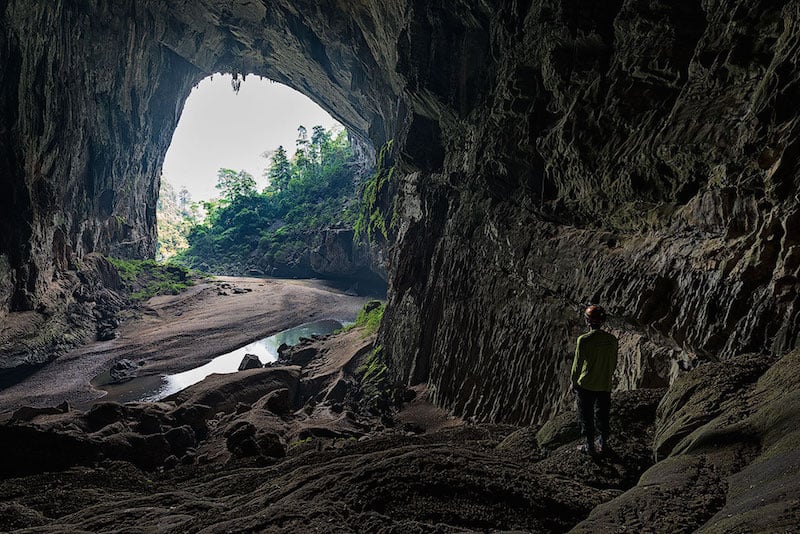
Stunning Images From The World’s Largest Cave In Vietnam
Solo Travel, Local Culture & Going Beyond The Guidebook In Vietnam
Vietnam Travel Advice
Use these Vietnam travel tips to plan the perfect trip.
My Unwanted Paparazzi Moment On Cat Ba Island In Vietnam (Important Lesson Included!)
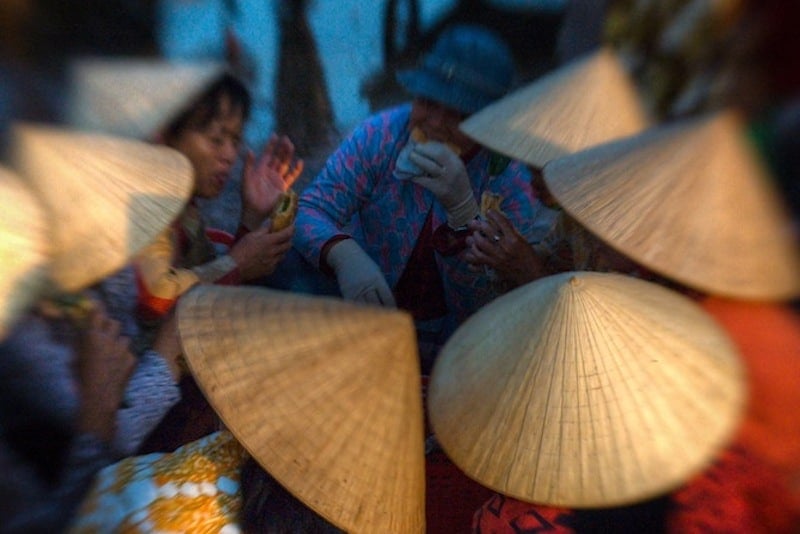
Top 10 Vacation Destinations In Asia
Vietnam Food Trip
Explore the country on a virtual Vietnam food tour with these travel resources.
A Guide To Southeast Asian Culture Through Spices

The French Influence On Vietnamese Cuisine
Asia Travel Tips
This Asia travel advice can help you plan the perfect trip.

24 Best Places For Solo Travel In Asia
Top Vietnam Tours
Check out these fun tours in Vietnam from my affiliate partner, Viator:
- Cooking Class in Local Villa with Market Tour (Seasonal Local Wine Tasting) in Hoàn Kiếm
- Saigon Evening Food Tour By Scooter in Ho Chi Minh City
- Overnight Sapa Tour from Hanoi
These excursions will help you learn about Vietnam from a local!
Vietnam Travel Insurance
It doesn’t matter if you’re traveling solo or with a group on a Vietnam tour. When visiting Vietnam — or any other country in the world — make sure to get travel insurance to protect your health and safety.
In my opinion, the best travel medical insurance for travelers is SafetyWing as they’ve got a large network and offer both short-term and long-term coverage — including coverage if you’re traveling for months as well as limited coverage in your home country).
Additionally, SafetyWing is budget-friendly and offers $250,000 worth of coverage with just one low overall deductible of $250.
With coverage, you’ll have peace of mind as you embark on your Vietnam itinerary.
Click my referral link here to price out travel insurance for your trip in just a few clicks .
Vietnam Hotels
Click here to browse hotels in Vietnam!
Prefer self-contained stays?
Click here to check out unique local rentals!
You can also use this map to search for local stays:
Renting A Car In Vietnam
Need a rental car for your Vietnam trip?
Use Discover Cars to quickly compare your car rental options.
Vietnam Travel Guide FAQ
Below, find answers to frequently asked questions about traveling Vietnam .
Q: Is Vietnam safe for tourists?
Vietnam is a safe country for tourists to visit. In fact, it’s one of the best destinations for a solo trip to Asia .
There is very little violent crime; however, tourists should be vigilant when it comes to petty theft and scams, especially in popular tourist destinations.
Q: Is Vietnam cheap to travel?
Vietnam is a very budget-friendly destination! Like many places in Southeast Asia, your money will go far in Vietnam.
A typical backpacker budget is around $30 a day, while a mid-range traveler may want to budget $60-$75 a day.
If you’re on a budget while traveling Asia , definitely add Vietnam to your itinerary.
Q: Can you travel Vietnam by train?
Yes, train travel is one of the best ways to get around Vietnam!
Trains in Vietnam are comfortable, affordable, and scenic. Although they can be slow, they offer great views and a good value for money.
Q: What are some Vietnam travel do’s and don’ts?
Things you should do in Vietnam:
- Do dress conservatively, especially when visiting temples or pagodas
- Do keep an eye on your belongings at all times, especially in tourist areas
- Do learn a few basic phrases in Vietnamese, such as hello, please, and thank you
Things you should not do in Vietnam:
- Don’t take photos without asking for permission first, especially in rural areas or villages
- Don’t expect public restrooms to have toilet paper – always bring your own with you!
- Don’t miss out on trying Vietnamese street food
Q: Do I need a visa to enter Vietnam?
Citizens of most North American and European countries will need a visa in order to visit Vietnam. Visas must be applied for in advance.
It’s recommended to view your country’s Vietnam International Travel Information page for the most up-to-date information on entry and exit requirements. You can also contact the Embassy of the Socialist Republic of Vietnam.
Q: What are some must-try street foods in Vietnam?
Vietnam has some of the best street food in the world!
Experience Vietnam through delicious dishes like pho (a hearty noodle soup), xoi (sticky rice laced with various options like pork or fried egg), and banh mi (a tasty baguette sandwich).
Q: What are some great Vietnam tourist places?
When visiting Vietnam, some tourist spots not to miss include Ho Chi Minh City (aka Saigon), Phú Quốc Island, Mekong Delta (aka the Western Region), Vũng Tàu, Halong Bay, and Ninh Binh, which is a town just an hour-and-a-half from Hanoi, which another great destination.
It’s also easy to get to other countries in Southeast Asia and the rest of Asia from Vietnam, like Hong Kong, Thailand, and Laos.
Q: What is the local currency in Vietnam?
The local currency in Vietnam is the Vietnamese đồng.
What would you add to this Vietnam travel guide?

Enjoyed this guide to Vietnam travel? Pin it for later!

Vietnam Travel Guide
Last updated on May 18, 2024 by Shannon

While lumped together with Southeast Asia for geographic and tourism purposes, Vietnam stands out as a destination unique among its neighbors. Each region balances the other.
The frenetic chaos in Saigon is just a stone’s throw from the sleepy colonial towns in the Mekong Delta. Hoi An’s charming, historic ancient town is a mere 40 minutes from the fast-growing and friendly Danang.
History and tradition infuse every aspect of life in Vietnam—from food to religion—and the culture and people are remarkably welcoming to tourism, having built a thriving industry that makes traveling and backpacking in Vietnam unforgettable.

As such, modern Vietnam is a favorite hotspot for budget-loving backpackers traveling Southeast Asia , and destination travelers from all over the world. Although I had spent years traveling other regions of Asia, Vietnam was my final country to visit on mainland Southeast Asia. What an incredible experience.
I have no idea what took me so long to backpack through Vietnam. I spent three months traveling south to north and I discovered cities across the country highlighting various aspects of Vietnam’s long history. I traveled from the War Remnants museum in Ho Chi Minh City to the Japanese and Chinese influenced Hoi An to the French-influenced coffee and baguette culture throughout.
Vibrant, unique, chaotic, traditional—no single word sums the experience of traveling Vietnam.
If you’re visiting Vietnam, this guide covers the essential travel information you should know, pre-trip reading , how to travel responsibly in Vietnam, and specific travel and accommodation recommendations to jumpstart your research.
Table of Contents
Is it safe to travel in Vietnam?
Vietnam is safe for travelers on the physical level—you don’t have to worry about bodily harm from the Vietnamese people. That said, theft is an issue and the scams center around money. Travelers should never walk the streets with cameras and bags draped on their shoulder or a motorbike might speed by and grab it from you.
Wear your purses cross-body and cameras secured to your wrist or neck. For the same reason, don’t walk with your cell phone held away from your body (consider investing in a phone leash ) they are fantastic and give peace of mind when wandering).
In touristy areas especially, count your change. Confirm your taxi fare before the ride (or just use Uber , which is what I did—it’s explained more in the transportation section). Use TravelFish to research possible scams in places like Hanoi , Hoi An and Saigon . Since anything can happen on the road, I am a firm advocate of travel insurance and I always carry IMG Global travel insurance .
In addition to the safety concerns listed above, many travelers rent motorbikes and scooters in Vietnam. This is a dangerous place to learn to ride. In the months I visited, I saw dozens of travelers with serious road-rash scarring their bodies.
If you rent a motorbike, please make sure it’s covered by your travel insurance (usually only if you are licensed to drive in your home country) and that you wear the proper gear to protect you if you fall (pants and good shoes). If you have respiratory issues, pollution is a problem in both Hanoi and Saigon, so bring a surgical mask.
Fast Facts About Vietnam Travel
Vietnamese Dong (VND) ( current exchange rate )
Electricity
127V/60Hz (American or European plugs both work here, although only without the third prong)
Primary Airports in Vietnam
- Saigon’s Tan Son Nhat Airport (SGN)
- Hanoi’s Noi Bai Airport (HAN)
- Da Nang International (DAD).
Can you drink the water in Vietnam?
No, it’s not safe to drink the local water in Vietnam. Drink bottled, bring a reusable water bottle so you can buy big jugs, or consider the merits of a SteriPen or LifeStraw for your trip.
How’s the internet in Vietnam?
WiFi is rampant and thoroughly spread even into the smallest of Vietnamese towns. Saigon has a bustling café culture and these coffee shops all offer fast free WiFi. It’s also a standard amenity in all hotels and guesthouses.
You’ll need a VPN if you plan to access many U.S. sites and to stream U.S. Netflix. A VPN is also crucial for those working from abroad since many U.S. sites either IP block or serve an international version of their sites. I’ve used NordVPN since 2016 while living abroad and it’s never failed me once.
Local SIM Cards
Data is very cheap in Vietnam, even the tourist bundles (locals have different rates, so ask your first guesthouse owner to buy your SIM card if you’re a data hog and really need a lot).
I paid 70,000 Dong for 16 GB lasting three months, and the tourist rate is about 150,000 Dong for 8 GB lasting two months. Because I had so much data, I tethered my phone and worked from my data when I encountered slow speeds. Read a full Vietnam SIM card guide here .
And it’s handy that NordVPN works on my iPhone, too.
Vietnamese Visas
The visa situation for North Americans changes often and is entirely unpredictable. That said, in early 2017, the government implemented an online e-visa program that is fast, safe, and affordable.
For more information, check the visa requirements here . While most visitors had to arrange a visa through a third-party company, that is no longer the case, so use the government site directly to avoid fees.
Festivals of Note
- Tết is the country’s New Year’s celebration and is huge throughout Vietnam (late January or early February).
- Lantern Festival in Hoi An (14th day of every lunar month—not calendar month—so research to find out when it’s happening).
Food Considerations
Vietnam is one of the best food destinations in Southeast Asia. The country has a vibrant street food culture and a range of different dishes from north to south. If you are vegetarian, it’s possible to find food, but not always street food. And you have to be diligent.
On my Vegetarian in Vietnam guide , I outline the considerations and obstacles. If you’re celiac, this is a fantastic and thorough post , complete with a downloadable GF translation card .
This post shares the most common street food dishes you will find, and this book chronicles a beautiful food journey through Hanoi. And if you decide to eat street food (which you will!), follow these food safety principles .
Pick out accommodation on Booking.com.
This is the only booking platform I use because it rewards you for loyalty, and I regularly score free breakfasts and 15% off my hotel.
Accommodation
The links in city guides below go to my favorite hotel booking site, Booking.com many options are also found on or VRBO , if you are member.
For backpackers and families, Booking.com is perfect for pre-booking hostels and hotels; in high season the bigger towns book up fast ( Hostelworld has a solid selection of hostels, too).
And if you buy a local SIM (which you should), you can easily call ahead and directly reserve spots en route. If none of these will do, check out my detailed guide to finding good places to stay .
What’s the weather like?
Vietnam is long, with a varied topography, meaning at least one region has poor weather at all times of year. This chart is by far the best visual to use in planning your trip weather-wise (although note that Jan/Feb is noted as clear for Sapa, when in reality it’s bitterly cold and often very foggy).
How much should you budget to travel in Vietnam?
Vietnam may well be the most budget-friendly location in Southeast Asia, and that is saying a lot, because nearby Thailand , Laos , Cambodia are quite affordable. Budget backpackers sleeping at hostels and eating street-food will easily stay under $20 a day.
The only activity requiring you to splash out on cash is a Halong Bay Tour—and often you will get better value for a bit more if you choose your tour company wisely.
Mid-range travelers will spend $25 a night on nice accommodation (with A/C and spacious rooms), and another $10-20 on food. High-end travelers get a lot bang for their buck as even nice hotels and food are affordable—scale up from the mid-range budget of $45 a day depending on if you choose to splurge on food, accommodation, or both.
How to Get Around Vietnam
Most backpackers in Vietnam take an overland route starting in one of the two primary cities, either Hanoi in the north or Saigon in the south. Vietnam offers train travel in many areas and buses in others—you can suss out the best routes around Vietnam on Bookaway .
It’s a very long country, so keep that in mind when you consider timing your trip. The distances are longer than you expect and if you’re cramming the entire country into a short week or two-week trip, you will need some long overnight trains and buses to navigate it all.
Air travel is another option. VietJetAir is the country’s privately run low-cost carrier and you can find fares as low as $25 to hop around the country. This is mega convenient and I recommend using SkyScanner to search for fares since it includes all the regional low-cost airlines.
Locally, when you are within a city you will likely use mototaxis and taxis to navigate. Uber operates in this area and you can even catch a mototaxi with it! Instead of haggling with xe om drivers, I used Uber exclusively in the cities.
And because of the taxi scams in Saigon and Hanoi, I stuck with Uber getting to and from the airports and such, but if you need to hail a cab, stick to either Vinasun or Mailinh.
If you have a local SIM, Grab is the regional version of Uber and offers slightly better rates. Either option works, I used Uber because I already have an account that I’ve used in dozens of cities around the world; I highly recommend that travelers at least sign up for Uber and have it in your phone because you never know when it will come in handy to summon a ride and get out of a sticky situation (happened to me in South Africa!).
History to Know Before Traveling to Vietnam
Vietnam has a lengthy and complex history, with each layer still visible in modern Vietnam. From tangible evidence of French colonial rule to the aftereffects of the American War and a food culture deeply influenced by the international flavors and cultures—this country has a lot on offer from north to south.
Vietnam has a lengthy and complex history, with each layer still visible in modern Vietnam. Consider this a quick rundown on the basic backstory you’ll need to understand and enjoy traveling and backpacking through Vietnam. Ruled by the Chinese in 111 B.C., Nam Viet (what we now know as Vietnam) was a part of the Han Dynasty.
Over the next thousand years or so, Vietnam remained in the hands of the tyrannical Chinese, before regaining full control of their country in the 15th century. By the middle of the 17th century, Vietnam’s independence was being chipped away by France and in 1884 France gained full colonial control over Vietnam.
France’s impact on Vietnam is a living, breathing, tangible part of modern Vietnam, which is why you need to understand this history before traveling there. The French brought a Western-style education system, European architecture and food, and also instituted political and cultural changes.
Not surprisingly, despite some good brought by the French, many Vietnamese were unhappy with colonial rule. The Viet Minh attacked French forces in 1946, which eventually ended with Geneva peace talks between the nations and the decision to split Vietnam in half: north and south. The communist insurgency began 1957 in South Vietnam; two years later, weapons and men from North Vietnam began gathering in the south.
In response, the United States increased aid to President Ngo Dinh Diem. By 1963, the Viet Cong, a communist group specializing in guerrilla warfare, defeated The Army of the Republic of Vietnam. In a U.S.-backed military coup, representatives from The Army of Republic of Vietnam overthrew and killed the President Diem ; U.S. intervention in Vietnam would only escalate from this point forward.
In response to the threats posed by the North Vietnamese and the Viet Cong, by 1967 the U.S. had sent roughly 500,000 troops to Vietnam. The Vietnam/American War lasted far too long, fueled by poor decisions made by U.S. politicians and resulting in horrifying escalation of violence throughout the war (this is a sad and informative visual history of the war ).
Many thousands of people were killed before Paris peace talks brokered a ceasefire agreement in 1973. By that point, the actions by American troops had forever changed the country as the after-effects of Agent Orange and other chemical weapons continue to impact the Vietnam even today.
Two years after U.S. troops left, North Vietnam invaded the south and took control of the country. As the socialists assumed control over the country, hundreds of thousands of Vietnamese continued to flee, many resorting to crowding into small vessels—anything to escape life in Vietnam. This war is one key reason for the massive Vietnamese diaspora spread around the world.
It’d be great if the warfare ended there, but tired of the Khmer Rouge attacking remote villages near the border, Vietnam invaded Cambodia in 1979 and removed the Khmer Rouge and Pol Pot from power. Ten years later, Vietnam removed their troops from Cambodia. There is still a large ethnically Khmer population in Vietnam’s Mekong Delta region. Since the 90s, Vietnam has grown and the government has stabilized, with tourism a major contributing part of the country’s economy.

Pre-Trip Reading Inspiration: Books About Vietnam
Fiction & Nonfiction Books About Vietnam
- Catfish and Mandala : Travel memoir is often an intriguing way to learn about the culture. A Vietnamese-American return to the Vietnam he left as a young child when his family moved to California. He bicycles around the country, and the journey is beautiful.
- The War. There are no shortage of books about the Vietnam-American War. If you read just two, go with The Sorrow of War , a harrowing recounting of the war and aftermath written from the perspective of a North Vietnamese soldier, and Embers of War , a Pulitzer Prize winning account of the long path of policies and leaders that eventually led to the devastating war.
- Saigon: An Epic Novel of Vietnam : For historical fiction that perfectly accounts the war, but contextualizes it with romance, politics, story, and intrigue, this novel is a better read for those less inclined to learn about the war through drier non-fiction books.
- The Beauty of Humanity Movement: A Novel : Showcasing modern Vietnam in the context of its war-torn history, this beautiful novel takes place in Hanoi and is an easy read. If you’re looking for a better cultural look at contemporary Vietnam, however, Vietnam: Rising Dragon is my recommended non-fiction read.
- Inside Out and Back Again : A beautiful and lyrical story written from the perspective of a 10-year-old girl. This is a wonderful family-friendly read if you are traveling Vietnam with children.
- Eating Viet Nam : A journalist moves to Hanoi and begins a food journey through the back alleys and tiny street stalls of Vietnam. A great read for food lovers.
Podcasts and Online Reads
- The Sandwich that Ate the World : A close look at the history of bánh mì, a tasty Vietnamese sandwich that is wildly popular in Vietnam, and how that love has spread around the globe.
- The History of Pho : This longread recounts the history of Vietnam’s other famous dish, loved the world over: Pho.
- The Vietnam Solution : An interesting piece about current American and Vietnamese relations and how the two countries overcame the war to work together in modern politics.
Find more regional fiction and nonfiction books and long-reads .
Recommended Guidebook
I traveled through Vietnam using the Lonely Planet Vietnam . It was solid. It had just the right amount of detail I needed to understand the nearby travel options.
I used online booking sites ( Booking.com ) for accommodation, and then the Lonely Planet to help figure out transportation and what to do nearby.
Socially Responsible Travel in Vietnam
Let’s talk about socially responsible travel in Vietnam, as well as the greater opportunities in Southeast Asia. This topic has many layers. From volunteering to donating to beggars to choosing ethical activities. It’s a complex situation.
Animal tourism has a dark side, and responsible travelers should research alternatives. Child sex trafficking and tourism is particularly an issue in Vietnam. Environmental pollution from tourism has devastated parts of Halong Bay.
There are a lot of considerations. All travelers should also read this post on giving to child beggars ; you will face this conundrum, so it’s best to be ready. Read our full Vietnam Responsible Travel & Social Enterprise Guide (and one more general responsible travel in Southeast Asia to lessen your impact on any place you visit, then read below for specifics to Vietnam.
Let’s jump into activities you might want to do, as well as alternatives that are just as fun! And at the end, I share tips for responsible volunteering in Vietnam.
Engaging in Human Tourism
Vietnam is among the most unique places to participate in hill tribe tourism. Unlike the sketchy ethnic group tour options in Thailand , northern Vietnam has a well-developed infrastructure of hill tribe groups offering homestay and trekking. Most notably, Sapa O’Chau has a wonderful business model employing and supporting hill tribe communities.
Also, throughout Vietnam, home stays are a common and excellent way to respectfully visit rural communities, support the local economy, while also learning a lot about the people and culture. Use the regional and city guides below for links to community-based tourism options, and responsible tour companies throughout Vietnam.
Riding an Elephant
If you’ve long dreamed of riding one of these majestic creatures, you should read up on their treatment and what it takes to actually break an elephant’s will enough for it to perform tricks and ferry around tourists. It’s a sad industry and one that has grown exponentially alongside tourism.
Traditionally, the Southeast Asians used elephants for hard labor, to help clear land and forests. They make more money from tourism, however, and this has led to a cycle of overworked and abused animals. On the flip side of the debate , feeding an elephant costs a lot, and tourism (including rides) help mahouts afford to properly care for their elephant. It’s a complex, complicated issue.
There are options though! To the best of my knowledge, there are no responsible elephant experiences in Vietnam. There are, however, several sanctuaries in Thailand and Cambodia that offer responsible traveler-elephant interactions. Travelers love the responsible experience .
These sanctuaries are doing wonderful work to give elephants a home and a peaceful life. Avoid elephant experiences in Vietnam, and check out the Save Elephants Foundation to plan a visit in Thailand or Cambodia.
Side note. Generally, avoid riding any exotic wild animal. Riding ostriches in Dalat is gaining popularity and it’s beyond unfortunate. An ostrich’s body is not designed to hold an adult’s weight and these animals fully panic when ridden.
Buying Endangered Animal Products
Vietnam has a massive industry built around selling, exporting, and trafficking in exotic wild animals. Likewise, many of these animals are used for tourist souvenirs. Avoid purchasing anything made from wild or endangered animals—turtle shells, skins, ivory, etc. And do not buy exotic animal meat or turtle eggs for consumption. Engaging in these practices is either illegal or contribute to the continuation of these destructive practices.
To ensure you’re buying authentic, ethical souvenirs handmade in Vietnam, shop at any of the fair trade shops that offer unique gifts made my vulnerable groups.
Haggling Too Much
Bargaining is a fun part of the culture in Vietnam, and it’s surely something you should engage in freely when buying fruit, souvenirs, and even tours. But be warned that certain over-touristed locations have started a dangerous precedence for the locals.
In Hoi An, for example, the prevalence of so many tailor shops has driven prices so low that some locations will accept a commission and lose money rather than lose business (the fabric is a sunk cost, so some are willing to lose net money if it means food on the table that night).
Bargain respectfully and remember, your sale is directly helping the local economy, so spend money and feel good about infusing your cash into the local economy.

Volunteering
Many travelers are keen to volunteer or support responsible businesses on the road. If you’re backpacking Southeast Asia, you may want to stop for a few weeks or months and support a cause near and dear to your heart. Since not all NGOs and volunteer companies are doing great work, consider this list of vetted independent volunteer opportunities in Vietnam .
Supporting Responsible Businesses
Vietnam has standout social enterprises operating all over the country. I highlight a few in the city guides below , and I profiled my absolute favorite social enterprises in Hoi An . Consider researching all of the options for supporting social enterprises on your trip .
Supporting social enterprises is one of the easiest ways to create a trip with positive impact. This means picking businesses that are using funds to support local communities and to offer training, support, or to protect natural resources. You can do everything from get a massage or pick a trekking guide—all with companies committed to social impact.
Don’t forget to book travel insurance for your trip —a great policy provides coverage in case of medical emergencies, lost or stolen gear, adventure sports riders, and more. I’ve used IMG Global for more than a decade highly recommend it !
Best Things to Do in Vietnam

Starting in southern Vietnam, I spent three months backing north through Vietnam. Many travelers pick a direction for their Vietnam travels since the country’s long and skinny shape lends itself to this style of travel—if you’re backpacking across Southeast Asia , your clockwise or counter-clockwise route through the region will determine where you start.
I used a combination of buses, trains, and budget airlines to skip over some long distances, but it’s super common for adventurous travelers to rent a motorbike and ride the length of Vietnam either independently, or on a tour, while exploring the vast number of things to do.
Three months doesn’t make me an expert, but I did find information was surprisingly scarce in some areas (the Mekong Delta), so I offer these city and regional suggestions below as an accounting of how I did the trip, great accommodation I discovered, and my favorite social enterprises and tasty eats.
My Favorite Experiences in Vietnam
- Sipping tea at the Reaching Out Teahouse in charming Hoi An .
- Boating through the Ha Long Bay region from Cat Ba Island.
- Boating through the karst rocks in Tam Coc.
- Spending lazy days in the sun-drenched colonial towns in the Mekong Delta region.
Best Things To Do in Saigon
Humidity, noise, and a friendly face greeted me when I landed in Ho Chi Minh City airport. My friend James has lived in Ho Chi Minh City (known as both HCMC and Saigon) for several years, and he met me at the airport and served as my official welcome party over the next two weeks I visited the city.
We mowed down on spring rolls the first night, and then toured a range of tasty veggie spots and coffee shops around the city. I am far from the expert on this massive, vibrant city, so I polled my global community of travelers for inspiration and guidance during my time.
And I researched, a lot. I detail the handful of things I did before I traveled south to the Mekong Delta, and I’ll link out to other fantastic resources that will allow you to eat and sightsee your way around Saigon.
Take a self-guided walking tour of District 1 highlights.
Most tourists stay in D1 and spend most of their time exploring this part of the city—it holds the bulk of the historical monuments, museums, buildings, and markets. Grab a map or use your smartphone to walk the city.
You could start at Ben Thanh market, then pass the Ho Chi Minh City Hall and head toward Notre Dame Cathedral and Central Post Office—each of these are beautiful structures.
Be sure to enter the post office and look at the old city maps along the walls. From there, you can either head to a coffee shop along the waterfront and beat the heat of the day, or loop around to visit the two primary museums that tourists should visit.
Visit the Reunification Palace and the War Remnants Museum.
You could combine this with your walking tour, or fill a different afternoon with these two activities. Each one is a must visit, though if you had to pick just one, I recommend that all Americans should visit the War Remnants Museum for a sobering take on the Vietnamese-American War.
Spend a half-day visiting markets and temples in Saigon’s Chinatown, Cholon.
Either take the bus or a mototaxi to Cholon in District 5. This makes for a fascinating morning wander, especially for photographers or those keen on visiting architecture and temples. Check out this blog post for all the details —I saved the map offline to my phone, then used it as a guide throughout the morning.
I started at Binh Tay Market (furthest point east of D1 on the map), and walked back toward District 1, zig-zagging through town to see the buildings, pagodas, and churches. I summoned an Uber back to D1 once I had reached the end of the marked Cholon sites. All told, it took three to four hours at a very leisurely pace.
Hang out at a coffee shop.
The coffee culture is alive and huge throughout Vietnam, but especially in Saigon, where local chains dot every corner and hipster boutique coffee shops hide in plain sight. Many cafes have balconies overlooking busy intersections or streets, making for prime people-watching.
These cafes are also the ideal place to work from if you have a bit of travel planning research or work on your docket. This post has a map you can use to find an expat’s extensive list of quirky, fun, and unusual coffee shops throughout the city.
Take a day trip.
There are several popular day trips from HCMC. The Củ Chi Tunnels is the most common and you can join a tour bus from the backpacker district for less than $10 for the day (negotiate, negotiate, negotiate). You could also head to the beaches of Vung Tau . Although I skipped this day trip in favor of flying to Phu Quoc , Vung Tau is a popular day or weekend spot that is quite easy to get to from HCMC, from what I am told.
Lastly, you could take a day tour to the Mekong Delta—it’s a canned tourist experience with heavy sales pressure at points, but if you’re pressed for time, you could get a taste of the Delta on the day trip (I opted to spend nearly two weeks in the Mekong Delta and below I detail how you can navigate the sun-drenched delta towns).
If you go for the day or overnight tours, consider researching more creative tour experiences, like the Delta by Vespa , or a private guide navigating you by motorbike through the interesting towns.
Sip coffee at Quán Cà Phê Cheo Leo.

This is a completely local spot beloved by those who sip local iced coffee and tea throughout the day. The owner has been written up in several local publications for her decision to continue preparing the coffee using traditional methods.
Grab your coffee from a new spot every morning.
Chances are that your guesthouse or Airbnb has several neat coffee shops nearby. Star this free Google map of the city’s coffee shops and try a new one every day.
Eat something tasty in Saigon.
Vegetarians in Saigon will find a wide range of tasty eats, although it’s hard to eat street food throughout the city unless you know where to look. But there are a plenitude of tasty vegetarian restaurants. Use Saigon Vegetarian and Happy Cow for initial ideas, and I marked a few of my favorite spots on the Google Map. Although many of the vegetarian street eats are sweet and dessert-like, I’ve included a few street food stalls on the map, too.

- Sample tasty food at Hum Vegetarian, Cafe & Restaurant . (32 Võ Văn Tần). Convenient place to eat just near the War Remnant’s Museum. It’s mid-range price but the dishes are beautifully prepared, the setting is lovely, and I highly recommended eating here. It offers both Western and Vietnamese dishes, but there are plenty of tasty dishes that do not rely on fake meat.
- Find evening street eats near Mani Vegan . (291/2 Võ Văn Tần). Although I didn’t sample this restaurant, there is a street food stall out front that serves delicious vegetarian soups and spring rolls. She’s there most nights and was the only one serving food on that corner, but be sure to confirm it’s “chay” before eating.
- Use this street food guide to eat well in Saigon . It includes a rundown of the dishes, as well as where to find them in the city.
Sleep somewhere central in Ho Chi Minh City.
With several weeks in HCMC, I tested out a couple of accommodation locations before settling on a VRBO located on a quiet street about halfway between the Ben Than market and the Pham Ngu Lau backpacker/party district. J
ust a six-minute walk to either area, it was central without having a party vibe and few other tourists. Those on an extreme budget and those wanting proximity to the backpacker scene will likely stay in Pham Ngu Lau, others should look for a place walking distance to the main sights in District 1.
- Book a VRBO in a central spot . Vacation rentals in HCMC average about $30-60 for a modern room that sleeps two people and often includes a kitchen nook where you could store breakfast items. Some have multiple bedrooms or beds and can sleep more, or a few even offer penthouse views for a bit more money.
- Stay at a central hotel . Uber-budget travels should look at Vintage Hostel Saigon and La Hostel Saigon . Midrange options are plentiful, including Ngoc Phan Guesthouse and Town House 50 Saigon (both a hotel and a hostel), and for a nicer central spot, consider Cap Town Hotel .
Phu Quoc Travel Guide
Phu Quoc surprised me with its lovely vibe and laid-back beaches. After years of avoiding the party vibe on the busiest of the Thai islands, I had feared that Phu Quoc would follow a similar fate.
Well, it’s not there yet. I tacked this trip on the end of my three months and I flew round trip from Hanoi for less than $100—Vietnam’s budget airlines have amazing deals. So, with flights secured I enjoyed a full week down south, with my last days coinciding with Tet holidays.
I had anticipated either the place would be packed, or everything closed. In reality, most of the island is open during Tet, but the restaurants tack on a surcharge to every meal. You’ll find quiet beaches during the day, and a bit of a party at night, if you want it.
The night market underwhelmed me, but it’s there if you want seafood and souvenirs one night. Otherwise, head to a resort or bungalow for beach time. The island has a lot of investment income—new airport, new roads, new resorts, etc.
So it’s developed, but in the anticipation of large-scale tourism, which it’s not there yet. It’s a beautiful island and I recommend at least a few days here, especially if you are at the end of your travels and need to detox a bit.
Enjoy pristine sands at Sao Beach.
Located a 30-minute motorbike ride from Long Beach, this is the most gorgeous white sand beach you can imagine. It’s very lightly developed, so pack snacks, sunscreen, and a good book.
While there are many chair and towel rentals just near the parking lot, walk further down the beach for shady palms and open sands. To get there, I rented a motorbike from my accommodation and drove out there for the day with a travel friend.
Sleep somewhere budget but nice.
Stay at Kim Lien Phu Quoc Guesthouse for private budget accommodation. This guesthouse offers a convenient location and basic but clean accommodation.
Although the bungalows are not beachside, you are incredibly close. It’s a one minute walk through Rory’s Beach Bar to reach the sand and sun. The family is exceedingly lovely too, and I enjoyed my time there.
Splash out some cash for a great sleep.
Splurge for luxury at La Veranda Resort . While I didn’t stay here, I chatted with a Canadian couple several mornings in a row who use this resort as their go-to vacation spot in Vietnam. The husband works for Vietnam Airlines and they escape here on long weekends.
Sip drinks at Rory’s Beach Bar .
This spot is pricey by Vietnamese standards and it’s straight-up Western, which is sometimes welcome. The Aussie owners serve the best cappuccino on the island and offer creative Western dishes if you are jonesing for a change of flavors. It’s also the central backpacker hangout spot on Long Beach, so head here if you want drinks and a bit of a party vibe in the evening.
Eat at September Vegetarian.
September Vegetarian (141 Trần Hưng Đạo) offers creative vegetarian fare and tasty smoothies. The restaurant is right on the main street, so the location is unfortunate, but the staff is friendly and the food is great.
Enjoy beach-side barbecue.
Around sunset, all the beachside restaurants on Long Beach set up barbecue stations and display fresh, iced fish and seafood. While expensive, my traveling friends said their meals were spectacular. Walk along the beach at sunset and you can peruse the selections and find ones that hit your price points and food preferences.
Things to Do in Hoi An
My custom Google Map shares a full list of cafes and vegetarian friendly spots and you can easily save this map and see it overlaid on your own Maps app while you’re in town.
I was in Hoi An for several weeks, so I visited many places. For that reason, the cafes and restaurants are just my favorite spots that I found myself returning to time and again.
Visit the historic sights in Old Town.
You’ll buy a pass at one of the entrances to Old Town. This pass includes entrance tickets to any five of the 22 UNESCO World Heritage Sites. Each time you enter one, you’ll need to hand over your pass and they will snip one ticket.
Admire the Japanese Bridge.
The Japanese Bridge (Chùa Cầu) is obviously gorgeous and worth visiting and photographing, but the shrine inside is quite small and I don’t recommend that you hand over a ticket to visit—you can walk across the bridge with just your tourist pass, no ticket required. No matter how hard they try to snip your pass, don’t let them unless you’re keen to see the shrine.
Photos from the bridge are lovely, although you will likely want to circle around to the small footbridge that gives you reflective views of the Japanese bridge in the water. Visit both day and night as it looks entirely different and they do a great job illuminating the structure.
Take in the vibes as you photograph Old Town.
Hoi An is seriously pretty. It’s also seriously touristy. More so than any other spot in Vietnam, you will find yourself navigating waves of Chinese and international tourists.
The crowds thicken throughout the day, so your best bet for gorgeous photographs is to roll out of bed early and stroll through town at sunrise. That’s when the sunshine-yellow houses look most atmospheric and you’ll be one of the few tourists up that early as the locals rush through breakfast and preparations for the day ahead.
This is a great blog post outlining timing and how to get gorgeous photographs in and around Hoi An . I was crushed that I couldn’t take this photo tour , but the photographer was away leading a tour in Burma, so I’ll have to do it next time.
Visit all of the main sights at night, too!
Lanterns light the streets of Hoi An and it just couldn’t be more picturesque. If you enjoyed the city during the day, it’s time to take a look at your favorite parts at night, too.
Wander the central market.
You’ll find a labyrinth of food stalls inside of the central market, and numerous fruit and vegetable sellers lining the streets around the market. This is a good spot for lunch (there is one veg-friendly restaurant in the northeast corner inside), and also just interesting to see and experience the bustle of locals going about their daily business.
Sip tea and support a social enterprise.
Stop by the Reaching Out Teahouse (131 Trần Phú). Visiting this teahouse was a highlight of my time in Hoi An. It’s a quiet sanctuary away right in the center of Old Town. While the streets can be crushingly busy, the teahouse is run as a social enterprise employing deaf people from the local community.
The staff communicate through gestures, small word blocks, and notes. It’s thoroughly lovely and I recommend the tea or coffee tasting and sampling all the handmade sweets. Read my full profile on this delightful social enterprise.
Visit the temples and historic halls.
There are several main temples that travelers should explore to soak in Vietnam’s cultural heritage. One key significant site is the Quan Cong Temple, dedicated to General Quan Cong, adorned with exquisite carvings and remarkable craftsmanship.
Additionally, the Phuc Kien Assembly Hall, Trieu Chau Assembly Hall, and Quan Thang Ancient House are must-visit destinations, each showcasing distinctive architectural features and offering insights into the town’s history and multicultural influences.
The map above shows the five places I think you should visit in Hoi An if you buy just one tourist pass while in town. These include the three ancient houses of: Tan Ky, Duc An, and Quan Thang. Also visit The Museum of Trade Ceramics, and Phuoc Kien Assembly Hall—the most impressive of the ones in Hoi An.
The Museum is low-key and the most interchangeable of the recommendations, so consider visiting a second assembly hall if you’re not keen on reading about the history of trading and how that built Hoi An.
Bike the rice paddies (and stop for coffee and treats!).
Many guesthouses provide free bicycles for your use, or you can easily rent one in town. While you can use the bike to navigate around town, you should also head out on the road toward the beach and get lost in the rice paddies.
It’s nigh impossible to actually get lost, so you should instead wander through narrow lanes and dig deep into this rural slice of life right outside of touristy Hoi An.
You could also stop by Jack’s Cat Cafe for a coffee and cat cuddles—this social enterprise supports strays.
Visit the beach.
Near the beaches, try P&B Restaurant for food (corner of Nguyễn Phan Vinh and Hai Ba Trung) and Sound of Silence for a coffee—it’s has a great indie vibe.
Enjoy delicious vegetarian eats.
Eat something great at Minh Hien Vegetarian Restaurant (50 Trần Cao Vân). This is the best all-around vegetarian restaurant in town. They have an extensive menu with a range of options. This is a good spot to try vegetarian versions of local Hoi An specialties. They also have an informal cooking class every afternoon.
Other great vegetarian eats include:
- STREETS Restaurant Café was one of my favorite nice dining experiences in the city. This social enterprise is right in Hoi An’s old city and has a hospitality and culinary training program for disadvantaged young people in the community. The restaurant not only provides opportunity to youth but also funding to the work of STREETS INTERNATIONAL, an organization that develops and operates sustainable programs for street kids and disadvantaged youth in SE Asia and throughout the world. I LOVED their vegetarian cao lau (this is a dish local to Hoi An) and you should try it here (they have a non-veg version too).
- Bánh mì Phượng . (2B Phan Châu Trinh). The most famous place in Hoi An for the iconic Vietnamese sandwich. The egg one is vegetarian option, but make sure to also reiterate that you want it vegetarian so that they don’t use pâté or any other meat ingredients. Meat-eating friends said it truly was the best banh mi of their entire trip through Vietnam.
- Sample other restaurants. Morning Glory has beautiful dishes of Vietnamese food and several tasty vegetarian options—it’s midrange prices but a great spot for meat-eaters to try the local Hoi An dishes. I deeply enjoyed the pizza at Good Morning Vietnam (near Morning Glory, the general Google Maps location is wrong; my map pinpoints it accurately). My custom Google Map shows all my other favorite spots. Or my friends Simon and Erin have shared a great guide to vegetarian restaurants in Hoi An , which provides a few recommendations that I did not include here.
Sample the best coffees in Hoi An—there are a lot!

- The Hill Station Deli & Cafe . (321 Nguyễn Duy Hiệu). A stunningly pretty spot, make sure you go upstairs. This is the most hipster spot in town and a surprisingly quiet setting to sit with a laptop or a book. If you’re into Instagramming against textured walls, you’ll be here doing that for hours. The menu offers artisanal cheeses and high-end charcuterie, as well as a mix of neat jams and other items from various provinces in Vietnam. The coffee is well-priced and equivalent to any place in town. The meals are a bit more dear, with most things starting at 100,000+ dong per dish. I spent Sunday mornings as the only person writing in the picture-perfect room upstairs.
- Faifo Coffee . This spot has excellent coffee and gorgeous upper floors with views of Old Town. Very chill place to sip coffee and relax.
Sleep somewhere nice.
- Midrange : Longan Homestay is my absolute top recommendation for budget to mid-range travelers. This spot is a four-minute walk to the Japanese Bridge entrance to Old Town, and an easy 15 minute walk to the backpacker street. It’s on a quiet side street, so you will get a good night’s sleep. Plus, it’s nice to be away from the action, but still so close. The family is so lovely and I spent two weeks here so that I could catch up on work while still exploring from a convenient base.
- Budget : Backpacker accommodation is condensed into one area, and it’s a bit intense if you’re spending anything more than a few days in town. Stay at Tipi Hostel for the a classic uber-budget backpacker option where you’ll meet new people and it won’t break the bank.
- Stay near the beach : To stay near the water, head to An Bang Vana Villas for budget accommodation, and Under the Coconut Tree for mid-range prices in a quirky setting.
Hue Travel Guide
Central Vietnam experienced historic flooding and rains during my visit, and this impacted my time in both Hoi An and Hue. For that reason, I don’t have a heap of information on what to do. I spent three days in Hue, and it rained buckets each day. I stayed close to town, wore sandals, used an umbrella and poncho, and explore anyhow.
Plus, I loved my guesthouse so much that I have to include it here. So if you are visiting Hue, you will need to use other guides too, but here are the things I loved from my friend time there.
- Stay at Hong Thien Ruby Hotel . One of the nicest places I stayed. The entire hotel is recently renovated. Although rooms are small, beds are cozy and all is spotless. It’s a great price too. Plus, the free breakfast is speedy and unlimited, and they always had welcome drinks and fruit plates when I returned from sightseeing. Can’t recommend it highly enough that you stay here while in Hue.
- Eat at Red Chili . There are many thoroughly tasty vegetarian items on the menu—good variety and well-flavored tofu dishes. The staff is friendly and didn’t mind when I camped out with a book and a hot tea one afternoon to beat the rain. It’s conveniently in the budget touristy area of town and makes for a great dinner or lunch.
- Eat at Lien Hoa Vegetarian Restaurant . This place is large and very popular with locals. The food was hit or miss for me as it’s heavy on the dishes made with textured fake meats. That said, the menu is extensive and it’s likely that there are many fantastic dishes (but the menu is not in English, so bring your cheat sheet of Vietnamese phrases and foods).
- Visit the Kinh thành Huế Royal Palace . The expansive Imperial City is a UNESCO World Heritage site and has large grounds and beautiful elements. Built in 1362, construction took 203 years to complete. This was the seat of religious and political power during the last royal dynasty in Vietnam, and visiting the Hue Complex is the primary reason many travelers pass through Hue.
- Venture out to Thien Mu Pagoda . Located on the river outside of town, this is a part of the UNESCO sites in Hue. Either arrange for transportation and a guide with your guesthouse, or you could easily bicycle out to this spot. This pagoda is included in the day tours outside of town.
- Consider using Hearts for Hue tour operators . Its main purpose is to improve the living conditions of the boat people in Thua Thien Hue Province, just outside Hue. It runs tours to local community projects as a way to generate income for its programs.
Hanoi Travel Guide
Densely packed and filled with history, visiting Old Town Hanoi is an experience unlike any other city in Vietnam. While some areas of Vietnam ooze charm (here’s looking at you, Hoi An), and in some the pace of life moves at a glacier pace (hello, Mekong Delta), Hanoi has a vibe entirely its own. The jumble of people, sights, smells makes every moment in the city feel alive.
I spent more than five weeks in Hanoi house sitting over the holiday season. The expats returned home for the holidays, and I had a gorgeous flat overlooking the lake in Tay Ho—the residential and quieter part of the city.
I spent one week of that time in a wonderful hotel in Old Town that comes with my utmost recommendation. While there are many guides to the city far more comprehensive than my own, here’s a brief list of my favorite places and sights.
Use your smartphone to zip around the city.
I used Uber almost exclusively in the city, although I used the public bus once or twice from the airport (so handy!), and used private VIP coaches between cities around Hanoi for my day trips.
This map has the Hanoi bus routes if you’re feeling enthused to sort it all out. If you don’t use Uber or Grab, you should only use one of three trusted taxi groups Mai Linh Taxi (0438-222-666), Taxi CP (0438-262-626), or Hanoi Taxi (0438-535-353).
Take a Hanoi Kids tour of Old Town.
Hanoi Kids is a social enterprise that offers free personalized city tours run by students who want to practice their English and learn of other cultures. Any donations go to the organization, not the guides, which keeps the entire exchange as this sweet experience of pure cultural exchange.
You can ask your guide to show you any aspect of the city—food, architecture, history, markets—and you will pay for their entrance fees into the sites, and any transportation, but nothing else.
I went on the tour after an ALA reader raved about her experience, and I echo her sentiments—it’s a fabulous way to see the city and you will end the day with a new friend. Highly recommend.
Visit the Temple of Literature.
This Confucian temple is gorgeous and a real highlight of the various temples in Hanoi. It was the first national university in Vietnam and it’s well-preserved and lovely to stroll the shady grounds on a nice day.
Walk around Hoàn Kiếm Lake and visit the temple.
Old Town circles this lake, so it’s easy to visit. Walk around the lake on a weekend morning and you will see many locals using the parks for exercise and enjoyment.
Relax at Omamori Spa.
Omamori Spa is a social enterprise that employs the blind, and the massages are spectacular. The only downside is that it’s far outside of Old Town, so you will need to use Grab or Uber for transportation. Call or email ahead for a reservation as it’s a small spot.
Organize a tour to Sapa with Sapa O’Chau social enterprise.
Sapa O’Chau is phenomenal social enterprise offering tours to Sapa with local guides and a lot of input from the indigenous groups you would visit. Includes treks, homestays, and most anything you’re interested in doing in Sapa.
Learn how to make your favorite Vietnamese dishes.
You’ve surely been mowing down on delicious Vietnamese food throughout your travels in the country, but you should consider learning the secret to all of those amazing flavors. Book a morning or afternoon cooking class with Rose Kitchen Hanoi to visit a local market for ingredients before having the chance to whip up your favorite Vietnamese dishes.
Try egg coffee!
You can’t leave Hanoi without sampling egg coffee, which is unlike anything you’ve likely tried before. Originating during the war, when milk was in scarce supply, the frothy, sweet egg coffee drink is delightful.
Although you will find many shops offering it, Giảng Cafe (39 Nguyễn Hữu Huân) is the best place to sample for the first time. Read more on the history of egg coffee , and this shop.
Pull up a tiny stool alongside locals for a delicious street food desert.
Mow down on chè, a local desert. On your evening wanders, stop by Chè 4 mùa (4 Hàng Cân), pull up a tiny stool among the locals, and point to whatever looks tasty. Although no one spoke English, the proprietress brought me the dish of the night, a sugary-sweet concoction with sesame and ginger.
Drink lots of Vietnamese coffee.
Vietnamese, in general, loves coffee, and Hanoians are no different. There are dozens and dozens of great coffee shops in Old Town Hanoi. Use the map to find my favorites when you’re out and about.
Eat something tasty.
If you’re on a gastronomic trip through Vietnam, then you should start your Hanoi travels by reading Eating Viet Nam , a chronicle of a journalist’s quest to eat the streets of Hanoi. Then try some of these wonderful restaurants in the city.
- KOTO Training Restaurant . (59 Van Mieu). This hospitality training restaurant aims to give at-risk and disadvantaged youth the possibility to learn and thrive in their lives. Located conveniently near the Temple of Literature, which you should visit, the food is priced mid-range and has many great Vietnamese dishes. It’s a social enterprise and mission worth supporting.
- Eat at the Hanoi Social Club . (6 Ngõ Hội Vũ ) . Delicious western food and has several great vegetarian options. It’s all very healthy and the vibe is cozy and nice, although very Western. There is live music certain nights during the week, so check the Facebook for details. Although not a formal social enterprise, the restaurant aims to hire those who have just finished the hospitality training programs.
- Sample favorite student street eats . This street food guide lists the most iconic dishes, and where the university students running Hanoi Kids go to find them.
Sleep somewhere central.
- Midrange : Mai Charming Hotel is my favorite spot in Hanoi . After several failed attempts at a good hotel, I found this budget to mid-range option, and then extended my stay since I so enjoyed my time here. Located near the cathedral, the staff go out of their way to make your stay amazing. Every single staff member learned my name and greeted me warmly, and provided great advice for onward travel. It’s central, cozy, and the free breakfast is filling. Rooms are newly renovated and bathrooms are modern—the most budget rooms are very small, but completely worked for one person. While there are certainly budget hostels, and pricier hotels, this place offers great value for money.
- Budget : Head to Hanoi Lotus Hostel for a nice budget travel spot. I booked a spot here after some long weeks of travel, when I was returning to the city and wanted to meet other travelers. There are many mega party hostels in Hanoi, and this seemed like a good alternative. A glitch in their system meant my booking didn’t go through (cue me scrambling for a place to sleep), but I did check out the place and would easily try again if I needed a hostel option in the city (they have a private room).
Mekong Delta Travel Guide
Many backpackers head to the Delta on a one- or two-day arranged tour from Saigon. This is a mistake. If you have a few days (or a week), head to the region as an independent traveler.
For me, I took the one-day tour to My Tho from Saigon and I brought my luggage with me and then journeyed on to Ben Tre instead of returning to Saigon with the tour bus. This is convenient if you want an easy ride out of town, but the tour is awful. It’s one of the worst packaged tourist experiences in my many years on the road.
Consider just heading straight to Ben Tre, or better yet, catch a bus to Can Tho, where I had a phenomenal tour organized from my guesthouse (more on that in second).
I took a mototaxi to Ben Tre from My Tho, and I spent two nights in Ben Tre, using my full day to take a long and scenic bike ride around the nearby islands. The next morning, I took a scenic cargo boat for six hours to Tra Vinh, a quaint and quiet city with a lively day market and a few interesting Khmer temples.
From Tra Vinh, I took a cheap and fast bus ride to Vinh Long, just 1.5 hours. Near Vinh long is the Cai Be market; it’s a larger market with the bigger boats selling bulk vegetables to vendors in the area. My tour left at 6am and returned by noon, so I took an afternoon bus to Can Tho, which was less than an hour away.
In Can Tho, I took a deep breath for the final push of early morning wake ups and river tours. I had the option of visiting the larger Cai Rang floating market and Phong Dien, or doing an alternative tour to Phong Dien and then a backwaters tour of the villages. I am so glad I did the second option as it was fascinating and exactly what I had hoped for in a tour of the Mekong Delta. From Can Tho, I took a cheap VietJet flight to Da Nang.
- Stay at the Oasis Hotel , this is the best accommodation option in town. It’s run by a Kiwi-Vietnamese couple, and the owner Ken is a character. It’s spotless, breakfast is tasty, and it has many cozy touches and a Western-style bed. Ken is a fountain of advice for onward travel too, especially if you are looking to explore the area off the path a bit.
- Relax with a drink . If you’re staying at Oasis, Coffee 3D is very close and is a great spot for an afternoon coffee or a sweet smoothie after dinner. It has wifi and a very relaxed vibe of teens and young couples hanging out.
- Bike through the countryside . Oasis provides free bicycles to guests and this makes navigating Ben Tre a cinch. Using the giant map painted on the guesthouse wall, I followed a route through the tiny paths and used tiny ferries to bike across two nearby islands. It was about an 18 kilometre ride that took about four hours with many stops for photos and coconuts to refuel—it was lovely.
- Visit the night market . Along the riverbank each evening you can find the usual street foods and wares for sale. It’s a pleasant, low-key town and the market reflects that.

- Visit the morning market . This morning market is my favorite in all of the Mekong towns. Tra Vinh sees few tourists and so the locals have a fresh and delightful joy in seeing you wander around. Many vendors beckoned me to their stalls and then asked to take their photo, or they asked me to photograph their son/cousin/reluctant brother, etc. It was a lovely way to spend the morning before my bus ride.
- Sleep somewhere central . Khách Sạn Thanh Trà is serviceable and central but completely underwhelming; this is where I stayed. They have several tiny rooms at backpacker to mid-range prices and will never be fully booked. If I go back, I will try Gia Hoa 2 , which looks just generally a bit nicer. Or consider staying in the rural areas at a nicer location, like the Coco Riverside Lodge , which looks a bit swanky and lovely.
- Stop at the Chùa Mạc Dồn pagoda . This is located very near to the bus station (which is on the outskirts a ways out of town) so it’s easiest to pay for your mototaxi/taxi to stop for a few minutes here before dropping you off at the bus station.
- Cai Be Floating Market . I organized the tour from my guesthouse and it had overtones of the My Tho tour, but nicer. The tour stopped at a coconut candy factory and honey farm, but it there was no pressure to buy and far fewer tourists. If you’re into the idea of visiting these shops and seeing how they make it, opt for a tour from Vinh Long. Alternatively, if you’re just interested in seeing the Cai Be floating market then you can bargain at the dock and arrange a morning tour with a guide who will motor you out to the market in a tiny boat, show you around, and then motor you back—I would do this option if I ever return.
- Van Tram Guesthouse is very near to everything and was perhaps the nicest value of all my time in Vietnam. The rooms are large and spotless. The only downside is the karaoke across the street until 10pm-ish. I had planned to stay at Hotel Ánh Hồng, but it was fully booked and I was good with Van Tram as my alternative since it turned out the most central budget option. Also, most tourists stayed on the island in a homestay. Having just come from very rural areas, I opted to stay in a guesthouse, otherwise, I had picked out the Bay Trung Homestay .
- Eat veggie food or at the local market . The owner of Van Tram Guesthouse did me a solid by scooting me across town to a hole-in-the-wall vegetarian restaurant. It’s linked on my custom backpacking Vietnam map . The market is just outside the hotel’s front door and makes a great dinner spot for non-vegetarians. If you’re wandering near the market at sunset, check the map and walk across the small bridge—great views and a long board walk on the other side makes for a wonderful stroll.
- Sip drinks riverside at Cafe Hoa Nắng . While I would not eat here, I did enjoy a coffee mid-afternoon and a cold been in the evenings. This is more than just a tourist spot, it’s favored with locals and makes for great people-watching.
Can Tho has an airport easily accessible from the city center. Viet Jet flies from Can Tho to various other cities around Vietnam (I flew to Hoi An/ Da Nang, and many travelers also fly to Phu Quoc or Hanoi). This was my last stop in the Mekong Delta before I jumped half-way up Vietnam to Hoi An.
The city is very plain; it’s primarily a stop-over point for travelers exploring the floating markets, or those en route to Cambodia. I actually traveled north, and then headed back down to spend a week lounging on the beaches in Phu Quoc—I highly recommended heading there after Can Tho so that you don’t have to back track.
- Visit Cai Rang and Phong Dien morning markets . Plan on a very early morning as the Cai Rang market begins as early as 5am. Many tours leave Can Tho around 5:30am so that you arrive while there is still a lot of activity. If you stay at a homestay then you will cut about an hour off of your morning commute to the market. These markets showcase a fading way of life. As bridges span more of the rivers, these floating markets are shrinking. It’s a lovely way to spend a morning.
- Stay at the Mekong Logis Guesthouse in Can Tho . I highly recommend this guesthouse; it’s among my favorite places that I stayed in Vietnam. The family is fantastic and so accommodating and the rooms are spotless and comfortable. The family goes out of their way to ensure you have all the knowledge and help that you need to enjoy Can Tho. I took Linh’s special tour. We rode motorbikes outside of town and then visited the smaller of the two markets by boat. After a tasty breakfast, we toured the smaller rivers and visited a few homes in the rural areas. She shares a lot about the culture and people as she shows you the region. The family speak French and English. Because I had already seen the market near Vinh Long, I appreciated that this tour included a few other aspects.
- Stay at the Nguyen Shack Homestay outside of town . I had definitely planned to stay here as my favored homestay in the Delta, but this place books up far in advance. It’s a lovely location and my best friend loved her time there so much that she wrote about the love story of the couple who run it . It’s outside of Can Tho proper and closer to the floating markets. You can arrange tours directly through them, too. And the market tours are generally cheaper from Nguyen Shack because you’ve already paid to travel outside of town.
Ha Long Bay & Cat Ba Island

This is a signature item on the bucket list for travelers in Vietnam. It’s a stunning UNESCO World Heritage site and worthy of a visit, truly. Before I visited, I had heard awful stories from travelers who had been scammed or disappointed by the experience of visiting Ha Long Bay.
The area is well trodden on the tourist path and, as such, there are a range of experiences on offer, and some are cringe-worthy. The moment that you step foot in the north of Vietnam, you will have no shortage of companies promising to arrange your Ha Long Bay excursion.
For my trip, I got myself to Cat Ba Island and only then entertained the various organizations trying to woo my business. I found a highly-acclaimed, locally-owned tour company and used them for a one-day trip around Lan Ha and Ha Long Bays. It was beautiful and I loved the experience. One of the sections below shares information for those also visiting via Cat Ba Island.
What Are Your Options?
- Book a Round-Trip Experience from Hanoi . If you are short on time, this is likely your best option. The companies will arrange for your transfer from Hanoi to the coast (about 4-5 hours all-in from Hanoi to the bay area). They will then put you on a boat for a one- to three-day liveaboard experience where you cruise around the karst rocks. The quality of your live-aboard varies wildly depending on your budget and your tour company. After your cruise, your tour deposits you back on a shuttle and brings you back to Hanoi.
- Stay on Cat Ba Island & Explore From There . Use the shuttle transfers to make the trip between Hanoi and Cat Ba Island (by way of Haiphong, since you’ll need to take a ferry to the island). From there, rent a room at the very affordable hotel rooms (private budget rooms are less than $10). Then organize either a day trip, or a multi-day experience. You will also have the chance to visit the beautiful national park on the island. From there, organize a shuttle back to Hanoi, onward to Sapa, or to Ninh Binh/Tam Coc.
- Visit a Different, Less Touristed Bay . Ha Long Bay has very likely reached peak tourism capacity. The UNESCO area extends across the entire Ha Long Bay Archipelago and to many other bays that are equally beautiful. When on Cat Ba Island, you are adjacent to Lan Ha Bay, which you can easily visit on a Cat Ba cruise. But there is one other main option that is just emerging on the tourism scene. Several travelers that I met in early 2017 had beautiful experiences on Bai Tu Long Bay. The boats running here are a bit pricier, but they are better maintained and it’s a far more remote and tranquil experience.
How to Choose a Tour Company
My hands-down best advice: Wait before booking. Do NOT allow any hotel or tour operator to pressure you into booking a trip before you have sat down with several companies and then researched them all on Trip Advisor.
The most common “scam”—which I use the word lightly because it’s not a full scam, it’s a case of unmet expectations—is to book you on a low-quality boat and take you on an underwhelming but well-trodden path. Some of the boats are dirty, dingy, and infested with rats or roaches.
When you book through a budget hotel or operator, there is no telling which company is actually running your tour.
Find a reputable company. Truly take your time deciding which company you use to book the multi-day cruises. I painstakingly researched before selecting Cat Ba Ventures , a locally run business of repute and was well pleased with the quality of my tour. Here are a few things to consider before booking.
- Quality of the boat . Many of the boats operating in Ha Long Bay are very old; some of the rock-bottom priced budget options are patently unsafe. There are high-end luxury boats, but you would likely have a good trip on a mid-range choice too, it’s not necessary to go luxury to have a good trip, it’s just necessary to know the quality of your boat. The less touristed bays tend to use newer boats from what the locals told me when I chatted them up on Cat Ba Island.
- Sights Visited . If you take a budget backpacker tour you can be 100% sure that you will share the bay each evening with hundreds of other boats, and your boat may tend toward the closer caves and inlets that don’t require much fuel for the boat to visit. If you do just one night, you really lack the time to visit anything in the remote areas of the bay. When you start from a different bay, or the island, you are able to see less touristed areas since you are starting far from the most popular tourist city, Ha Long City.
- Reputation . There are hundreds of tour operators booking trips. They dot every single corner of the northern cities. Use Trip Advisor to find one that you trust. Read the hotel reviews too for any associated properties as many guests book through the hotels and then include the review of the boat trip in their general review of that hotel. Hotels make a hefty sum from your tour package so they have an incentive to charge more and book you on the most budget option they can find. This happens a lot. Research.
- Price . The adage “you get what you pay for” proves true here. You don’t have to blow money to enjoy the trip, but I would highly recommend considering Cat Ba Island as a base for budget backpackers instead of the packaged trips to Ha Long Bay. You will pay about the same, so it’s still budget, but it’s just alternative enough to provide a better experience for the same price.
Cat Ba Island Travel Guide
- Get to Cat Ba Island with a shuttle service . Your hotel in Old Town can organize transport, or you can book it through either Good Morning Cat Ba (what I used to get there) or email Cat Ba Ventures to organize (that’s who I used to book onward trip to Tam Coc).
- Use Cat Ba Ventures for your boat excursion . This company has, by far, the best reputation on the island for a strong standard of service. The tours are priced mid-range, and the vibe on the boats is very nice since everyone paid a bit more to enjoy their trip. I took their one-day trip with kayaking. Cat Ba Local is much newer to the scene, but as of early 2017, feedback from other travelers indicated it was a more affordable alternative for budget travelers looking for something a small step down from Cat Ba Ventures but still well-run.
- Go rock climbing with Asia Outdoors . This is the only organization you should use if you are keen to organize rock climbing; it has a highly trained staff and was the original company pioneering the rock climbing scene in the region.
Day & Weekend Trips Around Northern Vietnam

The north of Vietnam is a gorgeous region of the country and has many of Vietnam’s most notable backpacker experiences. If you’re heading south, there are also gorgeous spots worth an overnight stay at the very least.
Tam Coc/Ninh Binh
- Stay at Nam Hoa Hotel in Tam Coc . I love this hotel so much. The staff is lovely beyond measure. The rooms are small but spotless and freshly renovated. It’s mid-range if you’re solo, but budget if you’re a couple and able to split a room. Breakfast included and an easy walk to town. Bike rental is free and the bikes are in great condition. Highly recommend that you use this as your base, I will stay here again.
- Homestay at Nguyen Shack . Although I loved Nam Hoa Hotel, I would be remiss to not recommend Nguyen Shack as a gorgeous homestay option. This tiny Vietnamese chain of bungalows is thoroughly lovely. If you’re after a home-stay experience then it will get no better than here. Book in advance as it is often fully booked.
- Eat at Sunflower Restaurant . Vegetarian options and is a low-key, locally run restaurant serving good food. There aren’t a ton of eating options in town, so this is a good lunch or dinner choice.
- Visit Hang Mua Cave by bike . The bike ride here is flat and easy, or you could ask the taxi to Tran An to stop here as well. However, you get there, hike to the top here for sweeping views over the river. My friend Jimmy visited, and his Tam Coc photos show just how beautiful it is at the top if the weather is on your side (it wasn’t the day I visited).
- Bike to Bich Dong Pagoda . This is a pretty spot and an easy ride from town. Although it’s not a “must visit,” if you have an extra afternoon in town, it’s worth visiting.
- Take a boat tour from Tràng An . If you’re staying in Tam Coc, rent a taxi for a couple of hours and take the boat tour from Trang An, rather than those offered in Tam Coc. The tours are run with precision since this is a UNESCO World Heritage site, and the scenery is stunning.
Onward Travel
Having spent years backpacking Southeast Asia across many trips, plan your time in the following locations.
Thailand » Chiang Mai | Digital Nomad Costs | Elephant Tourism | Loy Krathong | Songkran | Bo Sang | Transportation, Explained | Fun Facts
Vietnam » Hoi An | Eating Vegetarian
Laos » Luang Prabang | Gibbon Experience | Mekong River | Kuang Si Waterfalls | Pak Ou Caves | Vang Vieng
Cambodia » Angkor Wat | Apsara Dancing
Myanmar » Bagan | Inle Lake | Yangon | Hpa-An | Eating Vegetarian | Spirituality | Burmese Hospitality
How to Plan Your Time in Southeast Asia
📍 Navigate more effectively. Bookaway is super handy to assess the full range of transport options between two cities—it shows everything from flights to trains, buses, minibuses, and more. If you’re booking a rental car, I’ve always found the best deals on RentalCars.com .
🛏️ Find great accommodation . Agoda has the widest and most affordable selection in Southeast Asia. It’s part of the Booking.com family, but has better reviews for SEA. You can book hotels, hostels, and even vacation rentals.
❗ Yes, you need travel insurance . IMG Global is the travel insurance I’ve used for well over a decade of traveling solo, and with kids. Here’s why .
Book Tours Ahead of Time I use Get Your Guide to book locally run tours since I can assess the options, read reviews, and lock in a date.
✈️ Book affordable flights. Expedia and Skyscanner are the first places I look for low-cost flights .
🧳 Smart packing can save your trip. Shop my favorite travel gear , including all of the packing essentials for traveling , gear to keep you safe in Southeast Asia, my favorite travel books , and more.
📖 Read up on any off-the-path activities. Travelfish is among my go-to resources for anything in Southeast Asia. It’s updated far more often than print guidebooks and has extensive local insight and a fairly active forum, too. If you head off-the-path, this should be the first place you check for tips, transport advice, etc.
☕ Peruse all of my tips for round the world travel , or learn how to move and live abroad .
Vietnam Travel Guide: Travel Stories from the Blog
Discover all of my travel stories blogged in real-time while I was traveling through this beautiful country.
A Little Delight… Stories of Responsible Travel in Hoi An, Vietnam
- Be Inspired
- Destinations
- Things to do
- Eat & Drink

10 best places to visit in Vietnam in 2024
20 best things to do in vietnam, 10 best beaches in vietnam, 15 must-try vietnamese dishes, ao dai – vietnamese traditional dress.
- Ho Chi Minh City
The 10 best attractions in Da Nang
The 6 best attractions in ha long city, must-visit attractions in hoi an, the 15 best attractions in dalat, 5 must-try foods in ha long, the complete guide to vietnam, vietnam at a glance .
Vietnam – a country in the Indochina Peninsula, Southeast Asia, is famous for its beautiful natural scenery, diverse cuisine, and cultural richness. In recent years, Vietnam has become a familiar destination for travelers from all over the world. In 2019, Vietnam was voted by the world-famous travel magazine Conde Nast Traveler as one of the ten most beautiful countries in the world, where you definitely have to visit once in your life.
Vietnam has many landscapes honored by the world. As of 2020, Vietnam has been recognized by UNESCO as eight world heritage sites. In particular, there are two natural heritage sites (Ha Long Bay, Phong Nha – Ke Bang National Park); five cultural heritages (Central Sector of the Imperial Citadel of Thang Long – Hanoi, Citadel of the Ho Dynasty, Complex of Hue Monuments, Hoi An Ancient Town, My Son Sanctuary); one mixed heritage (Trang An Landscape Complex) and other intangible cultural heritages.
With 63 provinces and 54 ethnic groups, each province has its own landscape and identity, always giving you a reason to fall in love.
Cut to the chase, let’s watch the video Vietnam from North to South!
Vietnam tourist map
We would like to introduce a great companion for your journey to explore Vietnam: Vietnam Map , which includes all the types of maps you need, such as region, transportation, and city map. We have compressed them to the highest quality, so you can print them on paper and use them on your trips.
Topography and climate of Vietnam
Based on geography and climate, Vietnam is divided into eight regions: Northwest, Northeast, Red River Delta, North Central Coast, South Central Coast, Central Highlands, Southeast, and Mekong River Delta. Each region has relatively different climatic and topographic characteristics.
1. Northwest
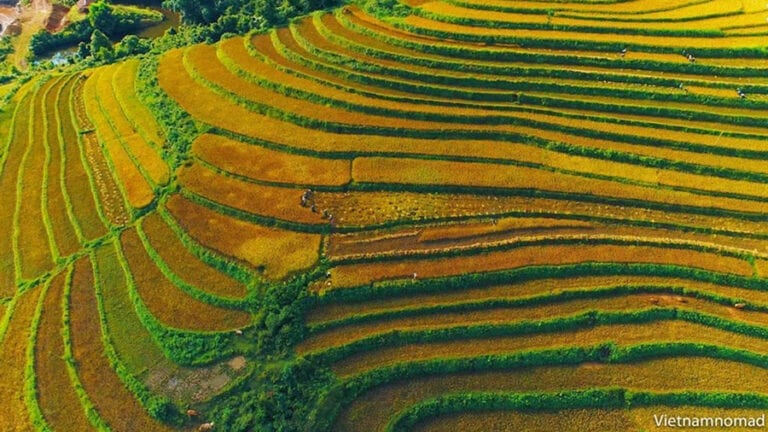
Northwest Vietnam consists of 6 provinces: Dien Bien, Son La, Hoa Binh, Yen Bai, Lai Chau, Lao Cai. The famous tourist destinations: Sapa (Lao Cai), Mu Cang Chai (Yen Bai), Dien Bien Phu (Dien Bien), Mai Chau (Hoa Binh), Moc Chau (Son La). It is a mountainous area which shares the borderline with China and Laos. This is home of magnificent fold mountains and extremely unmatched landscapes.
The region has two distinct seasons: summer and winter. The summer (April to October) is hot and humid. Winter (November to March) is cold, cloudy that is characterized by drizzle. The average annual temperature is about 25 ºC. In winter, the lowest temperature is in December and January; some places have temperatures below 0 ºC.
2. Northeast
Northeast Vietnam consists of 9 provinces: Ha Giang, Bac Giang, Bac Kan, Cao Bang, Lang Son, Phu Tho, Thai Nguyen, Tuyen Quang, Quang Ninh. The famous tourist destinations: Dong Van (Ha Giang), Ban Gioc Waterfall (Cao Bang), Ba Be Lake (Bac Kan), Ha Long Bay (Quang Ninh), Mau Son (Lang Son). The region is geographically distinguished with the Northeast by the Red River. There are middle-high mountain ranges blended with vast plateaus. The complicated system of water bodies carving into the limestone mountains creating deep valleys across the region.
The climate is quite similar to the Northwest, but the region is more affected by the humid monsoon climate than the Northwest. Therefore, the Northeast is directly affected by tropical storms in the summer.
3. Red River Delta
Red River Delta consists of 10 provinces: Bac Ninh, Ha Nam, Ha Noi, Hai Duong, Hai Phong, Hung Yen, Nam Dinh, Ninh Binh, Thai Binh, Vinh Phuc. The famous tourist destinations: Hanoi, Cat Ba (Hai Phong), Do Son (Hai Phong), Trang An (Ninh Binh). The delta is situated in the North of Vietnam, this is one of the most densely-populated regions across the country due to the fertile soil and a large concentration of waterways, which are advantageous for agricultural activities.
Like the Northeast and Northwest, the Red River Delta also has two distinct seasons: the summer is from April – November; the winter is from December – March. However, the weather here is milder than in the other two regions.
4. North Central
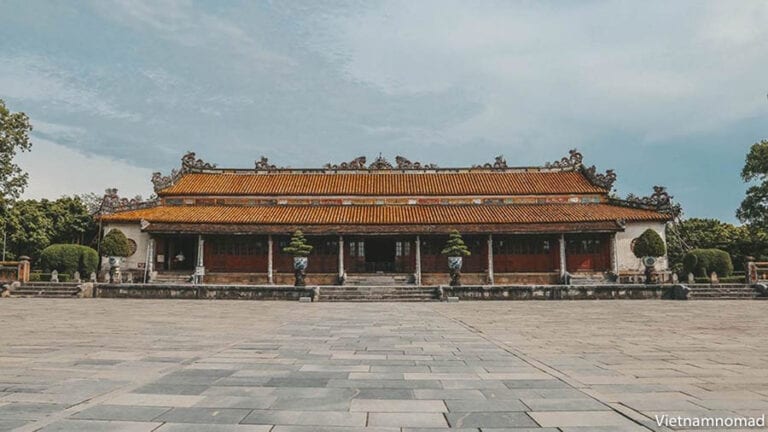
North Central consists of 6 provinces: Ha Tinh, Nghe An, Quang Binh, Quang Tri, Thanh Hoa, Thua Thien Hue. The famous tourist destinations: Thien Cam Beach (Ha Tinh), Cua Lo Beach (Nghe An), Phong Nha – Ke Bang (Quang Binh), Hue (Thua Thien Hue). This region is a long-stretching land and also the most narrow part of the country, which is one of the most important economic regions featuring aquaculture and tourism. The area is home of a great collection of three out of eight UNESCO’s World Heritage Sites in Vietnam.
Due to the monsoon in the northeast, the whole area is affected by cold weather with rain in the winter. This is different from the dry weather in the winter of the North. In the summer, there is the southwest monsoon (also known as Laos wind), so the whole region will have a hot and dry climate. At this time, the daily temperature can reach over 40 ºC; meanwhile, air humidity is very low.
5. South Central Coast
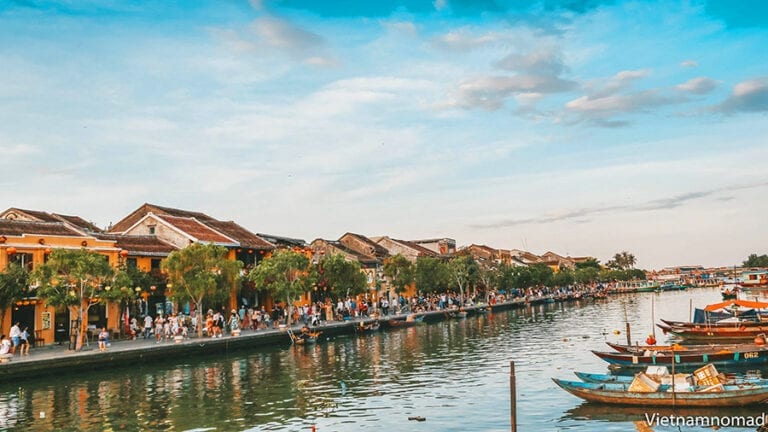
South Central Coast consists of 8 provinces: Da Nang, Quang Nam, Quang Ngai, Binh Dinh, Phu Yen, Khanh Hoa, Ninh Thuan, Binh Thuan. The famous tourist destinations: Da Nang, Hoi An (Quang Nam), Quy Nhon (Binh Dinh), Nha Trang (Khanh Hoa), Mui Ne (Binh Thuan). South Central Coast has a strategic position in terms of economic and transport values. The landscapes are dominated by the fertile whale-shaped hills, which is beneficial for herding activities. Bordering a large sea area, the economy strongly relies on marine resources. Here is also a potential travel hub thanks to its well-developed transport system.
The weather here is different from the North Central Coast due to the northeast monsoon blocked by the Bach Ma mountain range. The remarkable feature of the Central climate is that there is a rainy season and the dry season does not occur at the same time in a year in the two climatic regions of the North and the South.
6. Central Highlands
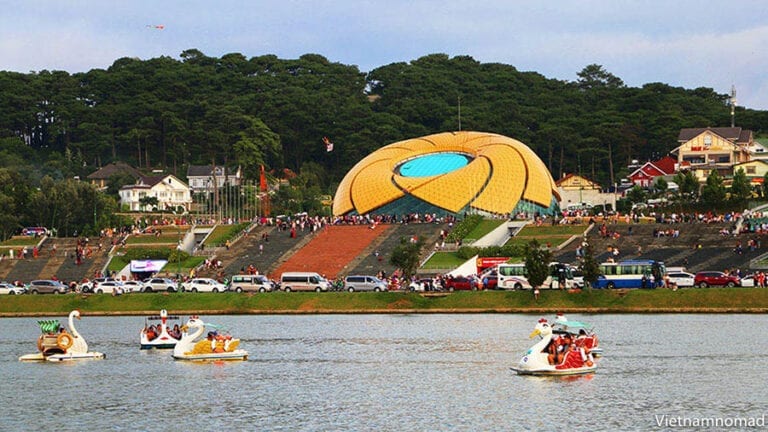
Central Highlands consists of 5 provinces: Dak Lak, Dak Nong, Gia Lai, Kom Tum, Lam Dong. The famous tourist destinations: Dalat (Lam Dong), Mang Den (Kom Tum), Buon Me Thuot (Dak Lak). The region consists of many plateaus, which are surrounded by mountain ranges. Central Highlands is known as the coffee capital of Vietnam as the fertile basalt facilitates the growth of this industrial crop. Some distant and remote mountainous parts of the area are also home to various minority ethnic groups.
Located in the tropical savanna region, the climate in the Central Highlands is divided into two seasons: the rainy season from May to the end of October and the dry season from November to April, in which March and April are the hottest. Particularly, the lands are over 1.000 m high, the climate is cool all year round.
7. Southeast
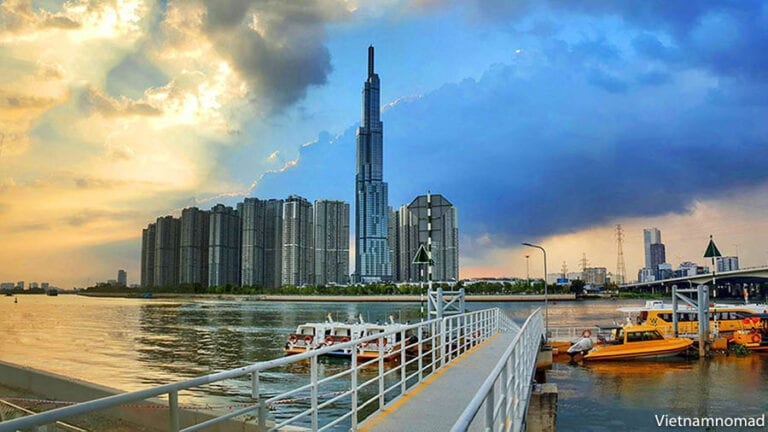
Southeast Vietnam consists of 6 provinces: Ba Ria Vung Tau, Binh Duong, Binh Phuoc, Dong Nai, Tay Ninh, Ho Chi Minh City. The famous tourist destinations: Ho Chi Minh City, Vung Tau Beach (Ba Ria Vung Tau), Con Dao Island (Ba Ria Vung Tau), Black Virgin Mountain (Tay Ninh). Southeast is the highly industrialized zone. A massive landmass is used for industrial trees and factories. The landscape highlights the midlands and low mountain ranges. This is where the major river systems meet and concentrate on the most vital ports as well as tourism.
The South is located in a region characterized by the equatorial tropical climate, abundant sunshine, and high humidity. The annual average humidity is about 80 – 82%. The climate has two distinct seasons: dry and rainy. The rainy season is from May to November and the dry season is from December to April.
8. Mekong River Delta
Mekong River Delta consists of 13 provinces: Long An, Tien Giang, Ben Tre, Vinh Long, Tra Vinh, Hau Giang, Soc Trang, Can Tho, Dong Thap, An Giang, Kien Giang, Bac Lieu, Ca Mau. The famous tourist destinations: Can Tho, My Tho (Tien Giang), Tram Chim (Dong Thap), Chau Doc (An Giang), Phu Quoc (Kien Giang). It is the southernmost part of the country and dominated by flat floodplains. The low basin of the Mekong Delta is rich in sediment from its mother source and greatly contributes to the agricultural practice of its people for centuries. The region is covered by very little forestry, mainly mangrove forests and swamps to prevent waves and preserve land.
The climate of the Mekong Delta is similar to the Southeast: the tropical monsoon climate, there are two distinct seasons: the rainy season (May to November) and dry season (December – April).
Best time to visit Vietnam
The ideal time to visit Vietnam is during the dry season. In which the period from December to March is the best time to visit Vietnam. You can rely on the detailed map below to choose the appropriate time to visit each place in the country.
Vietnam Visa
It’s easy to come to Vietnam! Vietnam offers visa exemptions to tourists from 24 countries and e-Visas to travellers from 80 countries.
Vietnam visa exemption
Citizens of 24 countries are exempted from visa when entering Vietnam:
Vietnam visa application
Now you can easily apply for Vietnam Visa with an electronic Visa, E-Visa is available to nationals of 80 countries. What you need to do is visit the official website of the Immigration Department ( click here ) and follow the instructions.
The e-Visa costs 25 USD, takes three working days to process, and is a single-entry visa, valid for 30 days.
Learn more about Vietnam Visa >
Money and Exchange
Vietnamese currency is known as “Dong” or “VND” as currency code. There are no longer coins but only paper and polymerized money, so it is quite easy to carry around. Vietnamese banknotes, however, have many zeros: the smallest bills commonly in circulation are 500 VND, 1.000 VND, 2.000VND, and 5.000VND; and the highest one is 500.000VND.
Cards are widely accepted in restaurants, hotels, and other public amenities (but not at street-food stalls), and ATMs are placed densely. The most popular exchange rate when travelling in Vietnam is from USD to VND. It is known among travellers that the best exchange rate is given at jewelry shops; however, it is now considered illegal to exchange currency at those shops. So, the best way is to change money at the airport, local banks, or ATMs.
Learn more about the Vietnamese currency >
Transportation in Vietnam
Vietnam’s transportation network is quite complete with international and domestic airport systems in many provinces, the “famous” North-South railway system, and the extensive road system with the backbone of National Highway 1A. Below is a transportation map in Vietnam with train stations and airports.
Learn more about transportation in Vietnam >
Cost of living in Vietnam
I t is totally possible to live on a budget in Vietnam as the cost of living is claimed to be inexpensive. Most of the items cost less than half of what you would pay in the West or even relatively cheaper in comparison with some tourist hubs in Asia.
Although in big cities such as Ho Chi Minh City and Hanoi Capital, things could be a bit pricey, there are still lots of opportunities to lead a comfortable lifestyle with an income of under 700 USD (of course, if you are willing to eat local food and enjoy a Vietnamese standard lifestyle). If you live outside of these two major cities, living expenses could be much less. Your lifestyle will determine your cost of living, but generally, Vietnam has a competitive yet fertile job market for both locals and expats and an average rate of living expenses. As long as one has a job and not too bad at money management, they can assure an enjoyable life and travel if they wish.
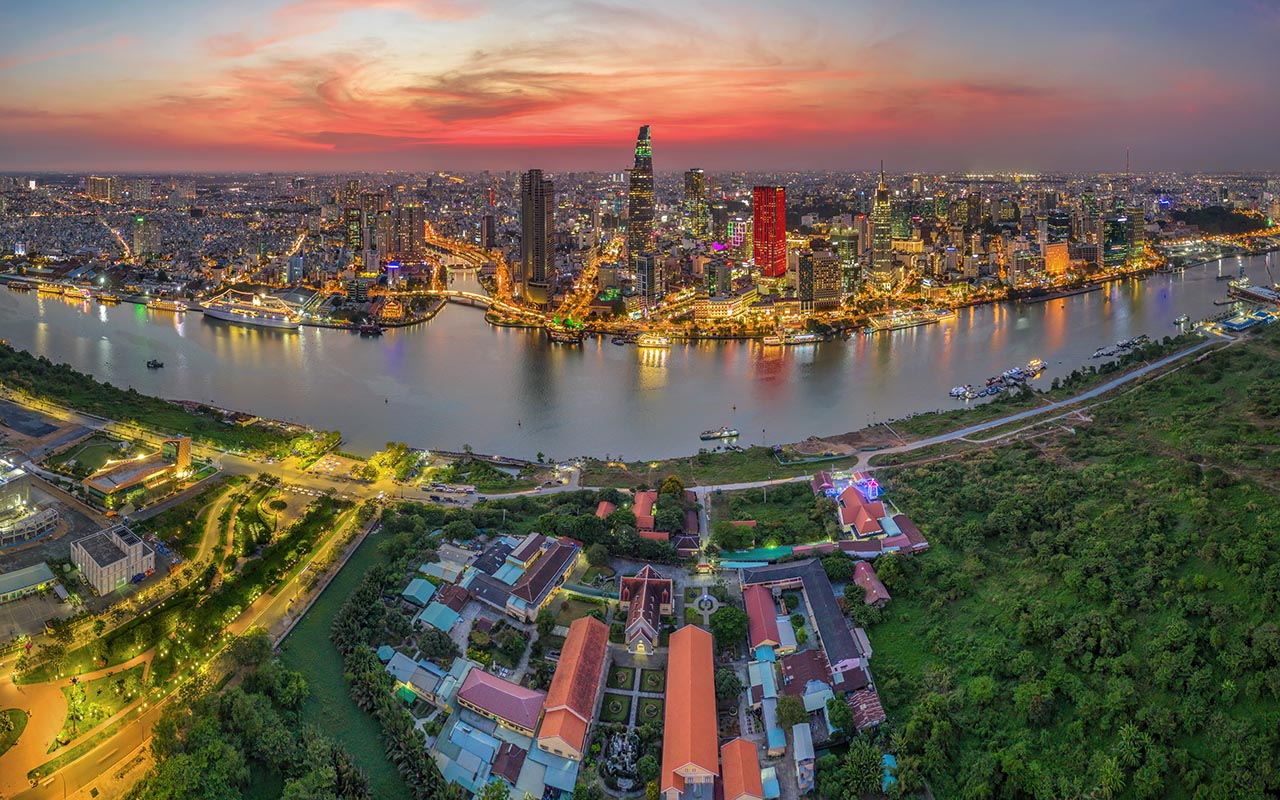
Internet and Telecommunication
Vietnam offers a very accessible Internet connection that covers most parts of the country. Wi-fi is available in every corner: at restaurants, coffee shops, convenience stores, or even at small food vendors sometimes. So there would be very little chance that you lose touch with the world while travelling here.
There are also many SIM card providers that offer 4G data service along. So if you are mostly on the road or wish to keep in touch with people, here is an option. Some of the most reliable telecommunication companies known are Viettel, Mobifone, and Vinaphone. SIM card’s price normally starts from 50.000 – 100.000 (2 – 4,5 USD), and you can add money to buy data packages that are totally affordable, ranging from just 30.000 VND for unlimited access.
Accommodation in Vietnam
Accommodation in Vietnam varies from around under 10 USD to as much as you could imagine, catering to different budgets and preferences. There are many types of accommodation that you can choose from, from hostels and guesthouses to homestays and luxurious resorts which keep popping up throughout the country. Although hospitality is a huge industry in Vietnam, it is obviously popular among the locals as the young Vietnamese tend to travel more and more these days. So, it is ideal to book your accommodation in advance to make sure of a preferable stay. Booking could be made easily through online booking websites or, particularly for homestays, through direct messages on their Facebook pages.
The vast majority of accommodations are considered very stylish and full of character, of which homestay is one form of accommodation you have to get yourself into. They are not only a place to crash after a long day exploring, but are experience itself. Most places have English-speaking staff, and they accept both cards and cash.
Best places to stay in Vietnam >
Shopping in Vietnam
It is no exaggeration that Vietnam is one of those shopping paradises. There is a whole range of shopping activities that you could take part in, which serve your craving for shopping and offer insight into the country’s culture. You could wander around the local open-markets to embrace the vibrance and dynamic energy of the street business culture of the Vietnamese, or opt for a less hustle and bustle shopping vibe in the shopping malls. A new breeze of shopping experience that is enjoyed by the millennials is the flea-markets, which are often held on weekends gathering the participation of local clothing and handicraft brands. Each market in Vietnam brings the characteristics and colors of the local community here. Going to the market is not only for shopping, but it is also a journey to discover the local culture.
For great trips, convenience stores are a good choice for you. There are many convenience stores in Vietnam, especially in big cities as Ho Chi Minh City, Hanoi, and Da Nang, which have almost everything you need. There are many well-known brands such as 7-Eleven, Vinmart, FamilyMart, and Cycle K. Therefore, if you need food or necessities, convenience stores are a quick choice.
Supermarkets or shopping malls are also an option, but most of them only appear in big cities with brands such as Vinmart, Co.op Mart, Vincom, and Lotte Mart.
Vietnam is also known as the manufacturing location for many big fashion names such as Nike and Adidas, so you are likely to get a very competitive price for those.
Due to the variety of items, affordable prices, and a wide range of shopping experiences, shopping would be a great part of your traveling in Vietnam.
15 best places to visit in Vietnam
Coming to the S-shaped country, you can admire the poetic and charming scenery wherever you go. The natural beauty, unique culture have made Vietnam become a tourist destination worldwide. At each place, we have designed an “all-in-one” travel guide page; click on the photo of the destination and explore it your way.
1. Ha Long Bay
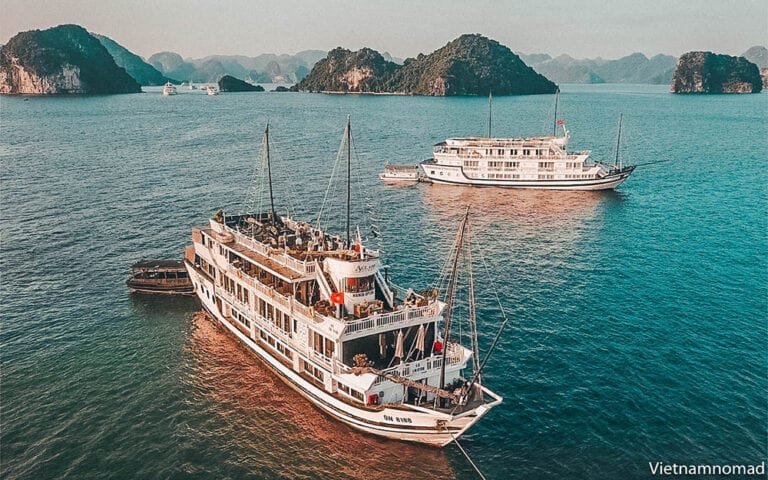
Ha Long Bay is a famous tourist destination of Vietnam, located in the western part of the Gulf of Tonkin in the northeastern region of Vietnam. With thousands of magnificent islands, Ha Long Bay has been recognized by UNESCO as a natural heritage of the world since 2003.
Ha Long City is a coastal region with two distinct seasons: winter (November to April) and summer (May to October). Affected by the climate of Northeast Vietnam, there are two distinct types of monsoons: the Northeast wind in the winter that brings coldness and drizzle; and the Southwest wind in the summer that brings warmth and rain. The best time to visit Halong Bay is in the spring and autumn (from April to October) because of the chilly weather.
Looking down from above, Ha Long Bay like a picture with thousands of unique rocky islands such as Dau Nguoi, Rong, La Vong, Trong Mai, and Canh Buom. Hidden inside the rocky islands are beautiful caves such as Thien Cung, Dau Go, Sung Sot, Trinh Nu, and Tam Cung.
2. Ninh Binh
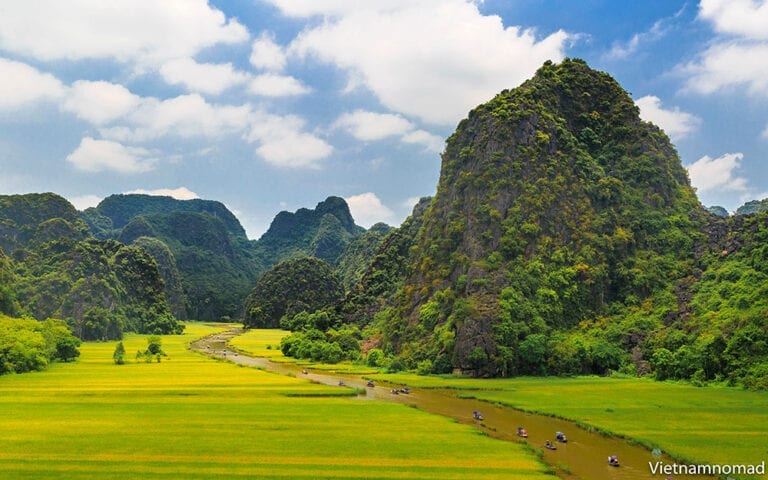
About 100 km away from Hanoi, Ninh Binh is a gem of Northern Vietnam. It is located in the southernmost region of the Red River Delta, which is the intersection of two large rivers: the Red River and the Ma River. This is known as the ancient capital of Vietnam, with many historical relics remaining.
You can travel to Ninh Binh at any time of the year. However, the ideal time for tourists to visit this land is in early spring, between the second and third month of the lunar calendar. At this time, the weather is mild, suitable for those who want to admire the spring beauty, and join the temple ceremony at the beginning of the year. If you come to Ninh Binh in late May and early June, you will admire the breathtaking scenery by the bright yellow rice fields along the banks of the Ngo Dong River. The golden color of rice interspersed with the green of the mountains creates a beautifully natural picture. In fall, you will be surprised by the peaceful beauty of the sky clouds combined with the blue Sao Khe River blooming full of lotus flowers and water lilies. The faint pink of the lotus flower combined with the pure white of water lilies creates a beautiful picture like in a fairyland.
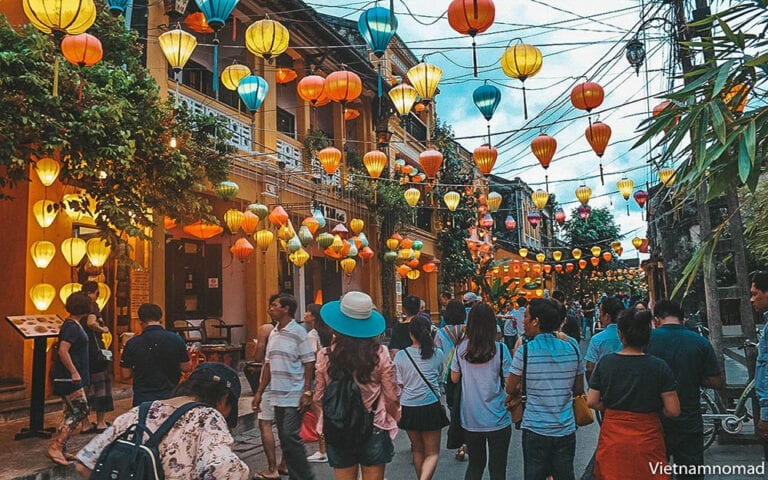
Hoi An is located downstream of the Thu Bon River, Quang Nam Province, Vietnam. It is a famous tourist city, only about 30km from Da Nang to the South. The Ancient Town of Hoi An carries the diversity of settings and the history of hundreds of years of cultural interference between the three countries of China, Japan, and Vietnam. You will be fall in love with the mix of vibrant lifestyle and ancient architecture of this little town.
As the most beautiful city in Vietnam, Hoi An is crowded year-round; the tourist season starts from November to the end of February. If you want to enjoy a “real” Hoi An, April to June is the right time for you, when there are the least tourists.
Hoi An is famous for traditional architecture’s beauty, the harmony of houses, walls, and roads. Along with many ups and downs of history, Hoi An ancient town retains the ancient beauty in every corner.
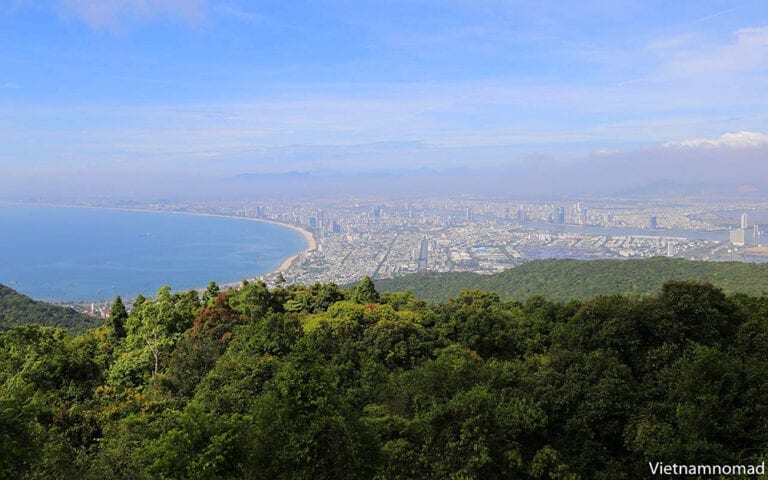
Da Nang is located in Central Vietnam, with an almost equally divided distance between Hanoi Capital and Ho Chi Minh City. Possessing one of the most beautiful beaches on the planet – My Khe and many incredible natural landscapes, Da Nang City is one of the most attractive tourist destinations of the Central region.
Da Nang’s climate is divided into two distinct seasons: the dry season (from December to August) and the rainy season (from September to November). The best time to travel to Da Nang is from January to July; at this time, the weather is not too hot; the temperature is about 25 – 32 °C, suitable for outdoor activities.
Da Nang is a “Crouching Tiger Hidden Dragon” city in Vietnam, where there are mountains, forests, beaches, and delicacies. The famous tourist attractions in Da Nang include Ba Na Hills, My Khe Beach, Marble Mountains, and Asia’s largest Fantasy Park indoor amusement park. Da Nang also has many fascinating landscapes such as Hai Van Pass, and the primeval forest in Son Tra Peninsula.
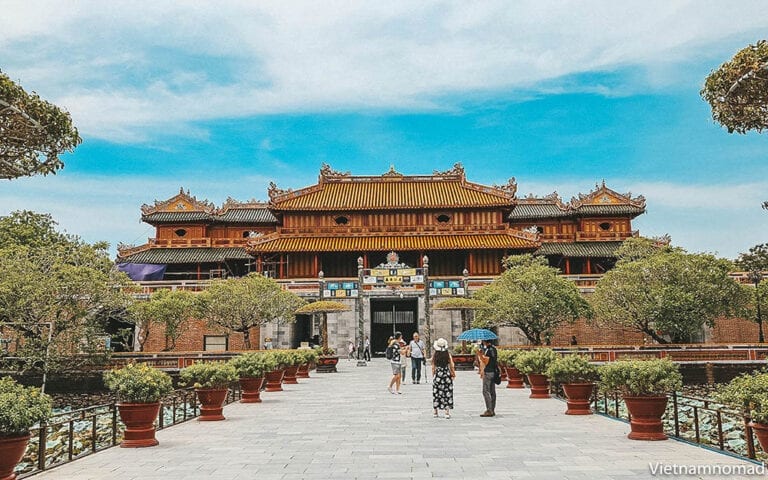
Once was the capital of the Nguyen Dynasty, Hue is considered a royal land with many palaces and tombs of the Kings. If you want to learn about the glorious Vietnam history, you cannot miss this land. Hue also attracts visitors by the poetic and beautiful natural landscapes and friendly people.
The weather in Hue is generally quite harsh, with high temperatures in the dry season (35 – 40 °C), but the dry season is also a good time to visit this city because the weather is less rain, suitable for visiting the palaces and tombs.
In addition to the Hue Imperial Citadel and mausoleums, you should also visit places such as Lang Co Bay, Hon Chen Palace, Thien Mu Pagoda, and Thuan An Beach.
Hue dishes are extremely delicious and cheap. The delicacies can be mentioned such as mussel rice, Hue beef noodle soup, and Hue sweet soup.
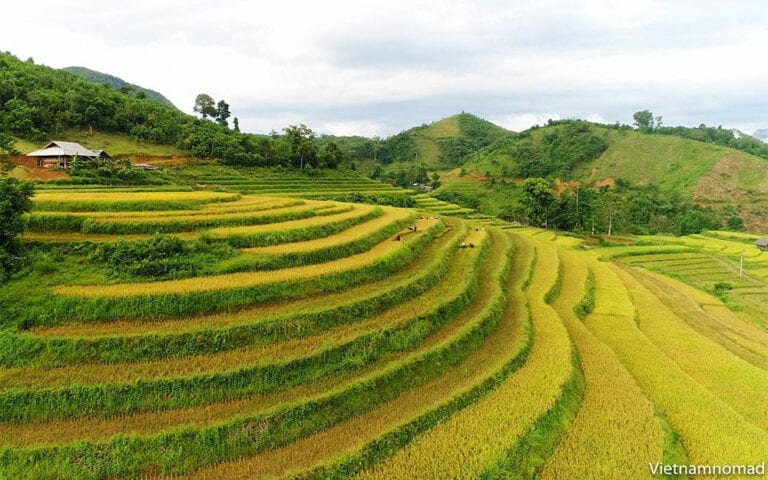
Sapa is a scenic spot located in the Northwest of Lao Cai province in Vietnam. It is one of the most famous tourist destinations in Vietnam . Situated at an average altitude of 1.500 – 1.800 m above the sea, Sapa is always in the thick fog, creating a fanciful scene.
Sapa is a mountainous region with a cool climate all year round. The weather in Sapa has four seasons; the average temperature of Sapa is 15 °C. Summer in Sapa is not too hot; winter is often cloudy and cold, sometimes it snows.
Tourists come to Sapa to enjoy the fresh air and admire the wild beauty of the Northwestern mountains. Terraced fields, waterfalls, and majestic mountains create an impressive beauty for Sapa. Besides, visitors also can explore the customs and cultural beauty of ethnic minorities such as Black H’Mong, Red Dao, Tay, and Giay.
Referring to Sapa, it is impossible not to mention famous tourist destinations such as Fansipan Peak, Ham Rong Mountain, Stone Church, Muong Hoa Valley, and some villages such as Cat Cat, Ta Phin, Ta Van. Come to this foggy land, don’t forget to enjoy a salmon hot pot, drink a cup of Tao Meo wine.
7. Nha Trang
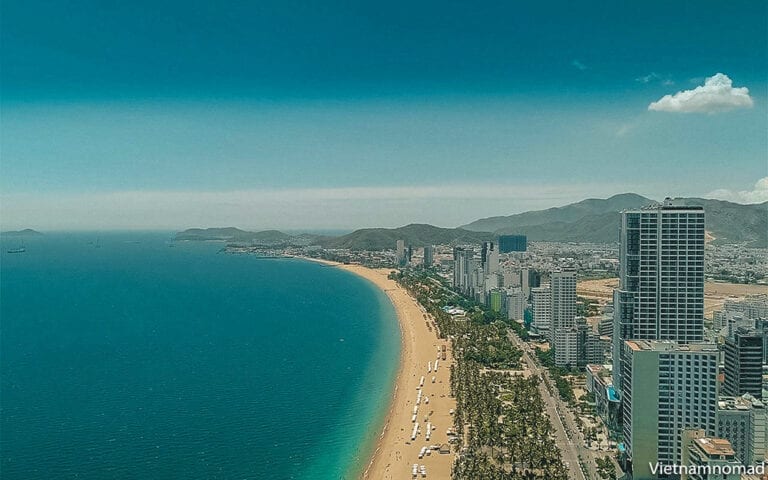
As a coastal city in Khanh Hoa Province, Nha Trang is the top destination of Vietnam. Nha Trang is surrounded by beautiful beaches , majestic mountains, and pristine islands, an ideal place for your vacation. Besides the beautiful beaches, the islands as Hon Tre, Hon Chong, and Hon Mun are always attractions to visit this coastal city.
T he most significant advantage of this city is the long sunny season during the first eight months, the temperature difference is not considerable. The rainy season of Nha Trang lasts from September to December and reaches its peak in October and November.
From fine dining restaurants facing the sea to favorite pubs, all are located along the beach in front of Nha Trang city. Coming here, you definitely have to try the famous specialties such as Banh Can, Banh Canh Cha Ca, and Nem Nuong.
8. Ho Chi Minh City
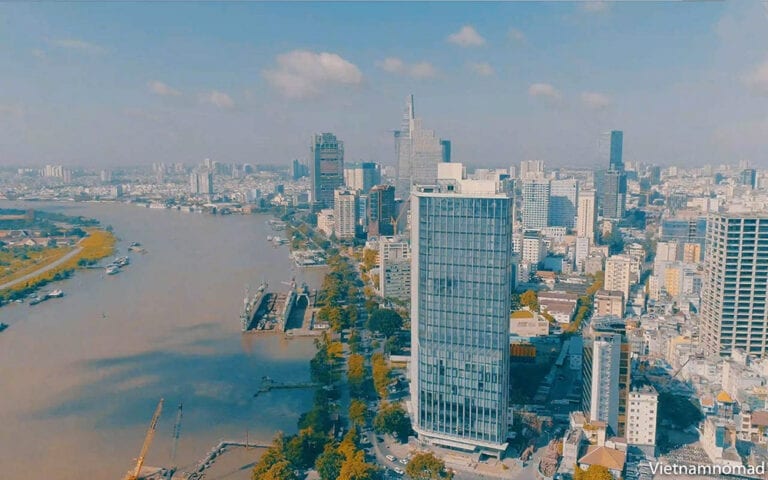
Ho Chi Minh City (Saigon) is the biggest city in Vietnam, which has long been known as the Pearl of the Far East, a lavish metropolis.
Ho Chi Minh City left a deep impression for the first time with anyone who has ever been to. The bright light of night streets, the colorful signs, the fresh beer pubs, the playgrounds that last all night; all turned Ho Chi Minh City into a paradise of shopping and food in Vietnam. People here are famous for being enthusiastic and generous. For strangers, they are willing to guide every intersection and street corner.
Ho Chi Minh City weather does not have four seasons like Hanoi but only two: rainy and dry. The rainy season is from May to November. In general, you can visit Ho Chi Minh City at any time of the year; the rainy season is also the most beautiful season of this city.
Ho Chi Minh City is subdivided into 22 district-level subdivisions. Urban areas include districts 1, 3, 4, 5, 6, 7, 8, 10, 11, 12, Phu Nhuan, Binh Thanh, Go Vap, Tan Binh. The suburbs include Hoc Mon, Cu Chi, Binh Chanh, Nha Be, Can Gio and Thu Duc City (sub-city).
District 1 is the administrative, economic, and transactional center of Ho Chi Minh City. Therefore, if you are a first-timer, you should visit the famous spots such as Ben Thanh Market, Nguyen Hue walking street, Notre Dame Cathedral, Independence Palace, and Bui Vien Street. District 1 is also the place where the majority of tourists choose to stay while in this city.
District 2 and District 3 are the ideal residence with spacious street, elegant and quiet villas.
District 4 is the place where people mainly live by working in warehouses and docks. So coming here, you will discover the daily life of ordinary workers in the city.
District 5 is where more than half a million Chinese people have been living there for a long time. It is also an attractive tourist destination with the name “ China town “.
In the suburbs, a destination not to be missed when coming to Vietnam is Cu Chi Tunnels, a massive underground tunnel system; it is heroic evidence of the history of the “ Vietnam war “.
Coming to Ho Chi Minh City to sip a bottle of Saigon beer on Bui Vien Street, sometimes that’s enough.
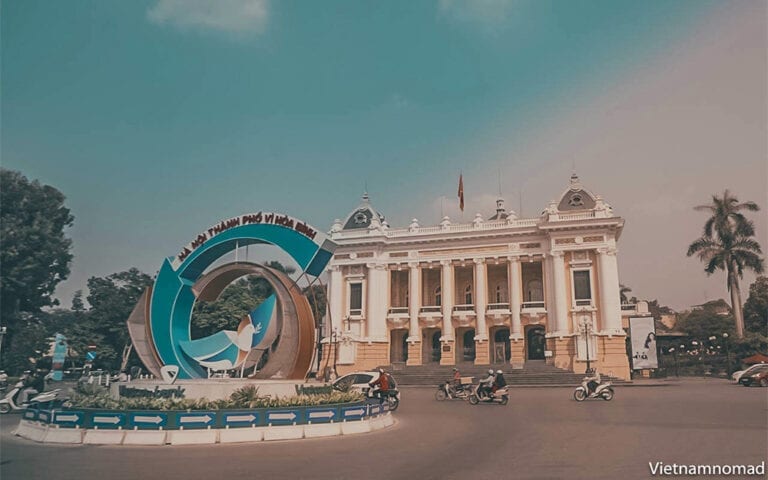
Hanoi – the capital, is Vietnam’s important cultural, political, commercial, and tourist center. Over a thousand years of history, Hanoi has become a famous tourist destination in the world.
Hanoi attracts tourists by its ancient beauty, historical colors, and hospitality from local people. The best time to visit Hanoi is in the fall, from mid-August to the end of October. At this time, the weather in Hanoi is cool, and the scenery is extremely romantic.
Hanoi has more than 4.000 monuments and beautiful landscapes. In particular, there are more than 9.000 relics in the ranking of national monuments, with hundreds of temples, structures, and famous attractions. Some prominent relics of Hanoi are the Temple of Literature, One Pillar Pagoda, Ngoc Son Temple, Ba Dinh Square, Hanoi Cathedral, and Opera House.
Also, the unique culture of the Hanoi people fascinates many tourists around the world. Hanoi is famous for its fine handicraft products in craft villages such as Bat Trang ceramics, Ngu Xa bronze casting, and Yen Thai village. Besides, Hanoi also owns unique cuisine and many different cultural festivals throughout the year.
Hanoi is also remembered as the city with the best street food in the world. Come to Hanoi, do not forget to enjoy specialties such as Pho, Bun Cha, Cha Ca La Vong, and Bun Thang.
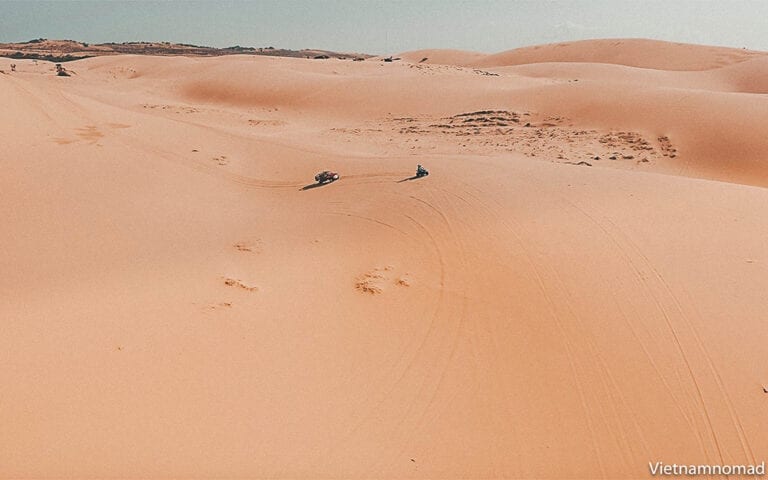
Located 22 km northeast of Phan Thiet City center, Mui Ne is one of the most beautiful and famous destinations in Binh Thuan Province. In 2014, Mui Ne ranked 2nd on the top of the most beautiful beaches in Southeast Asia by Canadian traveler site voted. According to Skyscanner, this place has been listed on the list of 10 impressive beaches of Asia Pacific.
The period from April to August is considered to be the best time to travel to Mui Ne. From September onwards, Mui Ne often rains, so it is inconvenient for outdoor activities.
Besides the poetic and idyllic scenery, Mui Ne attracts visitors by the desirable and affluent culinary features. Coming here, you definitely have to enjoy the delicately processed seafood dishes such as Dong, fish salad, Banh Can, and Banh Xeo.
11. Ha Giang
Famous for the majestic scenery, the endless terraced fields, the long buckwheat flower fields, and the cultural identity of upland ethnic people, Ha Giang is one of the destinations that attract many tourists in Vietnam recently. Located in the mountainous north of Vietnam, Ha Giang is a majestic mountain complex, with an average height of 800 m to 1.200 m above sea level.
The northern highland is Dong Van Plateau, including Quan Ba, Yen Minh, Dong Van, and Meo Vac districts, with 90% of the area is limestone mountains, typical for karst terrain. There are sharp rocky mountains, deep and narrow ravines, and cliffs. On October 3, 2010, Dong Van Rock Plateau joined the Global Geopark Network. The western include Hoang Su Phi and Xin Man districts, which are part of Bac Ha Plateau, commonly known as Chay River lift arch, with elevations from 1.000m to over 2.000m. The terrain here is usually domed or semi-arched, interspersed with steep, sometimes sharp, or jagged terrain. The low mountainous region covers the remaining districts and towns, stretching from Bac Me, Ha Giang town, through Vi Xuyen to Bac Quang. This area has strips of old forest interspersed with relatively flat valleys located along rivers and streams.
The best time to visit Ha Giang is from October to December in the buckwheat flower season. Another great time to visit this land is from September to October, which is the rice season.
Coming to Ha Giang, visitors also have access to mountainous residents’ culture through highland markets; one of them is Khau Vai Love Market, a dating place for couples. At this fair, people also sell various handmade products such as embroidered towels, cloth bags, dresses with bright and delicate patterns. Another thing that attracts visitors to come to Ha Giang is the specialties such as dried buffalo meat, Thang Co, Buckwheat flower pancake, and Chao Au Tau.
Moreover, Ha Giang has a rich and diverse cultural treasure, with more than 20 ethnic groups living here. Each ethnic group has its own unique cultural identity, expressed through customs, festivals, and religions.
Dalat is a city in Lam Dong Province, located on Lam Vien Plateau, at an altitude of 1.500 m above sea level, which has many beautiful landscapes. Dalat is one of the most famous tourist cities in Vietnam, a little Paris of Vietnam.
Dalat has an ancient, romantic beauty with many architectural works and old villas from the French colonial period. Dalat has a typical climate of the Central Highlands region with two distinct seasons: rainy season and dry season. The rainy season lasts from May to October, and the dry season lasts from November to April next year. The ideal time to visit Dalat is from October to December, when the flowers bloom throughout the mountains.
Dalat attracts tourists by famous attractions such as Tuyen Lam Lake, Xuan Huong Lake, Bao Dai Palace, Linh Son Pagoda, Truc Lam Zen Monastery, and many beautiful coffee shops. Come to Dalat, don’t forget to enjoy the delicious food such as Lau Ga La E, Banh Mi Xiu Mai, and Banh Can. At night, in the chilly air, visitors can stroll around the night market and Xuan Huong Lake edge to enjoy a cup of hot soy milk, or a Dalat baked rice paper.
13. Phu Quoc

Phu Quoc is also known as a gem island, the largest island in Vietnam, located in the Gulf of Thailand. Phu Quoc Island, together with other islands, form the Phu Quoc Island District of Kien Giang Province. In 2006, Kien Giang coastal and island biosphere reserve, including Phu Quoc, was recognized by UNESCO as a world biosphere reserve.
As a tropical monsoon island equatorial, the Phu Quoc climate is divided into two distinct seasons, which are the rainy season and the dry season. Because it is the gateway to receive the west-southwest monsoon, the humidity in the rainy season is very high, from 85 to 90%. In the dry season, the island is affected by the northeast monsoon, so that the temperature will increase in April and May. The best time to visit Phu Quoc Island is the dry season, from the end of October to March next year. At this time, the weather in Phu Quoc is less rain, which is convenient for travel and relaxation.
Phu Quoc has many beautiful beaches stretching from the north to the south and 99 hills covered by vast primeval forests. In the north of the island, there are Rach Vem, Bai Thom, and Hon Mot fishing villages – with outstanding wild beauty. In the South Island, there are 12 large and small islands such as Hon Thom, Hon Mong Tay, Hon Gam Ghi, Hon May Rut – the ideal places for nature exploration activities such as night squid fishing, diving to see corals, and discovering pristine forest.
Phu Quoc not only attracts tourists with beautiful views but also the delicious dishes made from a rich source of seafood. Some dishes that you cannot miss when visiting Phu Quoc are Herring Salad, Grilled Squid, Quay Noodle, and Sim wine.
14. Quy Nhon
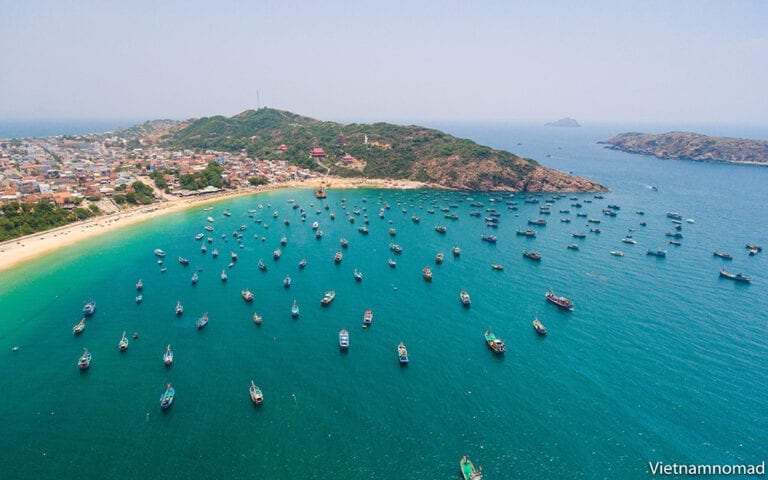
If talking about a hidden pearl of Vietnam, Quy Nhon is a leading candidate. Located in Binh Dinh Province, Quy Nhon is known as one of the most beautiful coastal cities in the South Central Coast with many ideal beaches such as Eo Gio, Ky Co, Cat Tien, Nhon Hoi, and Hai Giang, where visitors can immerse themselves in the majestic natural scenery.
Binh Dinh climate is characterized by humid tropical and monsoon with 2 distinct seasons in a year. The dry season lasts from January to August and the rainy season lasts from September to December. The ideal time to visit Quy Nhon is from January to September when the weather is sunny and less rain.
Coming to Quy Nhon, not only immersed in the clean beaches but also infatuated in the food here. Great dishes in Quy Nhon can be mentioned as Banh Xeo, Bun Ca, Banh It La Gai, and Bao Da wine.
15. Quang Binh
Quang Binh is known as the “cave kingdom” with more than 300 different large and small caves, including Son Doong Cave, En Cave, Thien Duong Cave, Phong Nha Cave, Tien Son Cave, Chay River – Dark Cave, System of Stunted Caves in Le Thuy. Not only that, but Quang Binh also has unbelievably pristine beaches such as Nhat Le Beach, Rock Jump Beach, Vung Chua, and Yen Island. And most importantly, Quang Binh also has attractive spiritual attractions such as the Tomb of General Vo Nguyen Giap, relics of Hang Tam Co, General Memorial Hall, and Hoang Phuc – a pagoda is over 700 years old.
The ideal time to visit this land is from March to September when the weather is pleasant and less rain. From September to March, there are usually heavy rains.
The two famous of these destinations are Phong Nha-Ke Bang National Park and Son Doong Cave. Recognized as a UNESCO world heritage site in 2003, the Phong Nha – Ke Bang Complex is a destination not to be missed when traveling to Quang Binh. Son Doong Cave, located in the core area of Phong Nha – Ke Bang National Park, is a new cave discovered by the Royal Cave Research Association of England, which was announced as the largest cave in the world in 2010; it was put into operation in the form of adventure travel in 2013. Tourism activities of Son Doong Cave are limited to the number of participants, so the number of people who have conquered Son Doong cave is even less than the number of people who have ever stood on Mount Everest.
In addition to owning a beautiful landscape, Quang Binh also attracts tourists with rich and featured cuisine. With only 100.000 VND, you can enjoy many delicious dishes, including Banh Bot Loc, Banh Canh Ca Loc, and Banh Khoai.
10 must-try foods in Vietnam
Vietnam has been long known as a culinary paradise; for thousands of years of civilization, Vietnamese people have created countless beautiful, harmonious, and delicious dishes. To explore Vietnam is to dive into its diverse cuisine as not only does it always burst with flavors but also is an incarnation of a prosperous breadth of history.
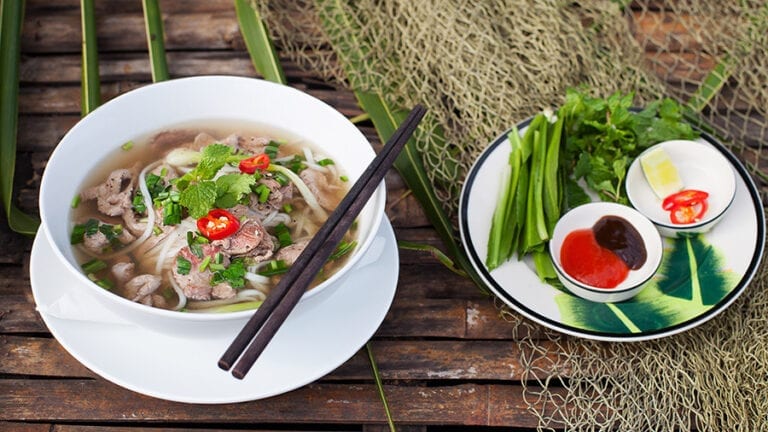
Pho is considered the national dish of Vietnam, a must-try food when coming to this S-shaped country. It has been voted by CNN, BBC, and Business Insider as the best dishes in Asia. In 2016, Pho was voted as one of the top 3 most delicious Vietnamese dishes in the world.
The main ingredients of Pho include noodles, broth, thinly sliced beef, and herbs. A qualified broth has to fulfill three strict criteria: firstly, the broth has to be clear to guarantee visual attractiveness; secondly, it has to come with the subtle sweetness extracted from the pork bones slowly cooked for hours; and thirdly, it has to bring up the herby aroma of cinnamon, anise, ginger. When eating Pho, we usually eat with hot sprinkles and spices such as chili sauce and sauté.
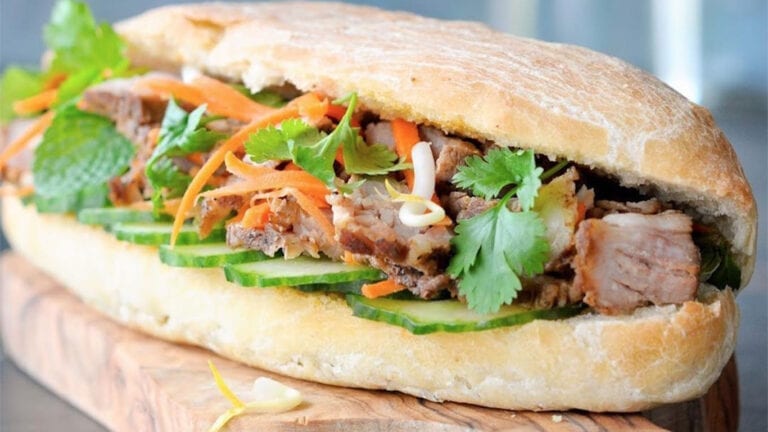
Culinary experts and international media recognized Banh Mi as the must-try dish when coming to Vietnam. The Guardian of England ranked Banh Mi in second place in the top 10 most delicious and attractive street food in the world. This newspaper once wrote: “There is a little known secret that the best sandwich in the world is not in Rome (Italy), Copenhagen (Denmark) or New York City (USA), but on Vietnamese streets.” David Farley, a BBC travel and food writer, praised Banh Mi as “the best sandwich in the world.”
Banh Mi makes of flour, like the Baguette but smaller, with fillings inside. Typically, the fillings have grilled pork, Vietnamese sausage, pate, egg, herbs, and cucumbers.
Banh Mi is sold in almost every street in Vietnam. Thanks to its simplicity and convenience, Banh Mi has become a familiar breakfast for Vietnamese people.
3. Goi Cuon
Goi Cuon is one of two Vietnamese dishes featured in CNN’s list of the world’s 50 best dishes in 2011. It is a favorite dish in Southern Vietnam.
Goi Cuon is usually made from boiled pork, boiled shrimp, fresh vermicelli, thinly sliced cucumber, long-stemmed chives, split onions, pickled carrots, or chopped green mango, herbs, and lettuce. All the ingredients are then rolled with rice paper. Saigon people like to eat Goi Cuon with black sauce. The habit of using black sauce is the culinary touch between Vietnamese and Chinese.
4. Bun Bo Hue

In an episode of “Anthony Bourdain: Parts Unknown” on CNN, the famous American chef said: “Hue beef noodle is the best soup in the world.” The Asian Record Organization had also put Hue beef noodles into the top 100 delicious Asian dishes in 2016. This is a popular dish of Hue. Hue beef noodle ingredients include pork leg meat, a piece of boiled pork blood, beef ball, and lemongrass.
To have a good bowl of Hue beef noodles, choosing the ingredients is very important: Beef should be bright red, smooth, and yellow fat. The broth is stewed with beef bones for a naturally sweet taste.
Nowadays, you can enjoy a bowl of Bun Bo Hue anywhere, but a proper bowl must be enjoyed at a roadside restaurant near Trang Tien Bridge, Hue.
5. Mi Quang
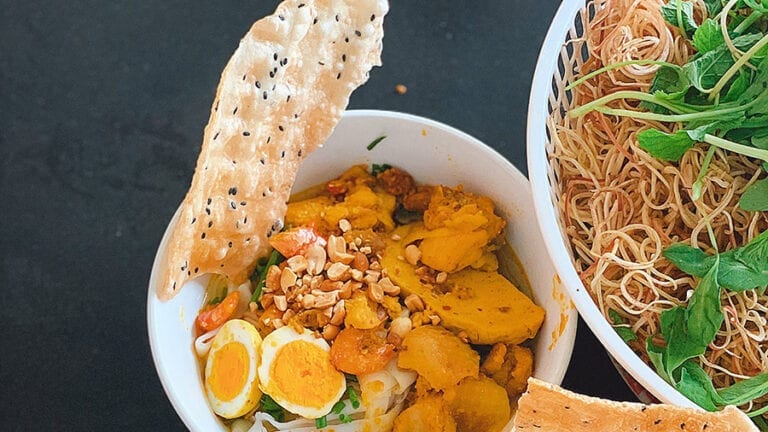
Mi Quang is a typical dish of Quang Nam, a province known for many famous tourist destinations such as Hoi An Ancient Town and My Son Sanctuary.
Mi Quang is a Vietnamese soup, which has all kinds of proteins that you could think of. For a “special” bowl of Mi Quang, there are noodles, sliced pork, shrimps, and quail eggs. Mi Quang is not complete without a handful of green herbs, crispy “Banh Da” – a type of rice paper that is thick, cracky, and added sesames.
6. Banh Xeo
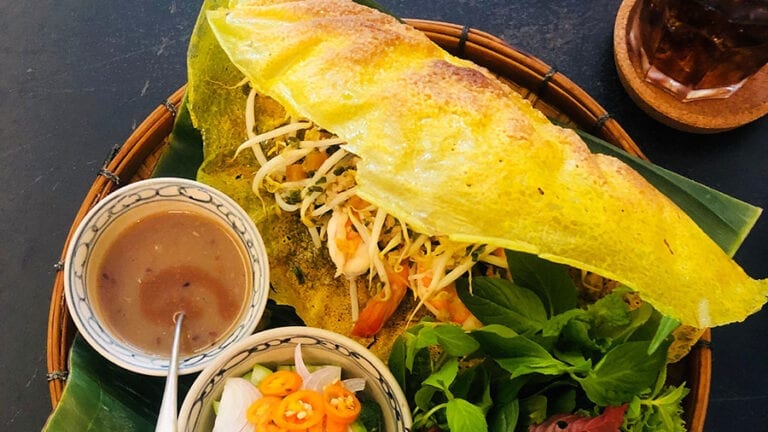
Banh Xeo (Vietnamese crepe) was one of the Vietnamese dishes participating in the 2016 Street Food Congress (WSFC), which was held in Manila, Philippines. According to CNN, this was one of the most popular street food in the world in 2016. There are two types of Banh Xeo, Banh Xeo of the Mekong Delta people (usually bigger and softer) and Banh Xeo of the Central Vietnam people (smaller and more brittle).
Due to the popularity it has gained among the foodies from all over the world, the fillings have been added to maximize the dining experience. Authentically, however, Banh Xeo is stuffed with pork belly, shrimp, bean sprouts, and mung beans. The “right” Banh Xeo batter is mixed with coconut milk, added garlic chives, and has to be fried in pork fat. Banh Xeo is no good as take-away food as what makes it really stand out is the dining vibes: the constant sizzling noise on the background, the scent of coconut milk, and turmeric powder as well as the vibrant talking of the eaters who gather to share not only food but stories.
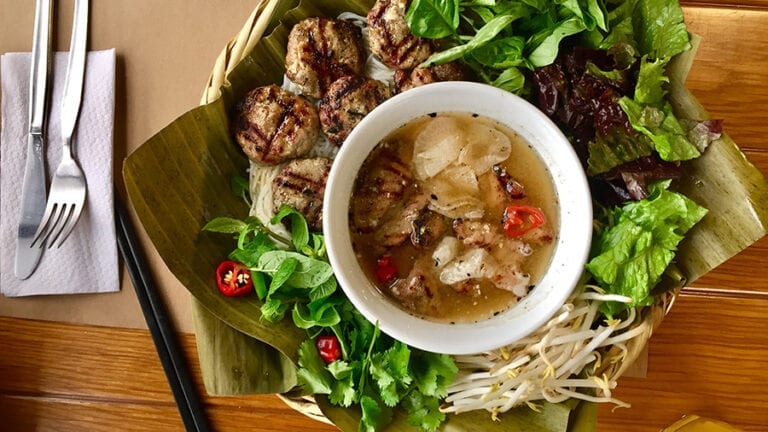
Bun Cha has been voted CNN’s top 10 delicious summer food, National Geographic’s top 10 best street food in the world, which was more famous after president Obama enjoyed this dish in Hanoi in 2016.
Bun Cha consists of three main parts: dipping sauce, grilled pork, and rice noodle. The success of Bun Cha is determined by the dipping sauce. Sauce to eat Bun Cha is a combination of fish sauce, vinegar, sugar, garlic, chili, green papaya, and carrots.
Bun Cha is a perfect combination of five flavors: bitter (from herbs and pickled papaya), spicy (from chili), sour (from lemon and vinegar), salty (from grilled pork), and sweet (from meatballs).
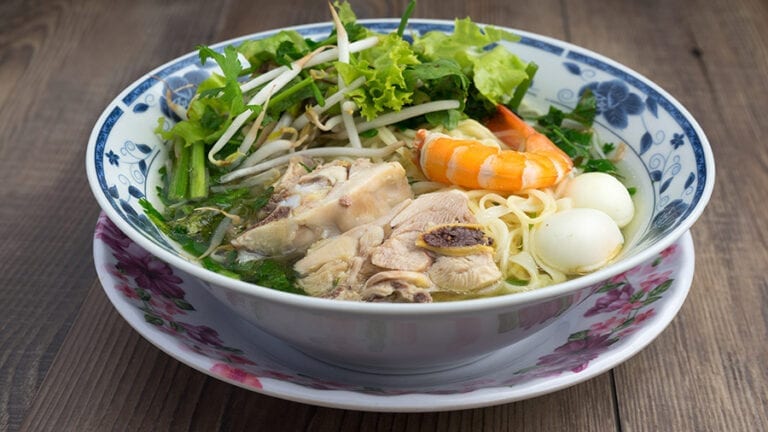
For thousands of years of wet rice cultivation, Vietnamese have processed rice into many different dishes, typically noodles, Pho, vermicelli, and Hu Tieu. Hu Tieu is a delicacy born from the essence of rice in one of the largest rice-growing regions in the world: the Mekong Delta.
When being ordered, the cook blanches noodles in a separate pot of boiling water before presenting them in the bowl with blanched bean sprouts, chopped scallions, sliced pork, shrimp, and quail eggs. It is often served with green vegetables and basil.
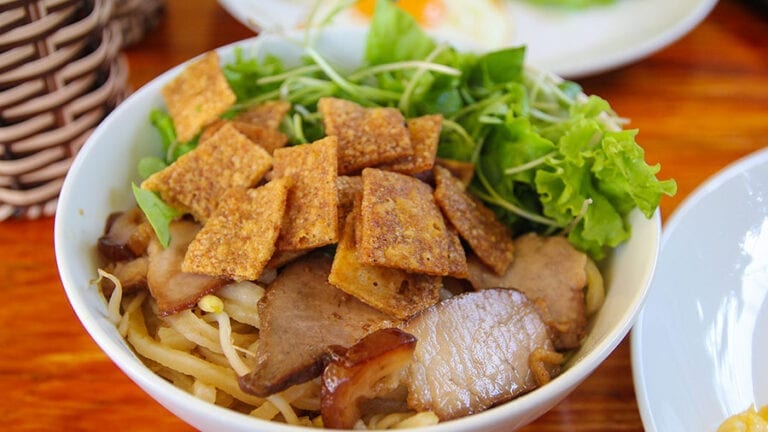
Cao Lau was voted the best street food in Asia by Australia Traveler News. This dish has been mentioned many times by CNN as one of the best dishes in Vietnam. Cao Lau is a specialty of Hoi An ancient town.
A special feature of Cao Lau is the yellow noodles, which make from rice soaked with ash – from trees in Cham Island, Hoi An. It does not need much broth, but instead, Cao Lau must have minced meat, soy sauce, and roasted pork skin.
Cao Lau is often sold in restaurants with two floors, which are hanging red and blue lanterns. Tourists have enjoyed the delicious taste of Cao Lau and the ancient tourist atmosphere of street corners.
10. Vietnamese Coffee
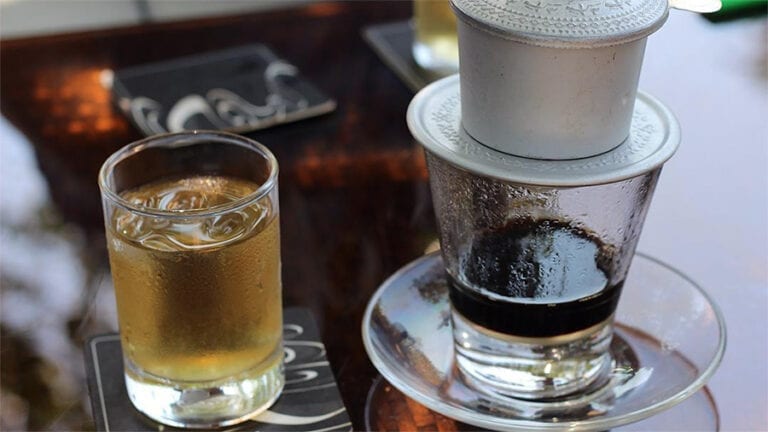
You may not know it, but Vietnam is the second biggest exporter of coffee in the world. And the coffee here is unlike any you’ve ever seen, Vietnamese often drink coffee with condensed milk, coconut, and sometimes with … eggs. Vietnamese coffee is usually Robusta, stronger than any other type of coffee; a cup can make you awake all day.
Vietnamese drink coffee anywhere and anytime, coffee is so popular that you can find coffee shops anywhere for about 15.000 VND (less than 1 dollar).
Tips and notes
1. Watch carefully when crossing the road: As you know, traffic in Vietnam is quite messy, especially in big cities, so always follow closely and obey traffic signals when crossing the road to ensure your safety. Don’t be afraid as it would be a highlighted experience of your travel. You can always follow a local nearby to cross, we are sure they will happy to help.
2. Keep your phone and wallet carefully when visiting crowded attractions: Anyplace in the world has good and bad people, so remember to keep your personal belongings carefully, especially valuable items. If you visit crowded places, it is a good idea to wear your package on your front.
3. Mo torbike Safety: If you are planning to rent a motorbike in Vietnam, you must have an international driving license and always wear a helmet when driving. Make sure to test the bike carefully to see if it fully functions before going on a long trip.
4. Step Out of Your Comfort Zone: Vietnam is a land with many interesting, strange and unexpected things, especially in cuisine, the street food looks gruesome such as “flipped duck eggs” (aka baluts) or “Bun Dau Mam Tom”, but believe us, they are delicious! Even if it is not tasty for you, it is still a unique experience, isn’t it?
5. Tip or not tip? In Vietnam, there is almost no “tip culture”, in most cases, you don’t need to tip; but at the following services, tips are often accepted: Spa, massage, nails, foot-massage, tour guide: 3 – 5 USD.
6. Saving the phone number of the embassy (or consulate) of your country in Vietnam. An additional copy of passport, travel insurance, and air tickets to provide in case of loss.
Vietnam itineraries
Here are some suggested Vietnam itineraries you can refer to. The itineraries include detailed information on maps, routes, and costs. Click on the images to learn more!
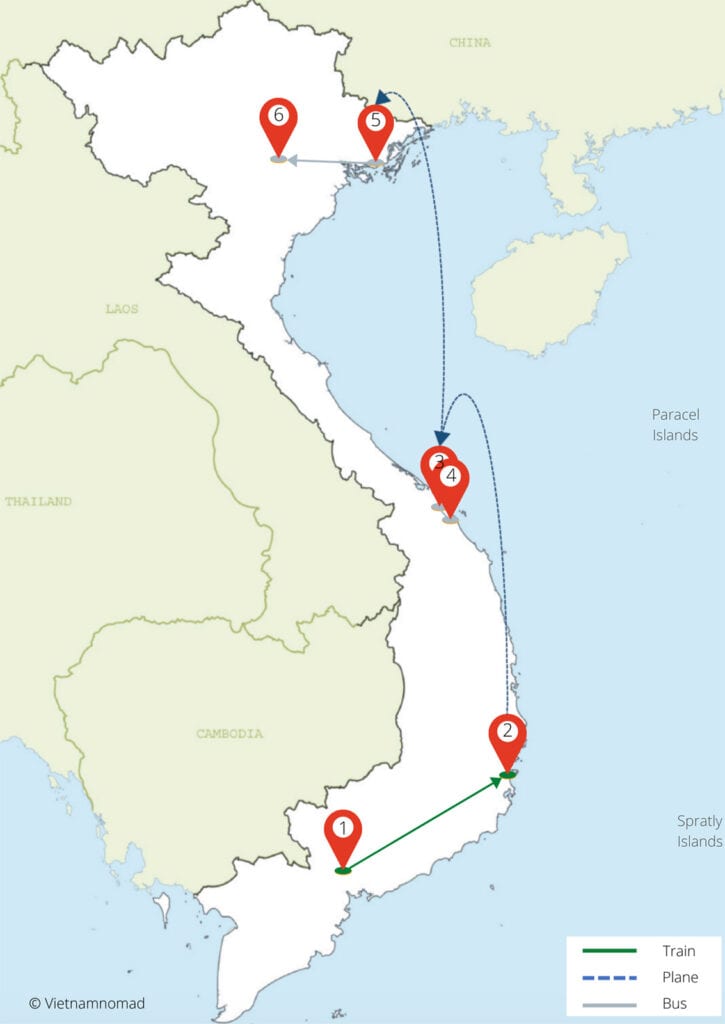
Vietnam travel guide book
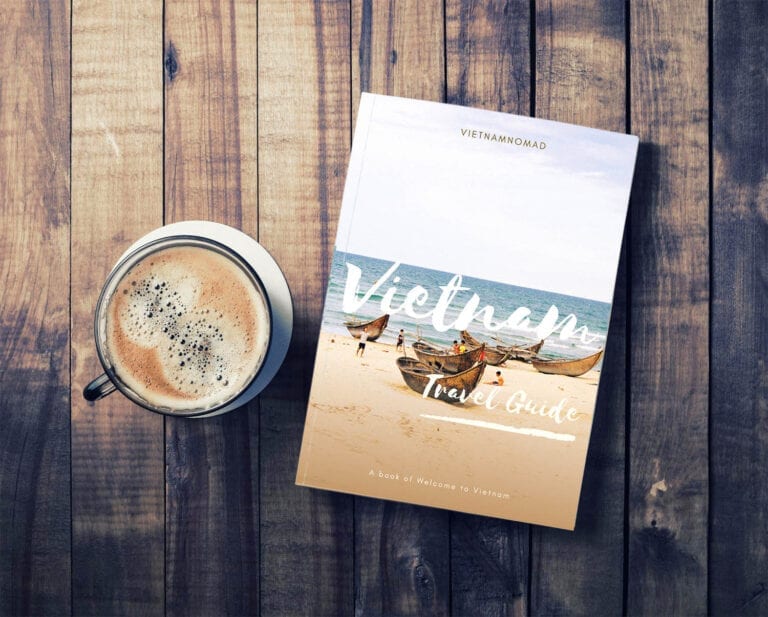
We would like to recommend a great companion: the Vietnam Travel Guide. The book contains travel information from overview to detail, consists of 6 chapters, 135 pages, which is designed in the form of graphics and visual images.
Read more >
Vietnam travel FAQs
What zone is vietnam in.
Vietnam is GMT/UTC + 7h during Standard Time (GMT +7) .
Is Vietnam worth a visit?
As a country that owns beautiful beaches, magnificent natural caves, delicious street food, fascinating history, and unique culture, Vietnam must be on the list of destinations to visit at least once in your lifetime.
What is the main language spoken in Vietnam?
Vietnamese’s native language is known as Vietnamese or the Kinh dialect, which is widely spoken by the majority of the Vietnamese. The language is written in the form of Latin alphabets with the addition of five tones. It may be tricky to learn, however, considered as tourist-friendly compared to other character languages in the area.
Do people in Vietnam speak English?
English is the common language in Vietnam. Vietnam ranks 31st among 72 countries in the world and seventh among 19 Asian countries in English proficiency, according to the latest annual English Proficiency Index released by the Swiss Education First (EF).
Is Vietnam safe for tourists?
Do you know? Vietnam is one of the safest countries in the world. A country without war, without ethnic conflict, without guns, without violence, and without terror. According to a recent survey, 78% of Vietnamese people feel that their life is happy or very happy .
What can you buy in Vietnam for 1$?
1 USD is equivalent to about 23.300 VND , a nutritious breakfast such as Pho or Hu Tieu, 2 cups of coffee, 2 loaves of bread, 4 bus tickets in Ho Chi Minh City, 4 500ml bottles of mineral water,… even a dinner!
How many days do you need in Vietnam?
Two weeks is sufficient time to explore Vietnam’s famous localities, but if you want to enjoy more fully, then four weeks would be ideal; 30 days is also the maximum stay for Vietnam E-Visa.
Is street food safe in Vietnam?
Street food is a Vietnamese specialty, mostly safe, but sometimes you can have a little stomach ache with strange foods. But it’s okay, you are traveling, right?
Should you tip at a restaurant in Vietnam?
To be honest, in Vietnam, we don’t have (or very little) “tip culture”. So if you eat in small or medium eateries, you don’t need to worry about it, just pay the right amount on the menu. Of course, you can tip a small amount if you wish to (we’re sure the server would be happy too) but note that it is not necessary.
Thank you for reading the Vietnam travel guide!
#MeetinVietnam
- Vietnam travel guide
Related Articles

Top Destinations
Travel guide.
- Best places
- Best dishes
- Vietnam visa
Helpful Resources
- Map of Vietnam
- Tourist maps
- Accommodation
- Privacy policy
- Our community
- Partner with us
© 2024 Welcome to Vietnam. All rights reserved.
This website utilizes cookies to improve user experience, analyze website performance and traffic, and deliver personalized content for marketing and advertising purposes. Privacy policy .

- Thailand Lantern Festival
- Indonesia(Bali)
- South Korea
- China (HK, Taiwan)
- Itinerary Ideas
- Asia Highlights Travel Reviews
- Thailand Travel Reviews
- Vietnam Travel Reviews
- Cambodia Travel Reviews
- Japan Travel Reviews
- Myanmar Travel Reviews
- China Travel Reviews

Vietnam Travel Guide: Customize a Personalized Trip
Vietnam is a country full of vibrancy, diversity, and cultural richness, boasting gorgeous landscapes and delectable cuisine. It offers a splendid array of activities and experiences to discover, whether you're traveling with children or enjoying a romantic getaway with your partner.
Popular Private Vietnam Tours
We present our most popular tours according to our clients' choices over recent years. You can treat them as inspiration for your private travel and tailor them according to your requirements.
10-Day Best of Vietnam with Mekong Delta
13-day vietnam classic tour with sapa, 2-week vietnam family-with-teenagers holiday, private southeast asia tours including vietnam, 12-day essential thailand, cambodia, and vietnam tour, 14-day vietnam and cambodia family tour, 14-day classic vietnam and thailand tour, 14-day vietnam, cambodia and laos itinerary: premium private tour, 2-week vietnam-cambodia tour with a luxurious mekong cruise.
Discover real reviews of Highlights Travel Family 's best-rated service across trusted platforms.
Plan a Trip to Vietnam
7 days in vietnam: top 6 itineraries, 10 days in vietnam: top 5 itineraries, 2 weeks in vietnam: top 4 itineraries, 3 weeks in vietnam: top 2 itineraries, plan a trip to southeast asia including vietnam, plan your first trip to vietnam - 7 easy steps, trip to vietnam and thailand, trip to vietnam and cambodia, trip to vietnam, thailand, and cambodia, vietnam weather by month, other popuoar asian tour destinations, get inspired with some popular itineraries.
At Asia Highlights, we create your kind of journey — your dates, your destinations, at your pace. You can have any trip tailor made for your travel.
More Travel Ideas and Inspiration
Sign up to our newsletter.
Be the first to receive exciting updates, exclusive promotions, and valuable travel tips from our team of experts.
Why Asia Highlights
Where can we take you today.
- Middle East
- African Safari
- Travel Agents
- Loyalty Program
- Privacy Policy
Address: Building 6, Chuangyi Business Park, 70 Qilidian Road, Guilin, Guangxi, 541004, China
Discover Hidden Gems: Vietnam's 10 Off-The-Beaten-Track Tourist Attractions
Immerse in the rich culture, scenic beauty, and history of Vietnam with some of the country's best off-the-beaten-path attractions and hidden gems.
Vietnam is one of the most underrated destinations in Southeast Asia, yet it's a beautiful country with rich culture and incredible history. From the ancient capital of Hanoi to the stunning beaches of Da Nang, there's no shortage of amazing places to visit in Vietnam. However, there are various off-the-beaten-track tourist attractions and hidden gems in Vietnam waiting to be explored.
From mysterious caves and parks to abandoned temples and floating markets, it's time to list some of the best off-the-beaten-track attractions in Vietnam, making for an unforgettable experience for those seeking places and activities away from the masses of tourists. These spots and their adventures are proof that Vietnam is among the most beautiful places in Southeast Asia to visit.
Related: 10 Places In Vietnam To Visit Now
10 Phong Nha-Ke Bang National Park
Located near the border with Laos in Vietnam and spanning over 800 square kilometers, visiting Phong Nha-Ke Bang National Park is bucket list-worthy yet happens to be among the less touristy things to do in Vietnam.
The park is a UNESCO World Heritage Site known for its spectacular limestone karst formations, underground rivers, and some of the largest cave systems in the world, with over 300 caves and grottoes, including the namesake Phong Nha and Ke Bang caves.
Besides the caves, the park has diverse flora and fauna, including many rare and endangered species. Visitors can explore the natural wonders scattered around the park and indulge in various recreational activities such as trekking, kayaking, and cycling.
- Best Time to Visit Phong Nha-Ke Bang National Park: March to August (the dry season)
9 Con Dao Islands
Located off the southern coast of Vietnam, in the East Sea, Con Dao Islands is a group of 16 famed for its pristine coastal landscapes. The islands offer incredible deserted beaches surrounded by lush greenery, including the most popular Dam Trau Beach, Dat Doc Beach, and An Hai Beach.
However, the islands' main attraction is the Con Dao National Park, featuring a diverse range of animal and plant species and various outdoor activities such as trekking, bird watching, and snorkeling in the park.
- Best Time to Visit The Con Dao Islands: October to February (for the dry season) or March to June (for the calmest ocean conditions)
8 Lan Ha Bay
Situated in the Cat Ba Archipelago, covering an area of 7000 hectares, Lan Ha Bay is among the best hidden gems in Vietnam; it's a stunningly beautiful bay, a relatively undiscovered spot, featuring crystal-clear waters and pristine sandy beaches.
The bay is surrounded by high mountains on three sides, offering visitors a wide range of activities such as kayaking, swimming, snorkeling, fishing, and exploring the many caves and grottoes scattered throughout the bay. Visitors can also take a boat trip around the bay to explore the incredible marine life and beautiful coral reefs.
- Best Time to Visit Lan Ha Bay: March and June or October and November (for the best weather)
Related: Dos And Don'ts When Traveling To Vietnam
7 Dong Van Karst Plateau Geopark
Nestled in the northernmost province of Vietnam, Ha Giang, covering an area of about 2,350 square kilometers, Dong Van Karst Plateau Geopark is one of the lesser-known places in Vietnam. It's also a UNESCO Global Geopark established in 2010.
Located 1,000 to 1,600 meters above sea level, the park features a rugged mountainous area characterized by steep limestone peaks, deep valleys, karst formations, caves, sinkholes, and winding rivers.
Although it's one of the lesser-known spots in Vietnam, the area does feature a wide range of activities, such as trekking, hiking, cycling, and sightseeing, offering visitors a chance to experience the natural beauty and geological wonders of the country.
- Best Time to Visit Dong Van Karst Plateau Geopark: September to November (for drier weather) or October to November (to see blooming buckwheat flowers)
6 Turtle Tower
Located on a small island in the middle of Hoan Kiem Lake, Turtle Tower is a small historical structure dating back to the 15th century and is one of the most iconic landmarks in Hanoi. The structure of the tower consists of a three-story building made of brick and stone, with a curved roof and decorative details on the walls.
Visitors can soak in the beautiful view of the tower and surrounding landscape from the shore but cannot access the structure in the center of the lake.
- Best Time to Visit Hoan Kiem Lake In Hanoi: October to November (for pleasant, cooler weather ideal for walking)
5 Pongour Waterfall
Located in the Central Highlands region of Vietnam, about 50 kilometers south of Da Lat City (which offers plenty to do) , Pongour Waterfall is among the most beautiful natural wonders in Vietnam, known for its dramatic beauty and serene surrounding valley covered in forests.
Pongour is one of the most beautiful waterfalls in Vietnam, as it cascades down a series of rock tiers, creating a stunning natural spectacle. Visitors to the waterfall can enjoy a range of activities, including hiking and swimming. Picnic areas and campsites are also available for visitors to soak in the beauty of the incredible natural landscape.
- Best Time to Visit Pongour Waterfall: December to Early March (for the dry season) or the 15th of the Lunar first month (typically February in the Gregorian calendar) for the waterfall's K'Ho festival
Related: 10 Best Ways To Explore Halong Bay, Vietnam
4 Huyen Khong Son Thuong Pagoda
Huyen Khong Son Thuong Pagoda, also known as Huyen Khong Pagoda, is one of the off-the-beaten-path attractions in Vietnam. It's a pretty Buddhist temple located on a hillside in the Marble Mountains in Da Nang.
Built in the 17th century by a Buddhist monk Minh Dung, the temple is famous for its serene natural surroundings and unique architecture. The structure of the temple is made from stone and features a series of caves and grottoes adorned with intricate carvings and paintings, offering visitors a glimpse of Buddhist culture and mythology.
- Hours: 24 Hours
- Admission: Free
3 Cai Be Floating Market
Cai Be Floating Market is a vibrant and unique market in the Mekong River Delta, Vietnam. The market was originally established as a place for farmers to sell their goods but is now a lively and colorful market. While it's not exactly one of the most uncrowded places in Vietnam to visit, it's worth checking out to see the bustling local way of life in the Mekong Delta area.
The market's vendors sell a wide range of goods, including fresh fruits, vegetables, seafood, and local specialties, such as coconut candy, rice paper, handicrafts, and souvenirs, from their boats. Visitors to the floating market can experience the unique culture and activities of the Mekong Delta region , with waterways as the main mode of transportation and commerce.
- Best Time to Visit Cai Be Floating Market: 5:30 AM to 6:30 AM daily (to see the most vendors) and November to April (for the driest weather)
2 Muong Hoa Valley
Located northwest of Vietnam in the remote town of Sapa (home to must-do activities) of Lào Cai Province, Muong Hoa Valley is a scenic valley known for its rich cultural heritage, serene landscape, and unique trekking experiences.
The valley is home to some of the lesser-known attractions in Vietnam and is surrounded by lush forests, rice terraces, and small villages inhabited by ethnic minority groups, including the Hmong, Dao, and Tay.
The area is among the less touristy places in Vietnam, but it's treasured for its hiking opportunities. The trekking routes in the valley vary in difficulty, offering incredible views of the local villages and beautiful rice terraces scattered over the lush green mountains. The valley also has several beautiful waterfalls, including Silver Waterfall and Love Waterfall.
- Best Time to Visit The Muong Hoa Valley: March to May (for pleasant weather, views of lush green rice terraces, and cultural activities)
Related: 8 Things Vietnam’s Ha Long Bay is Famous For
1 Ba Be Lake
Found in the northeastern province of Bac Kan, approximately 230 kilometers from Hanoi, Ba Be Lake is among the largest natural freshwater lake in Vietnam. Situated in Ba Be National Park (which visitors can book a tour of) , visiting this lake is one of the off-the-beaten-path things to do in Vietnam away from the crowds.
Ba Be Lake covers an area of about 500 hectares, surrounded by karst mountains, lush forests, and small villages. Visitors to the lake can take boat tours to enjoy the stunning scenery and diverse wildlife ecosystem of the lake. Some of the highlights of the boat tour include Puong Cave, Dau Dang Waterfall, and Widow Island.
- Best Time to Visit Ba Be Lake: August to October (for the best swimming and kayaking experience at Ba Be Lake)
An official website of the United States government
Here’s how you know
Official websites use .gov A .gov website belongs to an official government organization in the United States.
Secure .gov websites use HTTPS A lock ( Lock Locked padlock icon ) or https:// means you’ve safely connected to the .gov website. Share sensitive information only on official, secure websites.

International travel documents for children
See what documents a child needs to travel to or from the U.S. alone or with a parent or relative.
Children traveling to the U.S.
All children, including infants, must have their own travel documents such as a passport or document from a Trusted Traveler Program to enter the U.S. If you travel or are going to travel with a child, consider taking the following documents:
- If the child is traveling with only one of their custodial parents, they must have a letter of consent, preferably in English and notarized, from the other parent or signed by both parents. The letter should say "I acknowledge that my son/daughter is traveling outside the country with [the name of the adult] with my permission."
- If one parent has sole custody of the child, a copy of the custody document can take the place of the other parent's letter.
- Parents who frequently cross the border by land with a minor must always carry a letter of permission from the other parent.
U.S. citizen children traveling abroad
Ports of entry in many countries have security measures to prevent international child abduction . If you are traveling alone with your child, you may be required to present documentation proving you are the parent or legal guardian. You may also need a letter of permission from the other parent for your child to travel.
If your child travels alone, depending on the country, they may be required to present a notarized letter from both parents or their legal guardian. If a minor is traveling abroad and is not accompanied by both parents or a legal guardian, contact the embassy or consulate of the country you will be visiting and ask about entry and exit requirements for that country.
LAST UPDATED: December 6, 2023
Have a question?
Ask a real person any government-related question for free. They will get you the answer or let you know where to find it.

Europe Travel Guide
Last Updated: April 18, 2024

From beautiful Paris to smoke-filled coffeeshops in Amsterdam, Oktoberfest to La Tomatina, Europe is a massive, diverse continent with an unlimited assortment of things to see and do. You won’t have any problem filling your time, whether you’re backpacking Europe for a few months on a budget or just spending a few weeks there on a well-earned vacation.
The continent boasts wonderful beaches, historical architecture, amazing wine, and tons of world-class festivals. Every country is incredibly different from the next too, providing limitless variety in what you do during your trip.
I first backpacked Europe in 2006 and was hooked immediately. I’ve been visiting every year since, have run tours around the continent, and even wrote a book on traveling in Europe . It’s a destination I love and never get tired of exploring.
This guide will give you an overview of Europe and the tips and tricks you need to start planning your trip. I’ve also written extensive travel guides to each country on the continent (linked below in this post) so you can get more in-depth information for your specific itinerary too!
Table of Contents
- Things to See and Do
- Typical Costs
- Suggested Budget
- Money-Saving Tips
- Where to Stay
- How to Get Around
- How to Stay Safe
- Best Places to Book Your Trip
- Related Blogs on Europe
Click Here for Country Guides
Top 5 things to see and do in europe.

1. Tour the Greek Islands
These islands are the mecca of summer beach fun and each is unique in its own great way. There’s Ios (beach party central with archeological ruins and awesome boat tours); Kos (ancient ruins and nature); Crete (Bronze Age ruins of Knossos, hiking, beaches, and wine), Santorini (iconic blue water, white buildings, and local wineries); Mykonos , (the upscale party island with beautiful beaches, villages, and sunsets), Naxos (best island in the Cyclades). Plus, Milos, Corfu, Lemnos, Zakynthos, and so many more! With hundreds of islands in the country, you can always find what you are looking for!
2. Ride the rails
Europe is famous for its international rail system. Rail passes like the Eurail Pass have been around forever and still make it very easy to get from country to country on a relatively small budget (and with lots of flexibility). Europe has some of the fastest trains in the world that travel up to an incredible 217 mph (350 kph). The whole continent is connected by trains and there’s a growing push for even more connections and long-distance, high-speed trains in order to reduce flying and help combat climate change. There’s nothing more quintessential than riding the trains in Europe and I encourage you to take as many trains as possible. It’s one of the best ways to see the continent.
3. Get lost in Paris
The “City of Lights” is everything people say it is. I fell in love with it the first time I stepped foot in Paris . The city is just magical. You have a ton of museums, cafes, jazz clubs, famous art, and beautiful architecture. I love just strolling around the streets of the Quartier Latin (Latin Quarter) or Montmartre neighborhood as it makes for a breathtaking day. Another one of my favorite things to do here is just sit in the Jardin des Champs-Élysées park and picnic like the Parisians. For something a bit different, check out the famous Catacombs and Paris Sewer Museum. With so much to offer in the way of culture, history, and gastronomy, it would take years to see everything here but you can still get a good feel of the city in a few days.
4. Go city hopping
There are so many amazing cities in Europe that we’d need a top 100 to list them all. Here are some of my personal favorites and must-see cities: London is rich in history, culture, and the famous Big Ben clock; Edinburgh is a vibrant medieval city with cozy pubs and a famous castle with a huge New Year’s Eve Party; Amsterdam has cozy coffee shops and canopied tree-covered canals; Berlin has a wild party scene, street art, and the Berlin Wall; Barcelona has tapas, beach, and unique Gaudi architecture; coastal Lisbon has colorful tiles, old tramcars, cobblestone streets and plenty of fresh seafood; Prague has a beautiful intact Old Town, incredible architecture and eclectic bars; Tallinn Estonia has beautiful medieval buildings with colorful roofs. Florence is a mecca for Italian Renaissance architecture, art history, and gelato; Stockholm mixes medieval architecture and modern art and design. Crisscross the continent, take in the culture, and enjoy all the historic cities!
5. Hit the Alps
Whether you go skiing in the winter or hiking in the summer, the Alps hold some of the most breathtaking views in all the world. You don’t even need to be an expert hiker because there are mountain trails for all levels and crystal-clear Alpine lakes. Check out the spectacular Eibsee trail loop in Bavaria at the foot of Die Zugspitze, Germany’s tallest mountain, for the clearest, multi-colored, sparkling lake you’ve ever seen. Or the Männlichen Kleine Scheidegg Panorama trail in Switzerland’s stunning green and snow-capped Alps. Or visit Italy’s Dolomites in South Tyrol for the scenic Seceda trail. The Alps have trails for every fitness level and in every season.
Other Things to See and Do in Europe
1. tour amsterdam.
I love Amsterdam so much that I lived here for a short period of time in 2006. Here cobblestone and brick streets weave around lovely canals as people ride their bikes to and fro. My favorite things to enjoy here are Amsterdam’s vibrant art and music scene and there are also a ton of interesting museums here like the Anne Frank House, FOAM, the history museum, and the hemp museum. Be sure you get out of the center into Jordaan and Oost with their wonderful outdoor cafes and fewer tourists. Also, a visit to Amsterdam wouldn’t be complete without a canal cruise to visit the many islands and there are many to choose from that include snacks and drinks, sunset cruises, live guided tours, and more.
2. Hang out in Barcelona
Barcelona is a city that goes 24 hours a day, 7 days a week. It truly could give NYC a run for the “city that never sleeps” title. Be prepared for late-night dinners and parties until dawn. Besides a great food and nightlife scene, there is a wonderful beach, tons of Gaudi architecture (including the fairytale-like Parc Güell, as well as the iconic Sagrada Familia , which has been under construction for over 100 years!), incredible food tours, one of the best history museums in the country, and lots of outdoor spaces. What I love about Barcelona is that when you’re ready to chill, you can wander around Parc de la Ciutadella and marvel at the majestic fountains, plant life, and buildings created from an ornate military fortress.
3. Visit Berlin
Hip and trendy Berlin is an energetic destination. It is one of Europe’s most affordable capital cities, with a vibrant music and art scene and a growing foodie movement. Be sure to spend some time learning about the city’s darker history via the many excellent museums, memorials, and landmarks. The East Side Gallery, a section of the Berlin Wall that’s now painted with murals, and the Memorial to the Murdered Jews of Europe are two especially powerful reminders of Germany’s past. For all periods of German history, don’t miss the Deutsches Historisches Museum (German Historical Museum) – it’s one of the best history museums in the world. Once you’ve had your fill of history, relax in Berlin’s many green spaces, from Tempelhof Field, the site of a former airfield and popular local hangout spot, to Tiergarten, a tree-covered former hunting ground for 17th-century aristocrats.
4. Drink beer at Oktoberfest
Oktoberfest is a must for anyone going to Germany at the end of September. While not a budget option since beers now cost 15 € a maß, I love the energy and friendly camaraderie this event inspires. For two weeks, millions of people from all over the world gather for lots of beer, excitement, music, and wild fun. Watching thousands of people sing together, raising quart-sized beer mugs for endless toasts, and enjoying the general party atmosphere makes you feel good about the world. (Or maybe that’s just the beer?) Just be sure to book your accommodation well in advance and be prepared to pay top prices for them. If you don’t have an outfit, don’t worry, there are plenty of shops even at the main train station where you can buy a Bavarian dirndl dress and men’s lederhosen.
5. Experience London
Get a taste of English culture in diverse London . The museums here are some of the best in the world (most are free) and include the Tate, the British Museum, the City Museum, the National Gallery, the Historical Museum. There’s no shortage of iconic sights here as well, with Big Ben, the House of Parliament, the London Eye, the Tower of London, Tower Bridge, and of course, Buckingham Palace. I love London’s diversity because of the countless international eateries with great food and wonderful pub culture, perfect for after a long day seeing the sights. Head to Brick Lane on the weekends for some amazing food and craft markets. I prefer Paris to London, but there is something sophisticated and fun about London. Just watch those pints — London is not a cheap destination!
6. Get outdoors in Scandinavia
My favorite region in Europe is Scandinavia. The quality of life here is high, the people are beautiful and friendly, and the cities are clean and historic. Cycling the cities, taking canal tours, hiking the vast forested areas, archipelago hopping, enjoying fika (a Swedish coffee break), and warming up in saunas are just a few of the popular activities that await you here. True, this area of Europe is not cheap, but there are plenty of ways to reduce your expenses. Don’t let the high prices scare you away. Highlights for me include Copenhagen , Stockholm , Gotland, Norway’s fjords, and Lapland in Finland .
7. Get enchanted in Prague
Prague has an amazing history and is one of the most beautiful and picturesque cities I’ve ever seen. Highlights include the 9th-century Prague Castle, the magnificent Charles Bridge (built in the 14th century and one of the oldest standing bridges in the world), the 10th-century old square with its iconic astronomical clock, and the winding Jewish Quarter. Even if you only have a few days there don’t miss the free walking tour which is one of my favorites in Europe and the best way to learn about the Old Town and the tragic history of the city that went from thriving Bohemian capital of art, music, and literature to part of the Iron Curtain after WWII. Some of my favorite gems here include the fantastic black light theater shows in 4D and the one-of-a-kind medieval dinner show in an old tavern complete with musicians and jugglers not to mention hearty food and drinks. During the weekends it heaves with people enjoying the bars, cheap beer, and delicious food so try to visit during the week (and in the spring or fall) to beat the crowds.
8. Relax on the French Riviera
Here, you can pretend to live the high life for a little bit. Have fun in the sun, relax on the beach, swim in azure blue water, hobnob with the rich and famous, and sail on (or gaze at) gigantic yachts. As for cities, Nice is nice with its palm-tree-lined promenade, old town, and many art museums. If you want to go see how the rich and famous live, spend an afternoon checking out Cannes to soak up some glamorous vibes on La Croisette where they hold the famous Cannes Film Festival. The kingdom of Monaco with its tiny streets, beautiful buildings, and world-famous casino is just a skip away too.
9. Enjoy the great outdoors in Interlaken
Located in the beautiful mountains of Switzerland, Interlaken is a gorgeous place to unwind with fantastic hiking, delicious hot chocolate, and plenty of outdoor sports. The area is full of natural attractions to explore, including the St. Beatus Caves (complete with a legendary dragon), the cascading 500-meter-high (1,640 feet) Giessbach Waterfalls, the Jungfraujoch mountain railway (which leads to the highest train station on the continent), and a plethora of lakes (hence the town’s name). It’s a good alternative to all the cities and museums. Interlaken is also a popular party destination for backpackers and other young travelers. By far, my favorite scenic and visually stunning trail was the Oberberghorn panoramic hike, where you can wander the green mountain ridge ogling the amazing views and the turquoise-blue Brienzersee.
10. Experience history in Rome
In this thriving historical city, you can’t walk two feet without stumbling over a ruin, making Rome a history buff’s dream. Its tiny streets are perfect for wandering as you explore the Colosseum, see the Forum and Palatine Hill, visit the Pantheon, spend time in Vatican City, admire the Spanish Steps, and toss coins into the famous Trevi Fountain. The skip-the-line tickets can definitely be worth it so you don’t waste time waiting outside attractions. Rome also has amazing food (it’s Italy, after all) and nightlife. Visit the Trastevere area for a taste of “local” Rome and chill bars. It’s my favorite area in the city because you feel like you’re in a small village in the middle of a big city.
11. Hike around the Cinque Terre
Cinque Terre is my favorite part of Italy. These five beautiful cliffside towns are perched near warm waters and beautiful olive and grape groves. There are wondrous and strenuous hikes in these hills; for a real challenge, take trail #8. Or just walk the coastline for something less difficult. Many activities here revolve around the coastline: kayaking, swimming, having a beach picnic or visiting the Technical Naval Museum. If you happen to be here in December or January, don’t miss the Nativity Manarola, the world’s biggest lighted nativity scene.
12. Tour Krakow
Krakow looks like it stepped out of a medieval postcard. It’s a hip, trendy, and youthful city that’s the center of education in Poland, meaning there are a lot of university students here. Most travelers come to party here (the vodka is cheap) but try to enjoy the city’s history and food besides just the bars. Walk the Royal Road through the Old Town to the 13th-century Wawel Castle, tour Schindler’s Factory (where Schindler saved over 1,200 Jews during World War II), and visit the sobering Auschwitz-Birkenau concentration camp. You can also take a fascinating day trip to the UNESCO World Heritage Wieliczka Salt Mine, a 13th-century mine with cavernous chambers, statues, chapels, chandeliers, and cathedrals all carved out of salt.
13. Visit the ruin bars in Budapest
The coolest nightlife in all of Europe is found in Budapest . Built in abandoned buildings, ruin bars feature funky art installations, repurposed furniture, and quirky decor. They are amazing, fun, and great places to meet locals, as people of all ages flock here. Open since 2001, Szimpla Kert is the original ruin bar and one of my favorites, along with Instant-Fogas Complex, which takes up an entire building and is actually many different bars in one. Don’t skip the ruin bars — they’re one of the most unique things about the city!
14. Explore Cornwall
The best part of England is outside London, yet unfortunately, not a lot of travelers leave London. Head west to the area of Cornwall for cheaper prices, welcoming locals, natural beauty, great hiking, rolling hills, plenty of medieval castles, and picturesque small towns. If you like biking, the Camel Trail from Bodmin to Padstow is worth the trip and you even pass by a local vineyard. It’s an easy way to spend a day (and it’s pretty flat so it’s not too hard to do.) Plus, I had the best fish and chips in Cornwall! Overall, it’s what you think of as “traditional England.”
15. Walk the Camino
El Camino de Santiago (The Way of Saint James) is an ancient pilgrimage route that stretches from France all the way across northern Spain. It is a 500 mile (800 km) trail that winds through incredible terrain, ending in Santiago de Compostela at the cathedral where St. James is supposedly buried. As a pilgrim, you get a “pilgrim’s passport” which allows you to stay in affordable pilgrim-only hostels, making this a surprisingly budget-friendly adventure. While it usually takes over a month to complete, you can just walk a section if you don’t have the time. To receive a “Compostela” (certificate of completion), you just need to walk the last 62 miles (100 km), which generally takes 4-5 days.
16. Throw tomatoes during La Tomatina
By far my favorite festival, the largest food fight in the world happens during the last Wednesday of August in Bunol, Spain. What started in 1945 as a local brawl has turned into a massive event drawing tens of thousands of people from all over the world. For about an hour, everyone throws tomatoes at each other, leaving streets ankle-deep in tomato juice. Afterward, everyone walks down to the river, cleans off, and then heads to the town square for sangria and music.
17. Find Dracula in Romania
Not a lot of people visit Romania but this underrated country in Eastern Europe has undiscovered yet picturesque medieval towns like Brasov (home to “Dracula’s castle”), Sighisoara, and Sibiu; gorgeous beaches on the Black Sea; and incredible hiking in the Fagaras Mountains — all at dirt-cheap prices. Other major sights include frescoed Byzantine monasteries, the steepled wooden churches of Transylvania, the hip university town Cluj-Napoca, the post-communist capital of Bucharest, and the Danube Delta, a huge nature reserve.
18. Drink whisky in Islay
Whisky has a long history on Islay , an island off Scotland’s west coast. It’s been made there since the 16th-century — first in backyards and then, starting in the 19th-century, in large distilleries. Over the years, whisky from the island came to be considered a specialty and was used to flavor a lot of other blends on the mainland. There are currently nine working distilleries on the island, all located along the island’s shores, with Laphroaig, Ardbeg, and Lagavulin being the most famous. Most distilleries here make single-malt Scotch, meaning that only one type of grain (barley) is used. My visit here was amazing and, even if you don’t like whisky, there are tons of good hikes and walks throughout this magnificent island.
19. Explore Iceland
Iceland is a magical country with majestic waterfalls, hidden hot springs around every corner, and sweeping vistas unlike anywhere else in the world. After my first visit, the country quickly became one of my favorite countries. With whale watching in the summer, the northern lights in the winter, and geothermal baths for soaking in year-round, there really is no bad time to visit! While Iceland’s main draw is the epic natural landscapes, it’s worth spending a couple of days in Reykjavik with its café culture, artsy feel, and brightly colored wooden row houses.
20. Sail the Croatian coast
With calm winds, short distances, a coastline littered with over 1,000 islands, and countless historical sites, Croatia is one of the world’s best sailing destinations. If you can, go during the shoulder season when you can find some great deals. Plan to stay at least a couple of days on one of the islands, with the most popular being Brac, Hvar, Krk, Cres, and Lošinj. However, don’t be afraid to get off the beaten path and explore some of the lesser-known islands such as Silba, Vis, and Lastovo. If you want to splash out and spend a week partying on a yacht, check out The Yacht Week, which hosts week-long parties, complete with DJs, from May-September. You can book a full boat to share with friends or just a cabin if you’re traveling solo. Prices start at 5,250 HRK per person and go up to 9,300 HRK.
21. Explore the Balkans
While the Balkans have become more popular with backpackers in recent years, it’s still largely overlooked by most budget travelers, despite being an extremely budget-friendly region. The Balkan peninsula is home to great (and again, overlooked) wine, beautiful medieval towns like Kotor and Mostar, stunning mountainous landscapes, beautiful pebble beaches, coffee culture, fresh, hearty yet inexpensive food, and museums covering the area’s history, including the most recent turbulent events of the early 1990s. I especially loved my time in Albania . Don’t miss the beautiful beaches in Ksamil, nicknamed the “Maldives of Europe’ as well as the mountain village of Gjirokastër, which was occupied by Romans, Byzantines, and Ottomans. The Balkans have so much to offer for every budget and every country has its unique cultural flavor.
22. Take a wine tour in the Loire Valley
Located in central France, the picturesque Loire Valley is a UNESCO World Heritage site and stretches 280 kilometers (174 miles) along the Loire River. One of the major wine-producing regions of France, the area is home to some of the best wines in the world, with over 1,000 vineyards open to the public. Even those who don’t drink wine will enjoy the beautiful small towns, great food, and the region’s over 300 impressive chateaux. I loved the medieval Chenonceau Castle and Chateau Villandry and the small villages like Saint-Florent-le-Vieil. Spring and Autumn are my favorite times to visit because you can go biking and do outdoor activities when it’s not too hot and there are fewer people. It’s an area not to be missed.
23. See Fado in Portugal
Fado is an important musical tradition in Portugal , originating in Lisbon and stretching back some 200 years. The word “fado” likely stems from the Latin word for fate, and it’s very haunting, poetic, and emotional music. Most of the songs follow themes of loss and mourning, and the music was popular with the working class (especially sailors). Performances normally take place in restaurants during dinner. In Lisbon, head to Clube de Fado, Tasca do Chico, Parreirinha de Alfama, or Senhor Vinho.
24. Tour green Slovenia
Slovenia is one of Europe’s least-visited destinations, which is mind-blowing to me because it’s an amazing place to visit. Slovenia offers all the beauty of Western Europe but at a fraction of the cost and with a fraction of the crowds. Perfect for outdoor adventure lovers, Slovenia offers rugged mountains, untouched landscapes, fantastic ski resorts, plentiful wine, sprawling cave systems, incredible food, and postcard-perfect lakes, such as the famous Lake Bled with its castle on an island. I loved Piran, Slovenia’s often overlooked coastal Venetian-style harbor town that was actually founded 3000 years ago. Stroll around its beautiful windy cobble-stoned streets, beautiful plazas, and take advantage of the many affordable restaurants right on the water. Make sure to also spend a few days in the country’s capital, Ljubljana, known as one of the continent’s greenest and most livable cities. Take a river cruise to see the city and enjoy the friendliness of the locals.
For more information on specific countries in Europe, check out the guides below:
- Albania Travel Guide
- Austria Travel Guide
- Belgium Travel Guide
- Belarus Travel Guide
- Bosnia & Herzegovina Travel Guide
- Bulgaria Travel Guide
- Czechia Travel Guide
- Croatia Travel Guide
- Denmark Travel Guide
- England Travel Guide
- Estonia Travel Guide
- Finland Travel Guide
- France Travel Guide
- Germany Travel Guide
- Greece Travel Guide
- Hungary Travel Guide
- Iceland Travel Guide
- Ireland Travel Guide
- Italy Travel Guide
- Latvia Travel Guide
- Lithuania Travel Guide
- Malta Travel Guide
- Moldova Travel Guide
- Montenegro Travel Guide
- Netherlands Travel Guide
- Norway Travel Guide
- Portugal Travel Guide
- Poland Travel Guide
- Romania Travel Guide
- Scotland Travel Guide
- Slovakia Travel Guide
- Slovenia Travel Guide
- Spain Travel Guide
- Sweden Travel Guide
- Switzerland Travel Guide
- Ukraine Travel Guide
Europe Travel Costs

Accommodation – Accommodation prices vary greatly by region. In Western Europe, hostel dorm rooms cost between 25-45 EUR per night, depending on the room’s size and the popularity of the hostel. I stayed in a 6-bed dorm in Berlin for 20 EUR, while the same one would have cost me around 45 EUR in Paris. A room in Paris costs on the higher end and a room in cheaper Athens costs on the lower end.
In Eastern Europe, hostel dorm rooms cost between 10-15 EUR per night depending on the size of the dorm room and the popularity of the hostel. The further east you go, the cheaper it gets. Expect to pay around 30-60 EUR per night for a private room that sleeps two.
In Scandinavia, hostel dorm beds cost around 25-45 EUR, while private rooms are 65-80 EUR. Budget hotels start around 85 EUR.
Most accommodations offer free linens, free Wi-Fi, and a lot offer free breakfast, but it’s important to check specific websites for exact amenities.
Campsites cost between 10-15 EUR per night for a basic plot for two without electricity.
Food – Food traditions in Europe run deep, stretching back centuries to become integral parts of each country’s culture. From baguettes in France to tapas in Spain, from hearty Eastern European stews and goulash to the fresh vegetables and olive oils of the Mediterranean, European cuisine varies as much as the countries themselves. Food prices differ greatly across the continent, so check individual country guides for specifics.
But no matter where you are, even in the more expensive countries, finding places to eat within your budget is easier than you might think. Throughout Western Europe, you can find small shops, street food stalls, or food trucks where you can get sandwiches, gyros, kebabs, slices of pizza, or sausages for between 3-7 EUR. These shops are most often found in train stations, bus stations, and main pedestrian areas, and offer cheap food alternatives that can have you eating on 12-17 EUR per day. Fast food (think McDonald’s) costs around 7-10 EUR for a combo meal.
Turkish, Middle Eastern, and Vietnamese eateries abound in Germany, while Indian food is incredible and everywhere in the United Kingdom. Meals at these restaurants usually cost between 8-12 EUR.
Restaurant meals in casual, traditional eateries generally cost around 13-25 EUR for a main dish and drink. Food is much cheaper in the east than in the west, and in the west, northern regions like Scandinavia and the UK are more expensive than southern countries like Spain, Portugal, and Italy.
In Eastern Europe, even if you are eating out for all your meals, you can still get by on a food budget of as little as 15 EUR per day.
For drinks, a pint of beer is 2-5 EUR, a glass of wine is 2-7 EUR, a cappuccino is 2-5 EUR, and cocktails range from 6-14 EUR.
If you eat out, do so at lunch and get the prix-fixe menu (two-course or three-course set menu). Restaurants offer this set menu during lunch, and with prices between 10-20 EUR, it’s a way better deal than the regular dinner menu. You can also get affordable lunches at outdoor markets. So many European cities have huge fresh food markets throughout town.
You can cook your own food for around 45-65 EUR per week. This gets you basic staples like rice, pasta, seasonal produce, bread, and some meat. You can save money by shopping at discount supermarkets like Profi, Lidl, Aldi, and Penny Market.
If you want to save big money on meals, head to one of the markets, pick up some cheese, wine, bread, meats, or anything else, and go to the park for a picnic. (Or grab a sandwich for later!) You’ll find the locals doing the same thing, and it’s one of the cheaper ways to get a true taste of local food.
Backpacking Europe Suggested Budgets
Prices for travel in Europe vary greatly depending on how far north, east, south, or west you travel. If you stick to the budget accommodations, food, and tours listed here and use all my tips on saving money, you need about 65-110 EUR per day in Western Europe, 40-50 EUR in Eastern Europe, and about 85-130 EUR in Scandinavia.
Those numbers reflect a traveler who stays in hostels, cooks some meals and eats out cheaply, enjoys a few drinks, and sticks to free and cheap activities like hiking, walking tours, and enjoying nature. This is your typical backpacker budget. You aren’t going to have a fancy time, but you aren’t going to want for anything either.
However, by getting tourist cards and rail passes, avoiding flights, occasionally Couchsurfing or camping, cooking all your meals, and not drinking, you can travel a lot cheaper. On this budget, you could do Western Europe on 35-45 EUR per day, Eastern Europe on 20-25 EUR, and Scandinavia on 50-65 EUR. That would require you to take a train or a bus or hitchhike everywhere, skip most museums, and limit how often you go out.
Generally, the suggested daily budget for Europe is 80-120 EUR. You can use the chart below to get an idea of how much you need to budget daily. Keep in mind these are daily averages – some days you’ll spend more, some days you’ll spend less (you might spend less every day). We just want to give you a general idea of how to make your budget. Prices are in EUR.
Europe Travel Guide: Money-Saving Tips
Individual country guides have more specific information on how to save money in them but here are some general tips on cutting your costs while you explore Europe:
- Picnic – This continent has a lot of little shops where you can buy pre-made sandwiches or ingredients to make your own. Many supermarkets have delis as well where you can get food to go. Buy some food, eat outside, and watch the city and its people go by. It’s a much more enjoyable and cheaper way to eat.
- Eat local and cheap – Not into picnicking? Eat at local sandwich shops, pizza parlors, Maoz, Wok to Walks, and outdoor street vendors. Avoiding restaurants and eating at a lot of the local “grab n’ go” places gives you a taste of the local cuisine at a much cheaper price. If you’re really on a budget, use your creative cooking skills to prepare meals at the hostel as well.
- Stay with a local – Hostels can add up really quickly. If you don’t have any friends with whom you can stay, consider using Couchsurfing , which connects you with locals who let you stay with them for free. Plus, they tend to also have meetups to meet other locals and travelers. It’s a great way to save on accommodation and meet a local who can share their insider tips and advice.
- Camp in a garden – A very good camping service specific to Europe is Campspace , which allows you to pitch a tent in someone’s backyard for free or for a small fee (around 10-20 EUR). All of the garden owners have profiles that tell you what services and facilities they offer. Also, many countries allow wild camping (like Sweden), which can save you a fortune if you have a tent.
- Take the bus – Budget bus companies like Flixbus can take you across the continent for cheap. I personally feel it’s best for day travel as sitting up for an overnight bus isn’t really ideal for sleeping. It isn’t glamorous, but with tickets starting at 5 EUR, you really can’t complain!
- Get a Rail Pass – Eurail Passes have saved me hundreds of dollars. If you are traveling far distances and through many countries, they are a great deal.
- Take the free city tours – One of the great things about Europe is that you can find free walking tours in all the major cities. They can be a great way to see the city attractions, take in some history, and learn your bearings without spending any money. Just make sure to tip your guide at the end!
- Plan accordingly – Plan your trip around Europe so you avoid doubling back. Transportation is a big expense so proper planning can save you a lot of money (and time). Go in a straight line or a loop. Booking your accommodation ahead helps you save as well since cheap, good places unsurprisingly get reserved first. One thing I’ve learned is that waiting until the last minute means you get stuck with expensive places or cheap places no one wants.
- Fly cheap – If you know where you are going and a train won’t do, try to book flights early. You can often get round trip fares for as little as 5 EUR from many of the European discount airlines like Ryanair or Wizz. Many capital cities have smaller airports farther from the city with ‘inconvenient’ times but cheaper fares. Keep in mind you might need to factor in an early morning Uber or taxi if the busses aren’t running and you have an early flight!
- Drink less – Those 5 EUR beers add up. Hit happy hours or pick and choose when you party. Hostel bars are a good place to get cheap drinks or buy your alcohol at the supermarket. Plus, in Europe, it’s legal to drink outside in parks, plazas, by the lakes or rivers. You’ll find you can save a lot of money by not going to bars and clubs. Partying your way across the continent will destroy your bank balance in no time.
- Get a city tourist card – Many local tourism offices sell a tourism card for all their attractions, tours, and restaurants. This card gives you free entry and substantial discounts on all the attractions and tours in a city, free local public transportation (a huge plus), and discounts at a few restaurants and shopping malls. They save a ton of money. If you plan on doing a lot of sightseeing, get one of these cards.
- Rideshare – If you’re flexible in your schedule, use the ridesharing service BlaBlaCar to catch rides with locals between cities (or countries) by paying a small fee. It’s like Airbnb but for rides. I used this service in Switzerland and, not only did I save a lot of money, but I got to meet interesting people and learn about local culture and life. Drivers are verified and it’s perfectly safe, though sometimes rides cancel at the last minute (which is why you need to be flexible). Check their ratings first and try to use rides where the person has done many trips.
- Bring a water bottle – The tap water is safe to drink in most of Europe, so bring a reusable water bottle to save money and reduce your plastic use. LifeStraw is my go-to brand as their bottles have built-in filters to ensure your water is always clean and safe.
- Get a HostelPass – HostelPass is a discount membership for hostels in Europe. Members get 10-20% off select hostels around Europe, as well as perks like free breakfast or free drinks. There are discounts on tours and activities too. It’s a great way to save money if you’re bouncing around Europe as they have hostels in 18 countries around the continent.
Where to Stay in Europe
Europe has a ton of budget accommodation options. The individual country and city guides have tons of recommendations but here’s a short list of some of my favorite budget hostels and hotels around Europe:
- The Flying Pig (Amsterdam, The Netherlands)
- Hotel 54 (Barcelona, Spain)
- Generator Hostel (Copenhagen, Denmark)
- Harcourt Hotel (Dublin, Ireland)
- Castle Rock (Edinburgh, Scotland)
- Ios Palm Pansion (Ios, Greece)
- Greg and Tom’s Party Hostel (Krakow, Poland)
- Largo da Sé Guest House (Lisbon, Portugal)
- Sophie’s Hostel (Prague, Czech Republic)
- The Yellow (Rome, Italy)
- City Backpackers (Stockholm, Sweden)
How to Get Around Europe

Public transportation – Transportation around most European cities is by tram, subway, or bus. Prices are typically around 2 EUR for a one-way ticket in Western Europe and closer to 1 EUR in Eastern Europe. Most large cities also have day passes available that offer unlimited public transportation. These passes are usually 5-12 EUR per day.
In large cities with international airports, there is usually a bus or train available that ferries travelers from the downtown core to the airport. Expect to pay around 5-15 EUR to get to/from the airport.
Bus – Buses are not quite as comfortable as Europe’s trains, although certain lines do have great amenities (like roomy seats and Wi-Fi). While buses are not the most efficient way to travel around the continent, they’re certainly dependable, reliable, and cheap. You can find last-minute rides for as little as 5 EUR. A route from Berlin to Munich is about 25 EUR, while Paris to Bordeaux can be as low as 10 EUR. Longer routes, like Amsterdam to Copenhagen, start at around 47 EUR.
Each country has its own national bus service, but some lines also take you long distances internationally. Megabus and Flixbus (which now owns Eurolines) are the most popular companies.
Train – Train travel is a great way to see Europe. Intercity train prices vary wildly from country to country, depending on whether you take the slow train or a high-speed train and how far in advance you book. For example, a high-speed train from Berlin to Munich costs around 38-60 EUR, Bordeaux to Paris is about 50-85 EUR, and Madrid to Barcelona ranges from 45-85 EUR. Non-high-speed trains and other intercity lines are a lot cheaper, generally costing about 40-50% of the price of high-speed trains. Eastern Europe inter-country trains usually cost between 45-100 EUR when the ticket is booked last minute. Short train rides of 2-3 hours within countries cost about 27 EUR.
To find routes and prices for trains around Europe, use Trainline .
You may also want to consider getting a Eurail Pass , which allows travelers to explore Europe by providing a set number of stops in a specific time period. These passes are continent-wide, country-specific, or regional. It can potentially save you hundreds of dollars.
Ridesharing/Car sharing – If your schedule is flexible, use a ridesharing service and catch rides with locals between cities (or countries). Drivers are verified and it’s perfectly safe. BlaBlaCar is the most popular.
If you’d rather rent a car yourself and find passengers to share a ride with, use Discover Cars to find the best car rental prices.
Flying – Budget airlines are so prolific that competition helps keep fares low. You can often find tickets where the fare is just 5 EUR round-trip! Companies like EasyJet, Ryanair, Wizz, and Vueling offer mind-blowingly cheap flights throughout Europe. Book at least a month early to scoop up great deals.
Make sure that the airport they fly into isn’t too far out of your way (transportation from the secondary airport sometimes negates the savings from using the budget airline itself).
Keep in mind that you’ll have to pay to check your baggage on these cheap flights. It costs about 25-39 EUR for one checked bag. If you wait to pay for your luggage at the gate, you end up paying almost double. Travel carry-on only to avoid this added cost.
Hitchhiking – Hitchhiking in Europe is very safe, but it’s not for everyone. Hitching is quite common around the continent and I’ve met a number of travelers who have done it (I, myself, traveled this way in Bulgaria and Iceland). Some countries are very supportive (Romania, Iceland, Germany) while others may be a bit more time-consuming (Italy, Spain). HitchWiki is the best website for hitchhiking info.
Here are my suggested articles for how to get around Europe:
- 7 Cheap Ways to Travel Across Europe
- Are Eurail Passes a Giant Scam or Do They Save You Money?
- The Ultimate Guide to Finding Cheap Flights
When to Go to Europe
There’s no wrong time to visit Europe. Peak season is summer, when Europe gets crowded and August is the time most European families are at the beach so everything becomes more crowded and expensive. But the overall atmosphere and weather are great during this time, so it’s still worth visiting during peak season (just book your accommodation in advance — especially in August). Keep in mind it’s much hotter in summer so if you like AC, be sure to check that your hostel or hotel has it before you book. You can expect the most crowds in Western Europe. For this reason, I feel summer is a great time to visit the Balkans and the Baltics because many people head to the beaches in Spain, France, Italy, Croatia, and Greece.
Shoulder season is spring and fall (April-May and September-October). It’s still warm during this time but there aren’t as many crowds and prices are cheaper. This is my favorite time to visit hotspot places like Spain, Croatia and Greece, where it’s still hot enough to swim in the sea but you have way more room on the beach. It’s also a good time to go hiking in the Alps in Germany, northern Italy, Slovenia and Switzerland because it’s cooler during the day so you’re much less sweaty on the mountain without shade. The weather is good, the crowds are smaller, and the prices lower.
Winter is from November to February but in much of Central Europe, it’s wet and cold until March or April. It gets cold, even as far south as it gets (like Greece). On the other hand, the Christmas season has Christmas markets and festivals galore! Even if it’s cold, this is a cultural tradition you can’t miss and why I love Europe in December. There is hot mulled wine, sweets, and plenty of hot snacks, which vary by country. One of my favorites is Prague because the Old Town Square is lit up with a gigantic tree with aromas of crispy cinnamon pastries and mulled wine. Berlin takes their Christmas markets very seriously, so there are around 80 different markets with special themes.
Winter is fantastic in Europe for skiing and snowboarding but it doesn’t have to break the bank if you plan carefully. While Switzerland and France are probably the most famous, they are also expensive, but there are plenty of budget winter options.
How to Stay Safe in Europe
Europe is very safe for backpacking and solo traveling, even if you’re traveling solo, and even as a solo female traveler. Violent crimes against tourists are very rare. In fact, some of the safest countries in the world are in Europe. (I wrote a whole article about how Europe is safe to visit right now .)
That said, there are scams and petty crimes you should watch out for, especially around popular tourist landmarks. The most important thing to be aware of is pickpockets in crowds and on public transportation. Zip your bags and don’t put your mobile phone in a jacket pocket where someone could quickly take it. This should be obvious but don’t flash your money to let everyone know you have a huge wad of cash.
When choosing a hostel, look for ones with lockers. It’s always a good idea to carry around a padlock or combination lock. Most hostels are safe and travelers respect each other and I’ve rarely seen things happen to people’s valuables. Nevertheless, I always think that prevention is better.
As anywhere, the standard precautions apply (never leave your drink unattended at the bar, never walk home alone intoxicated, etc.). When at the bar, always keep an eye on your drink. Avoid walking home alone at night if you’re intoxicated.
For female travelers in particular, it’s always a good idea to have a bit of extra money on you just in case you need to take an Uber or taxi back by yourself so you don’t take unnecessary risks to save money. If you’re using apps to date people while traveling, please use common sense and meet in public places. Since I’m not a female traveler, please check out the numerous female bloggers who have first hand knowledge of this.
If you’re worried about scams, you can read about common travel scams to avoid here.
If you rent a vehicle, don’t leave any valuables in it overnight. Break-ins are rare, but it’s always better to be safe than sorry. Be aware that the UK drives on the left and that most rental cars in Europe will have manual transmissions unless you request otherwise.
When hiking, always bring water, sunscreen, and bandaids or foot plasters. There is nothing worse than being halfway up the mountain with a blister and nothing you can do about it!
Likewise, when at the coast, don’t forget not only to wear sunscreen! I can’t tell you how many times I’ve seen people get burnt to a crisp the first day. Be sure to check the weather before you depart and dress accordingly.
If you do experience an emergency, dial 112 for assistance.
Always trust your gut instinct. Make copies of your personal documents, including your passport and ID. Forward your itinerary to loved ones so they know where you are.
The most important piece of advice I can offer is to purchase good travel insurance. Travel insurance will protect you against illness, injury, theft, and cancellations. It’s comprehensive protection in case anything goes wrong. I never go on a trip without it as I’ve had to use it many times in the past. You can use the widget below to find the policy right for you:
Europe Travel Guide: The Best Booking Resources
These are my favorite companies to use when I travel. They consistently have the best deals, offer world-class customer service and great value, and overall, are better than their competitors. They are the companies I use the most and are always the starting point in my search for travel deals.
- Skyscanner – Skyscanner is my favorite flight search engine. They search small websites and budget airlines that larger search sites tend to miss. They are hands down the number one place to start.
- Hostelworld – This is the best hostel accommodation site out there with the largest inventory, best search interface, and widest availability.
- Booking.com – The best all around booking site that constantly provides the cheapest and lowest rates. They have the widest selection of budget accommodation. In all my tests, they’ve always had the cheapest rates out of all the booking websites.
- HostelPass – This new card gives you up to 20% off hostels throughout Europe. It’s a great way to save money. They’re constantly adding new hostels too. I’ve always wanted something like this and glad it finallt exists.
- Get Your Guide – Get Your Guide is a huge online marketplace for tours and excursions. They have tons of tour options available in cities all around the world, including everything from cooking classes, walking tours, street art lessons, and more!
- The Man in Seat 61 – This website is the ultimate guide to train travel anywhere in the world. They have the most comprehensive information on routes, times, prices, and train conditions. If you are planning a long train journey or some epic train trip, consult this site.
- Rome2Rio – This website allows you to see how to get from point A to point B the best and cheapest way possible. It will give you all the bus, train, plane, or boat routes that can get you there as well as how much they cost.
- FlixBus – Flixbus has routes between 20 European countries with prices starting as low 5 EUR! Their buses include WiFi, electrical outlets, a free checked bag.
- SafetyWing – Safety Wing offers convenient and affordable plans tailored to digital nomads and long-term travelers. They have cheap monthly plans, great customer service, and an easy-to-use claims process that makes it perfect for those on the road.
- LifeStraw – My go-to company for reusable water bottles with built-in filters so you can ensure your drinking water is always clean and safe.
- Unbound Merino – They make lightweight, durable, easy-to-clean travel clothing.
- Top Travel Credit Cards – Points are the best way to cut down travel expenses. Here’s my favorite point earning credit cards so you can get free travel!
GO DEEPER: Nomadic Matt’s In-Depth Budget Guide to Europe!

While I have a lot of free tips on Europe, I also wrote an entire book that goes into great detail on everything you need to plan a trip here on a budget! You’ll get suggested itineraries, budgets, even more ways to save money, my favorite restaurants, prices, practical information (i.e. phone numbers, websites, prices, safety advice, etc etc), and cultural tips.
I’ll give the insider view of Europe that I got from years of traveling and living here! The downloadable guide can be used on your Kindle, iPad, phone, or computer so you can have it with you when you go. Click here to learn more about my book on Europe!
Europe Travel Guide: Related Articles
Want more tips for your trip? Check out all the articles I’ve written on Europe travel and continue planning your trip:

The 7 Best Hotels in London

10 Scotland Road Trip Tips You Need to Know Before You Go

The Perfect 7-Day Croatia Itinerary

The 6 Best Hotels in Copenhagen

The 6 Best Hotels in Florence

The 7 Best Hotels in Madrid
Get your free travel starter kit.
Enter your email and get planning cheatsheets including a step by step checklist, packing list, tips cheat sheet, and more so you can plan like a pro!

- Where To Stay
- Transportation
- Booking Resources
- Related Blogs
Vietnam Travel Stories

Feb 22, 2024 • 5 min read
Festivals, beach time, hiking in the highlands: pick the right time for your visit to Vietnam with this seasonal guide.

Jan 2, 2024 • 11 min read
From cutting through the countryside to connecting cities, these 24 railway journeys offer entirely new perspectives on a destination.
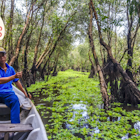
Nov 17, 2023 • 5 min read
Want to go off the beaten track in Vietnam? Follow these recommendations from local travel writers.
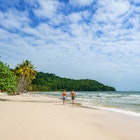
Nov 7, 2023 • 5 min read
Vietnam may not have the reputation for world-class beaches of its neighbours, but it still hides a few crackers.
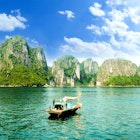
Nov 6, 2023 • 5 min read
From the stunning Halong Bay to the sand dunes of Mui Ne, Vietnam offers up a bewitching array of superlative natural landscapes. Here's our favorite 10.

Aug 14, 2023 • 10 min read
From family beach days to hiking in the highlands, here are the best activities for kids in Vietnam, along with some top planning tips.

Aug 10, 2023 • 6 min read
The process for obtaining a visa for Vietnam can be confusing, but for a short trip, you may not need a visa at all. Here’s what you need to know.

Aug 8, 2023 • 10 min read
One of the many great things about Vietnam is how much you spend is within your control – just choose wisely. Here's how to visit Vietnam on a budget.

Aug 7, 2023 • 10 min read
Vietnam serves up a lavish buffet of Asian sights, sounds, scents and flavors, but there are things to know before you come. Try these tips.
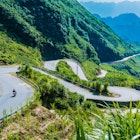
Jul 6, 2023 • 7 min read
Vietnam was made for exploring by road. From the mountains to the Delta, here are our top road trip routes.
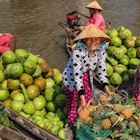
Mar 21, 2023 • 4 min read
Let Elsewhere by Lonely Planet help you explore Vietnam through a culinary lens.

Nov 23, 2022 • 8 min read
Here are eight hikes that showcase the stunning landscapes and enchanting villages of Vietnam.

Oct 14, 2022 • 12 min read
Every day in Vietnam is a feast. Here are the best things to eat and drink, from pho noodle soup to banh mi sandwiches and everything in between.

Mar 31, 2022 • 6 min read
Vietnam has over 30 national parks. Here's our guide to the very best, from underground marvels to golden coastlines.
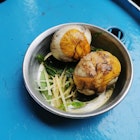
Jun 23, 2021 • 5 min read
It is likely that some traditional Vietnamese dishes will excite the most adventurous but that some tourists find difficult to eat because of its peculiarity.
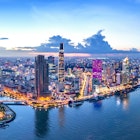
Jan 11, 2021 • 4 min read
Ho Chi Minh City is on a wave of tech development. Here's everything you need to know about being a digital nomad in HCMC.
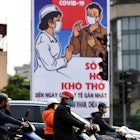
Apr 27, 2020 • 5 min read
When a pair of travelers found themselves in Hanoi as the world responded to the COVID-19 pandemic, they decided to stay put and saw Vietnam's response to the…

Feb 14, 2020 • 5 min read
Make the most of your time in Vietnam with a Lonely Planet Experiences tour in partnership with Intrepid Travel. Meet new people with a local as your guide.

Feb 11, 2020 • 7 min read
Strong and flavourful Vietnamese coffee makes converts as quickly as it raises pulses.

Aug 12, 2019 • 6 min read
There's a lot to love about travelling in Vietnam, which stretches from the soaring mountains and fascinating ethnic groups of the north to the endless…
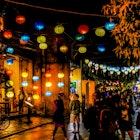
Jul 8, 2019 • 6 min read
Visitors to Vietnam often cite charming Hoi An as one of their favourite cities. A thriving medieval port city that was reduced to a backwater country…
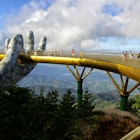
Jun 21, 2019 • 4 min read
You’ve explored the Unesco-heritage centre of Hoi An, spent some time on An Bang beach, seen plenty of arts and crafts, and the new clothes you ordered at…
- Travel Planning Center
- Ticket Changes & Refunds
- Airline Partners
- Check-in & Security
- Delta Sky Club®
- Airport Maps & Locations
- Flight Deals
- Flight Schedules
- Destinations
- Onboard Experience
- Delta Cruises
- Delta Vacations
- Delta Car Rentals
- Delta Stays
- Onboard Wi-Fi
- Delta Trip Protection
- How to Earn Miles
- Ways to Redeem Miles
- Buy or Transfer Miles
- Travel with Miles
- SkyMiles Partners & Offers
- SkyMiles Award Deals
- SkyMiles Credit Cards
- SkyMiles Airline Partners
- SkyMiles Program Overview
- How to Get Medallion Status
- Benefits at Each Tier
- News & Updates
- Help Center
- Travel Planning FAQs
- Certificates & eCredits
- Accessible Travel Services
- Child & Infant Travel
- Special Circumstances
- SkyMiles Help
Travel Requirements Guide
International Travel Requirements
U.s. entry requirements, contact tracing.
Get to Know Delta FlyReady SM
- Investor Relations
- Business Travel
- Travel Agents
- Comment/Complaint
- Browser Compatibility
- Accessibility
- Booking Information
- Customer Commitment
- Tarmac Delay Plan
- Sustainability
- Contract of Carriage
- Cookies, Privacy & Security
- Human Trafficking Statement (PDF)
You are using an outdated browser. Please upgrade your browser to improve your experience.
Vietnam's National Administration of Tourism (VNAT) offers an e-brochure for first-time travellers to Vietnam. The 'Beginner's Guide to Vietnam Now' provides a clear first level of introduction to the country and basic insight on travelling in Vietnam.
For viewing and downloads, please click here .
Beginner's Guide to Vietnam Now - Downloadable Starter Kit
Create an account.
Already have an account? Click here to sign in
By clicking submit, you agree to our Privacy Policy and Terms of Use
Sign in with your social accounts
Sign in with your email
Forgot password? Click here to get it back
Don't have an account? Sign up here
Forgot Password
The entered email has subscribed for Vietnam Tourism monthly newsletter
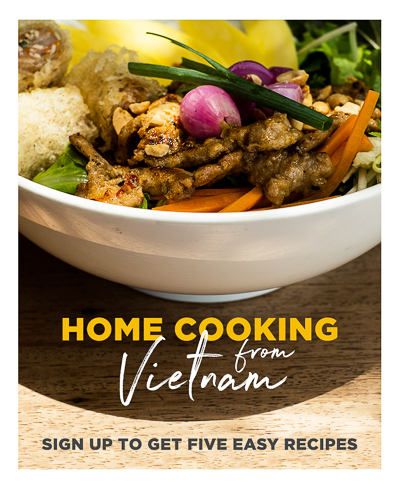

IMAGES
VIDEO
COMMENTS
There's a lot to love about travelling in Vietnam, which stretches from the soaring mountains and fascinating ethnic groups of the north to the endless rice paddies and vibrant waterways of the Mekong Delta in the south, with more than 3000km of glorious coastline in between. Throw in a good transport infrastructure of buses, trains and flights ...
May - November. Northern Vietnam - The best months to travel Northern Vietnam are April to May or September to October. There are mostly sunny days and the rain has stopped. The weather gets really cold from December to March and is not suited for hiking or sailing a junk boat in Halong Bay that time of year.
Live fully in Vietnam. Vietnam opens its door widely to welcome visitors all around the world! Starting from 15th August 2023, Vietnam extends e-visa validity to 90 days and unilateral visa exemption will be valid in 45 days! We are more than happy to welcome you all here and admire our stunning landscapes, free your soul on white sandy beaches ...
How to travel responsibly in Vietnam Beginner's guide to Vietnam now 5 reasons to try a homestay in Vietnam EXPLORE FROM HOME. Explore Vietnam more from home and start planning your holidays. Fun at Home Recipes, colouring sheets, and more ; Books, Art & Music A primer on Vietnamese culture; My Vietnam Local stories from north to ...
Costs of Traveling in Vietnam. Travel on a budget in Vietnam, from $110 − $240 USD weekly per person, mid-range $280 − $830 USD, and high-end from $750 − $1250 USD. However, costs depend on factors like accommodation, transportation, and activities. We did not include flights. Check flight prices here.
Vietnam is a country with a countless of destinations to explore, and this Vietnam travel guide highlights some of the most popular ones. North Vietnam 1. Hanoi. Hanoi, the capital city of Vietnam, is known for its rich history, vibrant culture, and bustling street life. Visitors come to explore its charming Old Quarter, taste delicious street ...
How to Apply for Vietnam's e-Visa: Step 1: Prepare the required materials. Step 2: Open the official website for Vietnam's e-Visa Application. Step 3: Upload your .jpg images (passport data page and passport photo) and fill out the required fields on the form.
A Travel Guide to Vietnam with ️ Travel Itineraries, ️ Top places to visit in 2024, ️ Best Cities, and more! Vietnam. Travel Guide. Where street food rules, the history is rich, and breathtaking landscapes are some of the world's best. Itineraries; Best places; Map;
Vietnam Travel Guide. Last Updated: April 29, 2024. From the stunning views of Sam Mountain and Ha Long Bay to the man-made artistry of the sacred temples and pagodas to the rice terraces and beaches, Vietnam is stunning. There's no denying that backpacking Vietnam (or simply traveling here on a vacation) is an experience filled with natural ...
Street Food Tips. Get ready to enjoy Vietnam's amazing street food during your stay. The best stalls only open a few hours each day: 6am to 8am, 11:30am to 1pm, and. Season to taste. ietnamese use chili, umuats, vinear, and fish sauce to adust the taste of 5:30pm to pm. each dish to their liin.
This is the official travel guide website of Welcome to Vietnam, which gives you the most necessary and clear information about Vietnam tourism. back to top. Be Inspired. #Trending. 10 best places to visit in Vietnam in 2024. April 20, 2024. #Trending. 20 Best Things to Do in Vietnam. April 8, 2024 ...
Take a boat trip through the limestone tunnels and between karst hills to the three long, tunnel caves at Tam Coc itself. 4. Hue. Travel to the engaging city of Hue and take a day-long boat trip along the Perfume River to visit the Thien Mu Pagoda and Hon Chen Temple, the Imperial City, and the Tu Duc mausoleum.
VIETNAM TRAVEL GUIDE CONTENTS. At a Glance | Trip Planning | Things to Do | What to Eat | Places to Stay | Latest. At a Glance. Given its historic past, Vietnam is a country that offers a unique perspective for travelers. Blessed with an insanely diverse landscape, you could be sliding down sand dunes in the morning, taking a stroll by the ...
Looking for an in-depth Vietnam travel guide?. Then you're in the right place! Thanks to its stunning natural beauty in places Ha Long Bay and the Mekong Delta, bustling cities with incredible street food, and fascinating culture and history, Vietnam is an unmissable destination in Southeast Asia.. It's also extremely affordable, and visitors will find that their money stretches far in ...
The menu offers artisanal cheeses and high-end charcuterie, as well as a mix of neat jams and other items from various provinces in Vietnam. The coffee is well-priced and equivalent to any place in town. The meals are a bit more dear, with most things starting at 100,000+ dong per dish.
9. Hanoi. Hanoi - the capital, is Vietnam's important cultural, political, commercial, and tourist center. Over a thousand years of history, Hanoi has become a famous tourist destination in the world. Hanoi attracts tourists by its ancient beauty, historical colors, and hospitality from local people.
Vietnam Travel Guide: Customize a Personalized Trip Vietnam is a country full of vibrancy, diversity, and cultural richness, boasting gorgeous landscapes and delectable cuisine. It offers a splendid array of activities and experiences to discover, whether you're traveling with children or enjoying a romantic getaway with your partner.
Vietnam Itinerary and Travel Guide. This Vietnam itinerary is all you need to have a wonderful time in the vibrant South-east Asian nation. It is easy to fall in love with Vietnam. This is a country steeped in stunning natural beauty and offering a stark contrast of civilisations - from cosmopolitan mega-cities to hill tribes and wooden houses.
Bike rental - Cycling is one of the best ways to see Nha Trang. You can rent a bike for just as little as 25,000 VND while scooters and motorcycles start at around 100,000-150,000 VND per day. Taxi - Taxis start at 13,000 VND and go up by around 16,000 VND per kilometer.
A beginner's guide to www.vietnam.travel. www.vietnam.travel Hanoi Ha Long Bay Hue Hoi An Sapa Phong Nha Da Nang Nha Trang Mekong Delta Ho Chi Minh City Magnificent mountain trekking, ethnic ... www.vietnam.travel Street Food Tips 1 Get ready to enjoy Vietnam's amazing street food during your stay. 2 3 4 Eat on local time
1 Ba Be Lake. Shutterstock. A traditional boat on a lake in Ba Be National Park. Visiting this spot is one of the off-the-beaten-path things to do in Vietnam. Found in the northeastern province of Bac Kan, approximately 230 kilometers from Hanoi, Ba Be Lake is among the largest natural freshwater lake in Vietnam.
Children traveling to the U.S. All children, including infants, must have their own travel documents such as a passport or document from a Trusted Traveler Program to enter the U.S. If you travel or are going to travel with a child, consider taking the following documents: If the child is traveling with only one of their custodial parents, they ...
Backpacking Europe Suggested Budgets. Prices for travel in Europe vary greatly depending on how far north, east, south, or west you travel. If you stick to the budget accommodations, food, and tours listed here and use all my tips on saving money, you need about 65-110 EUR per day in Western Europe, 40-50 EUR in Eastern Europe, and about 85-130 EUR in Scandinavia.
Vietnam Travel Stories. Travel Stories. Festivals, beach time, hiking in the highlands: pick the right time for your visit to Vietnam with this seasonal guide. From cutting through the countryside to connecting cities, these 24 railway journeys offer entirely new perspectives on a destination.
Unveiling Japan's Magic: A Season-by-Season Travel Guide for Travelers An article that details itineraries for key cities in Japan for the four seasons of winter, spring, summer, and autumn. 5 Jun 2024 Things To Do Your Guide to the Best Disneyland Locations in the World Go on a magical journey around the world and create memories at Disneyland ...
International Travel Requirements. For travel from the United States (U.S.), make sure you have all required travel documents, including any visas and a valid passport. Find out more about your destination's entry requirements using our interactive Delta Discover Map.
The 'Beginner's Guide to Vietnam Now' provides a clear first level of introduction to the country and basic insight on travelling in Vietnam. For viewing and downloads, please click here. Vietnam's National Administration of Tourism (VNAT) offers an e-brochure for first-time travellers to Vietnam.
A U.S. Senate resolution from the 115th Congress recognizing the 2017 Hispanic Heritage Month stated Hispanic Americans suffered 5.5% of Vietnam War deaths and made up 4.5% of the general U.S. population. Approximately 42,000 Native Americans served in the Vietnam War, continuing a long tradition of serving in the U.S. military.